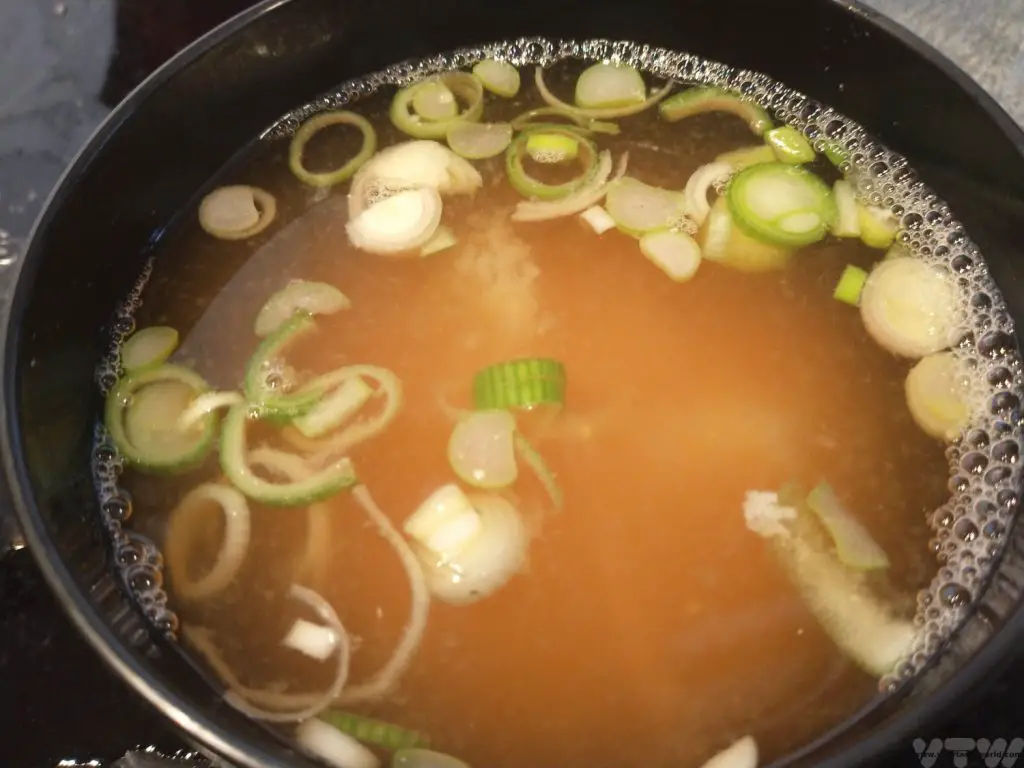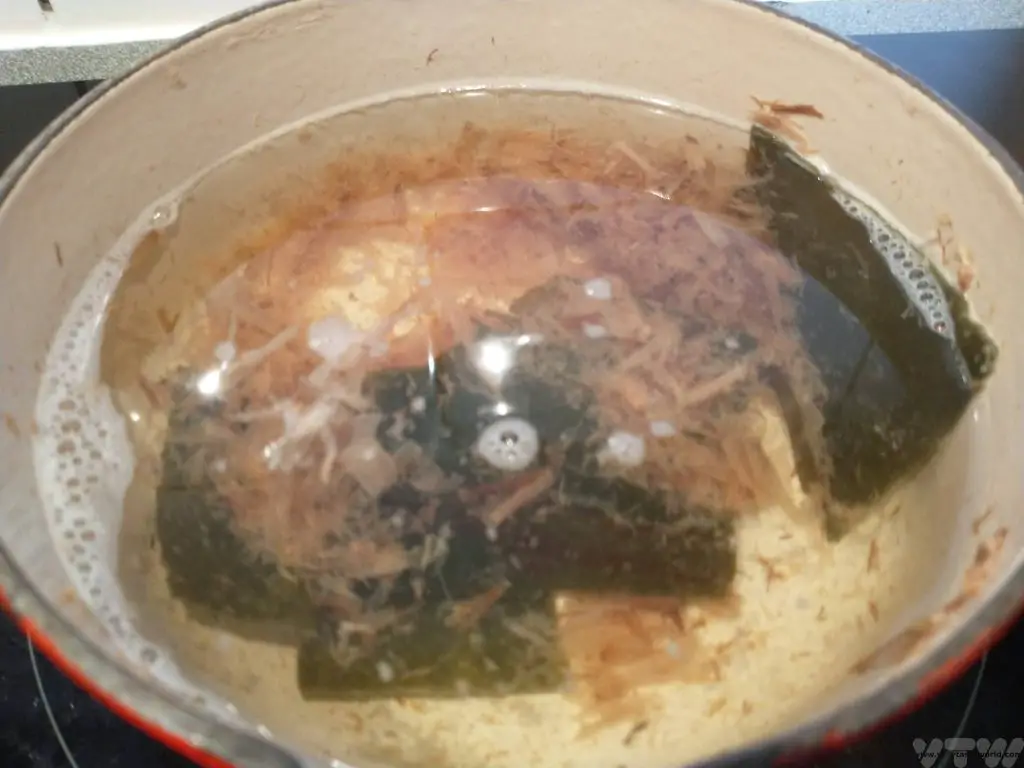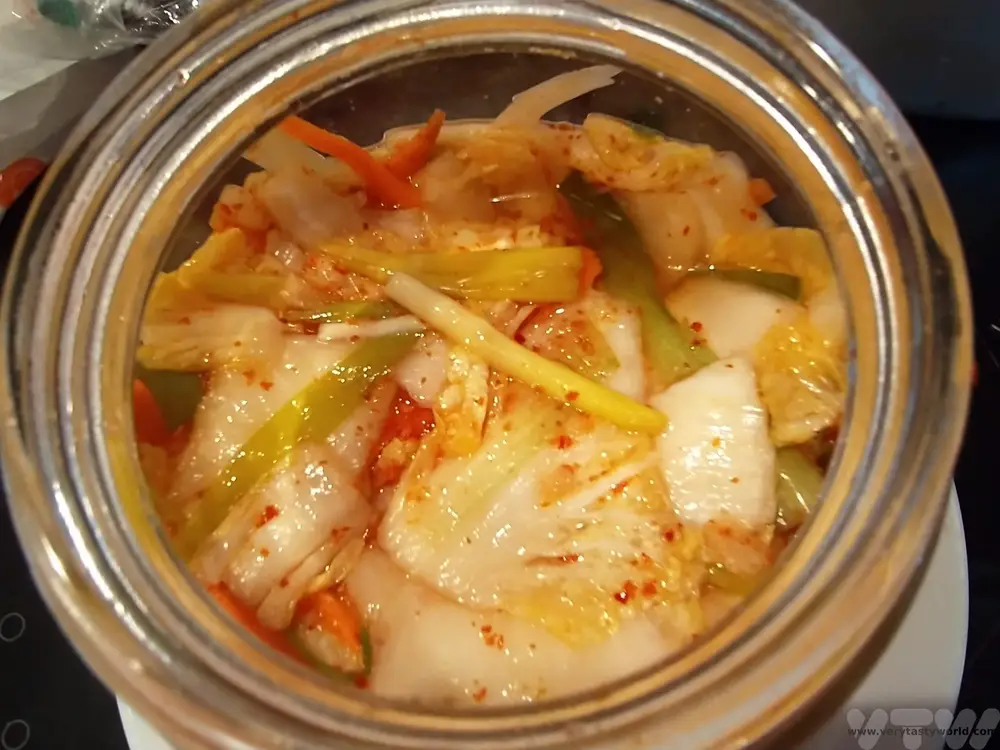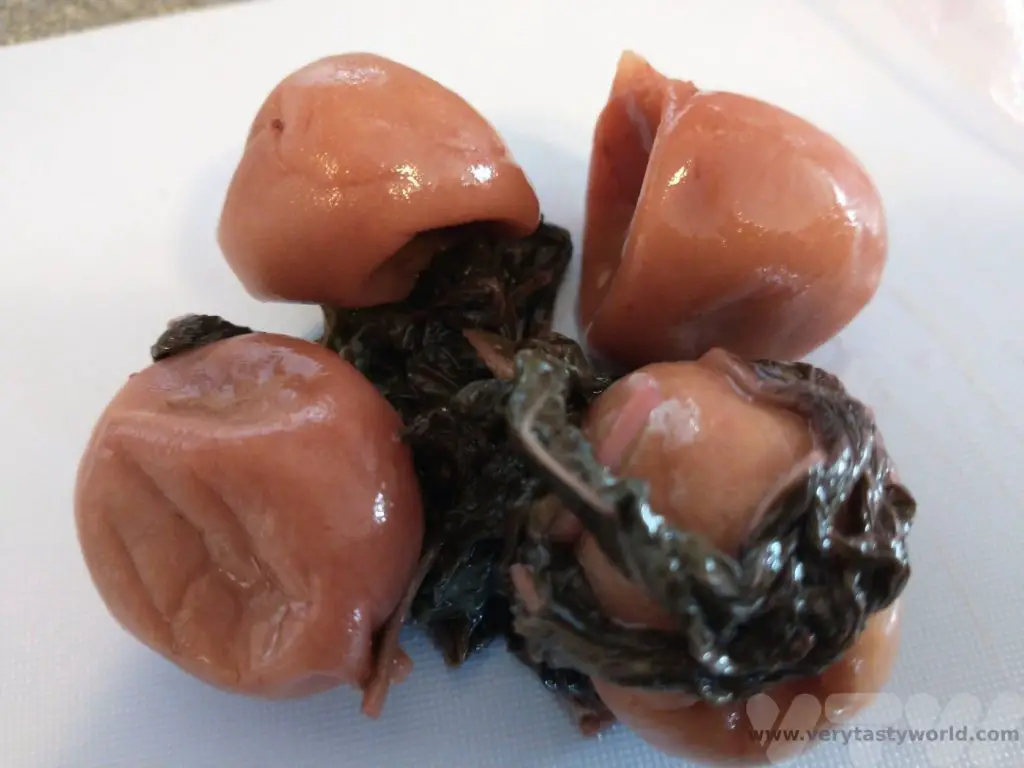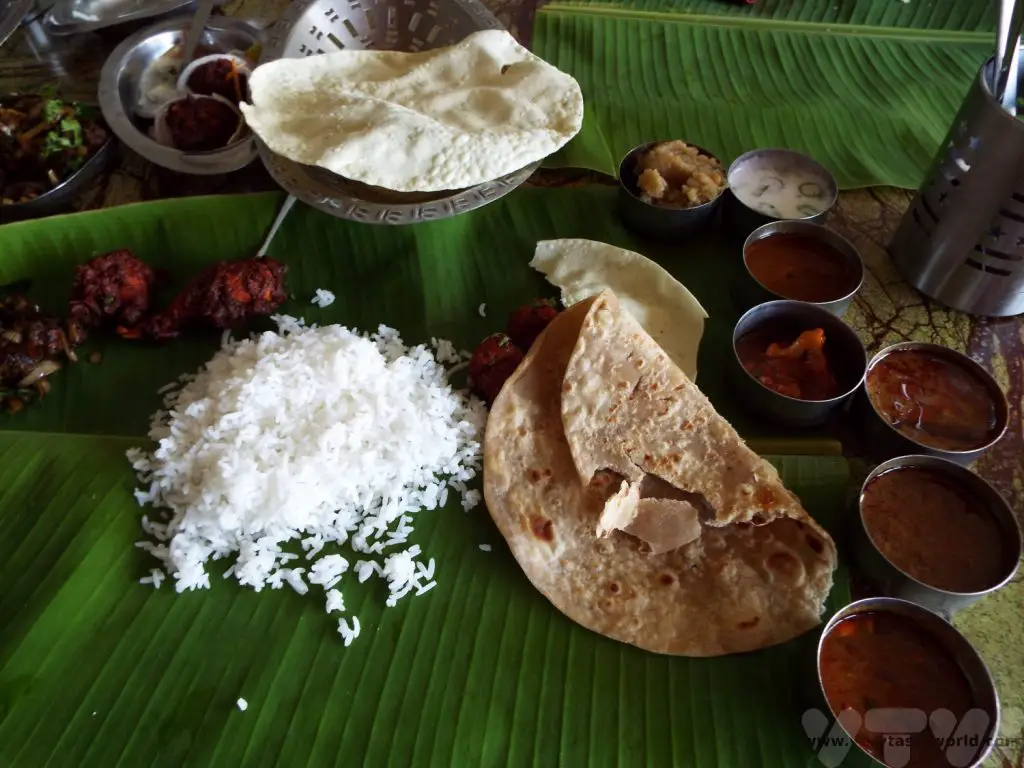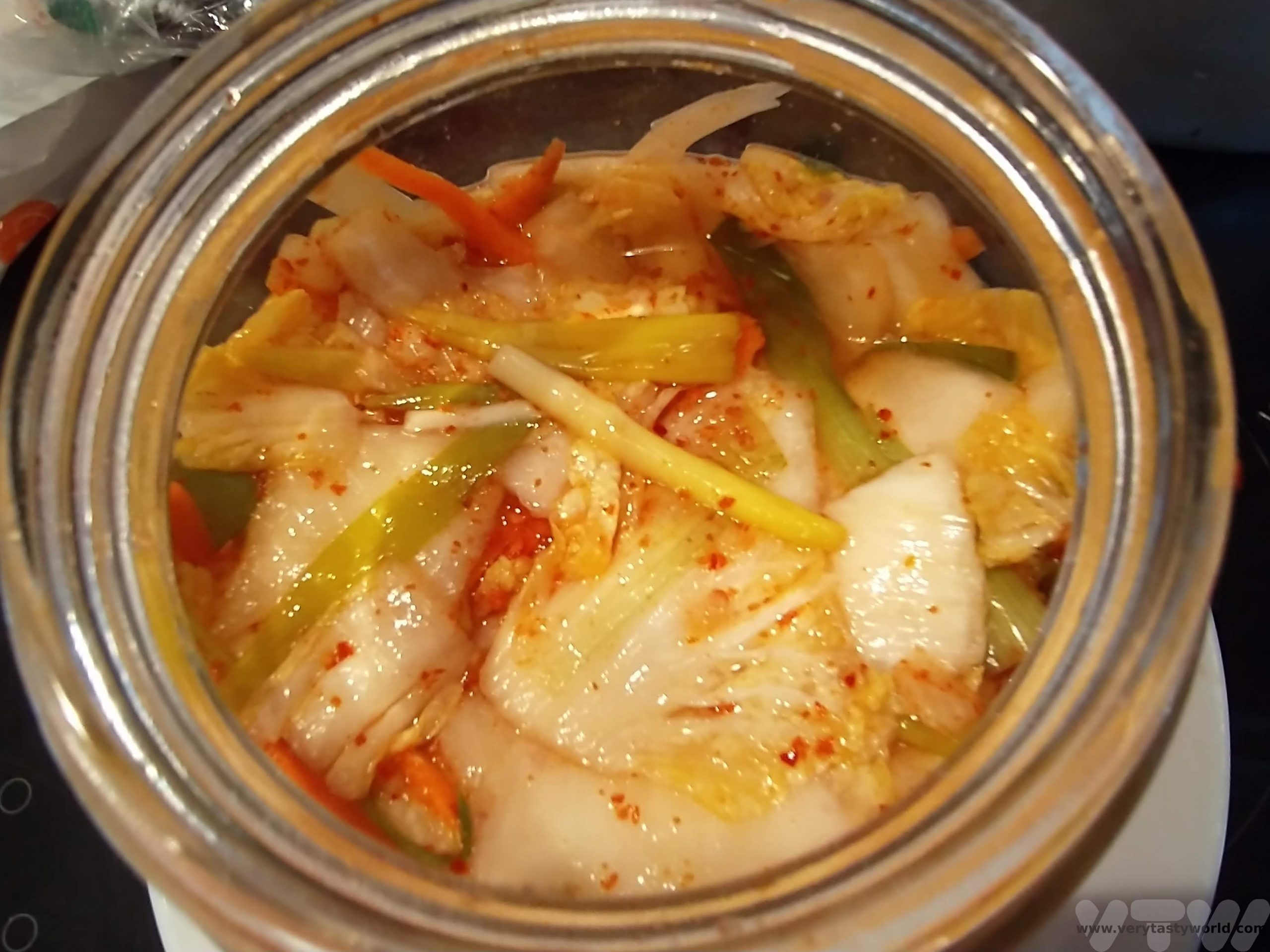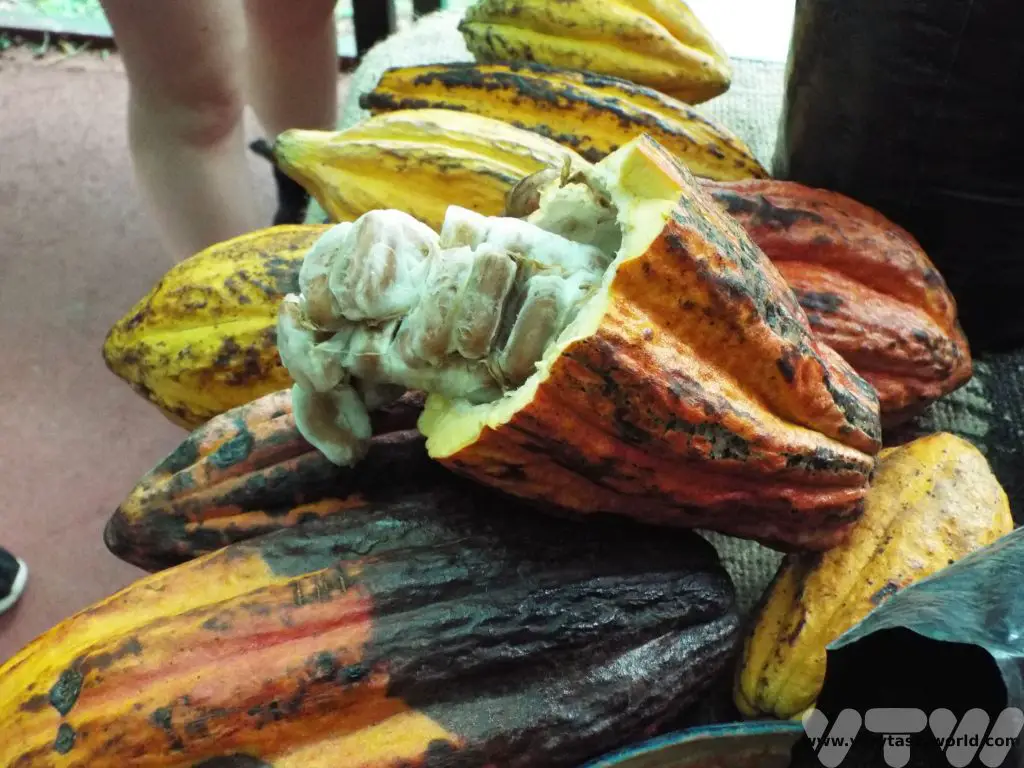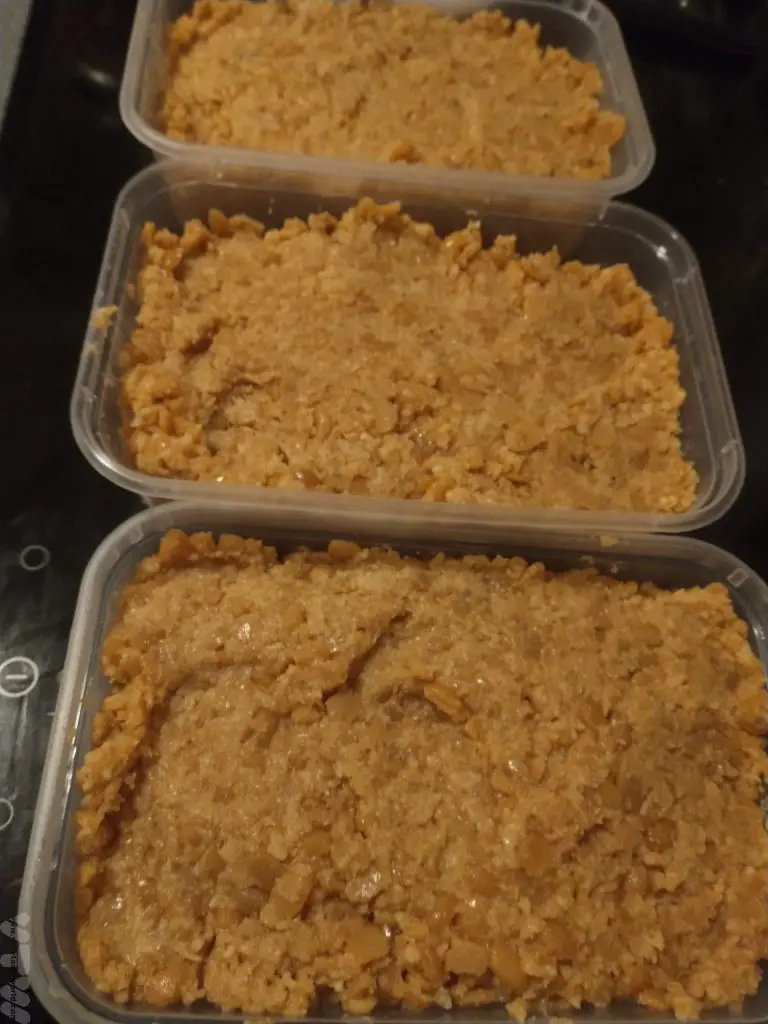Home » Posts tagged 'recipe'
Tag Archives: recipe
Recipe: Simmered Shiitake Mushrooms
Shiitake mushrooms are native to Asia but have become popular all over the world because they are versatile and packed with flavour. They are particularly popular in Japanese cuisine and have a variety of uses. They apparently have some medicinal properties but, more importantly, they are absolutely delicious. We have a fantastic recipe for simmered shiitake mushrooms which can be used as a side dish for many Japanese meals.
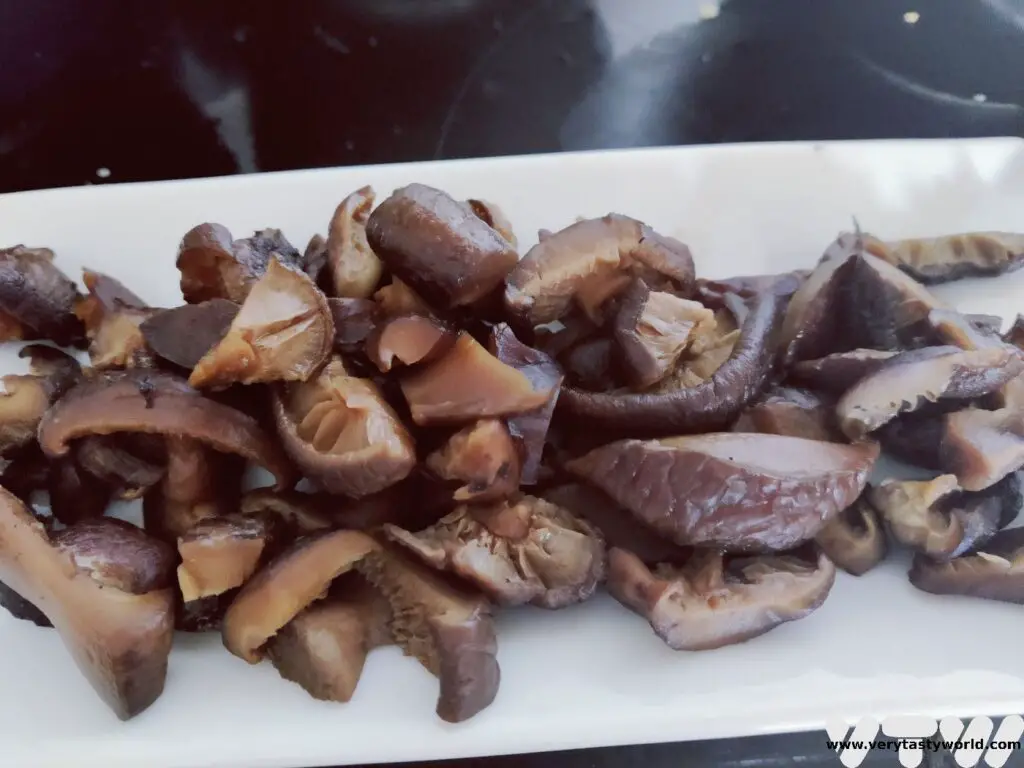
Shiitake can be used as a key ingredient for dashi – Japanese stock – which is used in many traditional dishes, including miso soup. Dashi often uses shaved bonito (a type of fish) flakes but this can be substituted for shiitake mushrooms, complemented with kombu seaweed, to make a flavoursome vegetarian/vegan dashi.
This recipe for simmered shiitake mushrooms is used as a side dish to accompany a wide variety of foods. It is packed with umami flavour which complements the sweetness of the mirin and the saltiness of the soy sauce.
This simmered shiitake dish is very simple to make but requires a little – minimal – preparation as you will need to presoak the mushrooms. Ideally, we recommend soaking the mushrooms overnight as this will allow maximum umami. If you can’t soak overnight, we suggest a minimum of five hours. Also, make sure that you save the water the mushrooms have been soaked in as that is packed with flavour.
How To Make Simmered Shiitake Mushrooms
Ingredients
100g grams dried whole shiitake mushrooms
1 tbs soy sauce
1 tbs mirin (if you can’t get mirin you can use 1 tbs cooking sake and 1 tsp sugar and if you can’t get cooking sake use 1 tbs white wine and 1 tsp sugar)
Water to cover the mushrooms
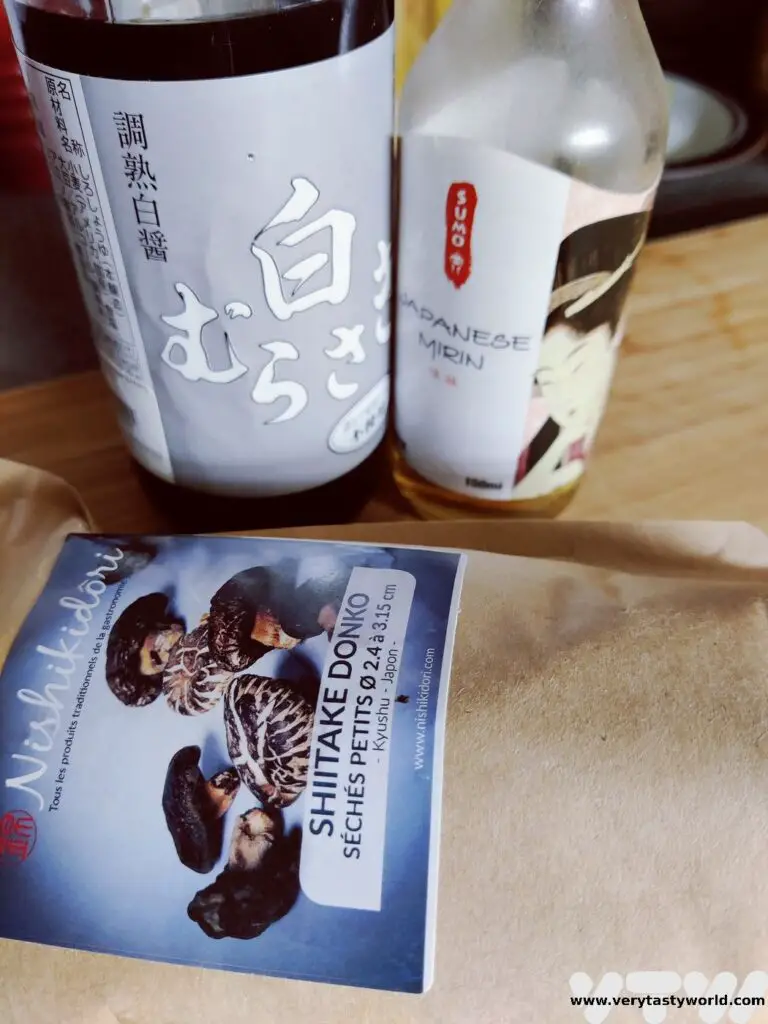
Method
Place the dried mushrooms into a bowl and cover – just to the top of the mushrooms – with water. Soak the dried mushrooms until they are soft. Ideally a minimum of 5 hours, overnight is better. Save the water!
Remove the mushrooms from the water. They should have turned from woody to plump and juicy. Take off the stems if you wish and cut into slices.
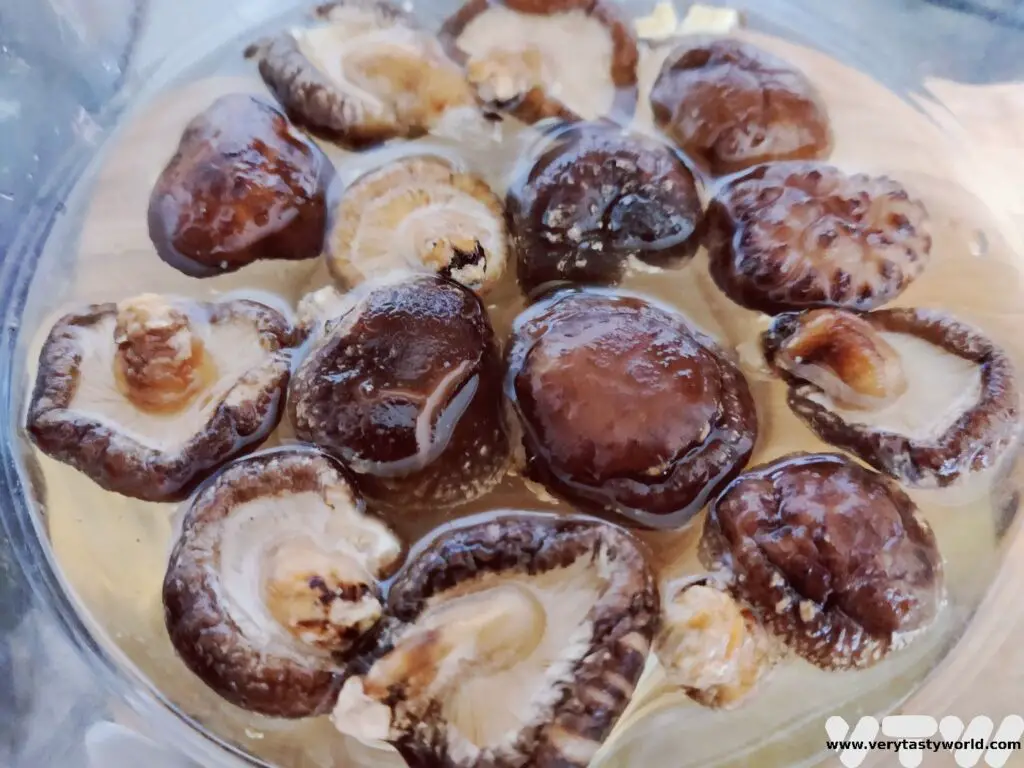
Put the mushrooms into a pan.
Add 1 tbs mirin and 1 tbs soy sauce.
Then add the mushroom water to just about cover them. Be careful as there may be a little bit of residue at the bottom of the water bowl, don’t let that go in.
Bring the mushrooms to a simmer until the water has evaporated. This will take about 15 mins.
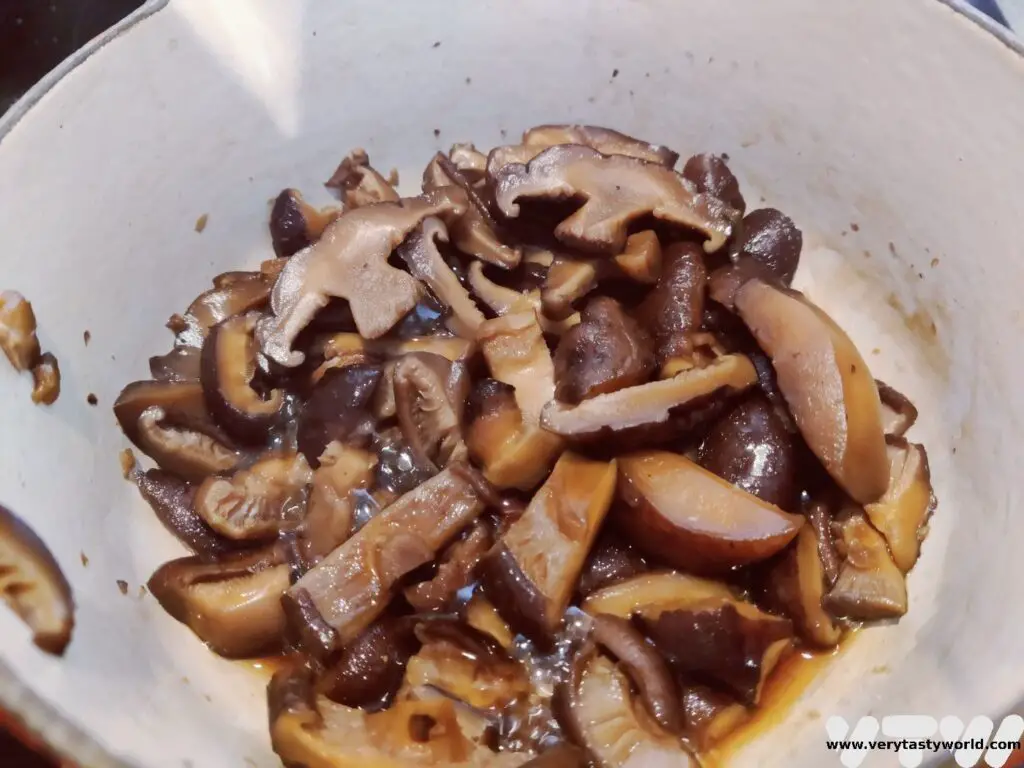
Allow to cool and serve cold.
We often use these as a side to accompany a number of dishes – great eaten in the summertime with cold somen noodles, agedashi tofu (fried tofu), vinegared wakame (seaweed) and cucumber salad, and shira ae (mashed tofu and carrot salad).
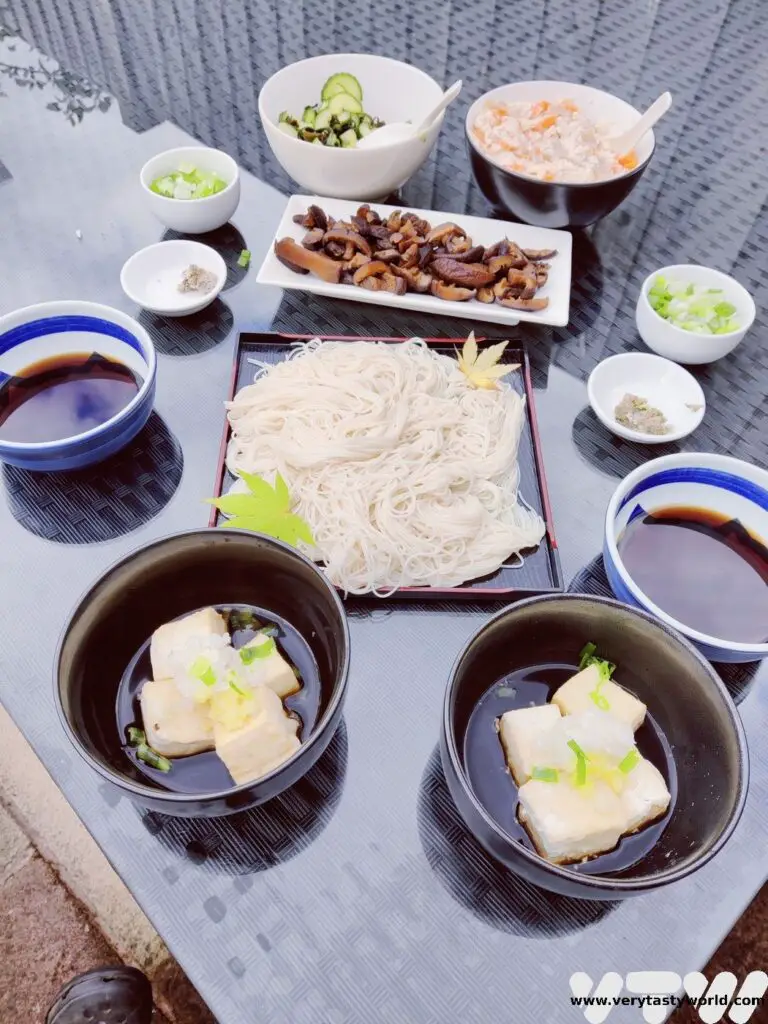
Related Posts You May Enjoy

- RECIPE Oyakodon Donburi
- Zero Waste Recipes Before Your Holiday
- RECIPE: Vegetable Biryani Tamil Nadu Style
- RECIPE: Vegan Wild Garlic Pesto
- Recipe: Venetian Pasta Sauce
- RECIPE: Biryani Raita Recipe
- RECIPE: How to Make Costa Rica’s Gallo Pinto
- Recipe: Japanese Simmered Pork Belly – Buta no Kakuni
- RECIPE: How to Make Umeboshi

- Recipe: Simmered Shiitake Mushrooms

- How to Use Public Transport in Japan

- RECIPE Oyakodon Donburi

- Planning a Trip to Japan

- The Makanai: Cooking for the Maiko House

- Setsubun Food – Bean Throwing Day

- The Gassho Farmhouses of Rural Japan

- Recipe: Japanese Simmered Pork Belly – Buta no Kakuni

- RECIPE: How to Make Umeboshi

RECIPE: Vegetable Biryani Tamil Nadu Style
Biryani is a delicious aromatic spicy rice dish that is a meal in itself. Eaten all over India, it is also very popular in Tamil Nadu, the south eastern state which runs from Chennai in the north, all along the Bay of Bengal to Kanyakumari in the south. We visited this brilliant state a couple of years ago and were not only inspired by wonderful places to visit but also the deliciousness of south Indian cuisine. And we have a recipe for vegetable biryani Tamil Nadu style.
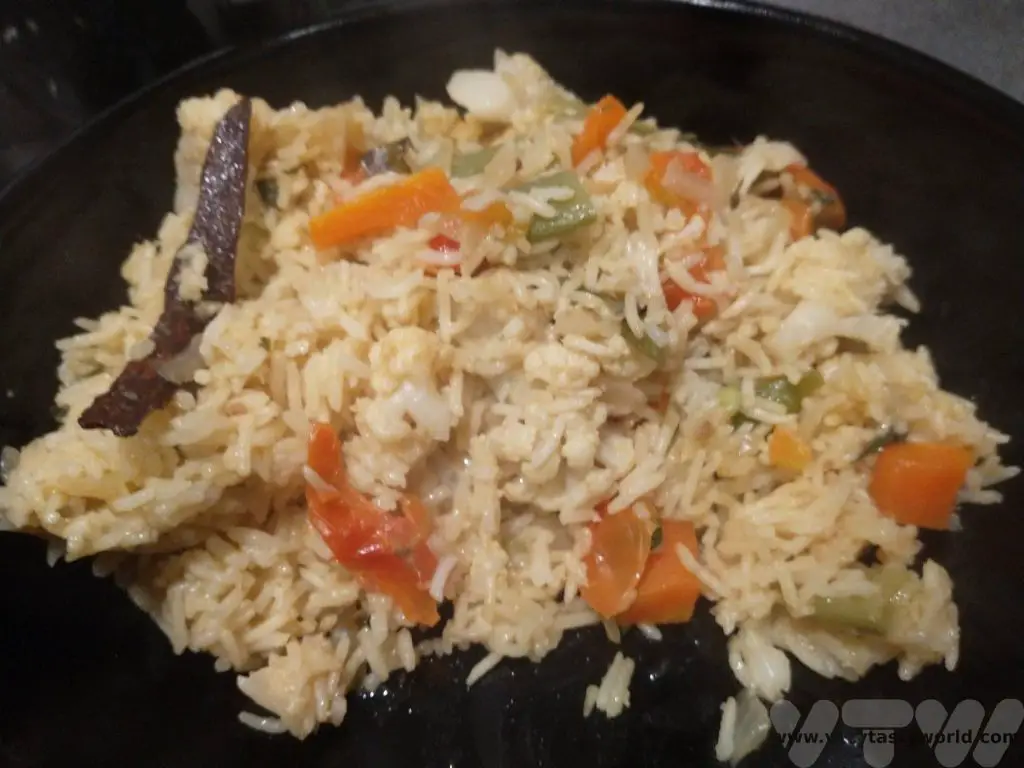
Although biryani is best known as a dish from India it is thought that it probably originated in the Middle East. The Persian word ‘birinj biriyan’ means ‘fried rice’. The cuisine of the Mughals, who ruled much of South Asia between the 16th and 19th centuries, had a significant influence on Indian food. The Mughals also introduced ingredients, such yoghurt, and also the ‘dum’ technique of cooking the dish over a low heat in a sealed pot which helps retain all the flavours as the food cooks.
This recipe comes from Tamil Nadu courtesy of our dear friend, Shankari. We were lucky to be gifted a traditional Indian pressure cooker which is absolutely perfect for cooking this delicious biryani but we have adapted and tested the recipe for a standard hob top pan as well. We often use a rice cooker to cook rice but we find it really doesn’t work very well with biryani because you are sautéing spices and vegetables beforehand and the rice is layered on top of these. A rice cooker can do this to some extent but not really enough to properly cook the spices.
Many people in Tamil Nadu are vegetarian so this dish contains no meat. When we visited this region every restaurant offered both a veg and non-veg meal option. This biryani could easily be adapted to include lamb or chicken but we love the simplicity of the vegetables and it is so tasty, you really don’t miss the meat. The spice combinations are warming and aromatic. If you wish to make the dish vegan, fry the ingredients in oil and omit the yoghurt.
The process involves cooking whole spices first to release their oils and to maximise the flavour. We leave the whole spices in the finished biryani but they aren’t really designed to be eaten – they won’t harm you if you do but you might get an overly intense hit of flavour if you chomp on a clove!
The quantities here will serve 2 hungry people but you can double up to feed more people, or you can use these quantities if you are accompanying the biryani with other dishes. We use a cup that is around 200ml in volume.
How To Make Vegetable Biryani from Tamil Nadu
Ingredients:
1 bay leaf
1 stick of cinnamon
3 green cardomom pods
3 cloves
2 tbs mint leaves
2 tbs coriander leaves
½ teaspoon red chilli powder
½ teaspoon coriander powder
1/8 teaspoon turmeric powder
½ teaspoon garam masala
1 cup of Basmati rice
2 tbs ghee or butter (use vegetable oil for a vegan biryani)
Small, finely chopped tomato
2 tbs natural yogurt
1 tsp ginger garlic paste (you can buy this frozen or in jars, or you can crush 2 cloves of garlic and a thumb of ginger in pestle and mortar)
1 green chilli (add another if you like spice)
Chopped vegetables (anything you like but beans, carrot, peas and cauliflower work really well)
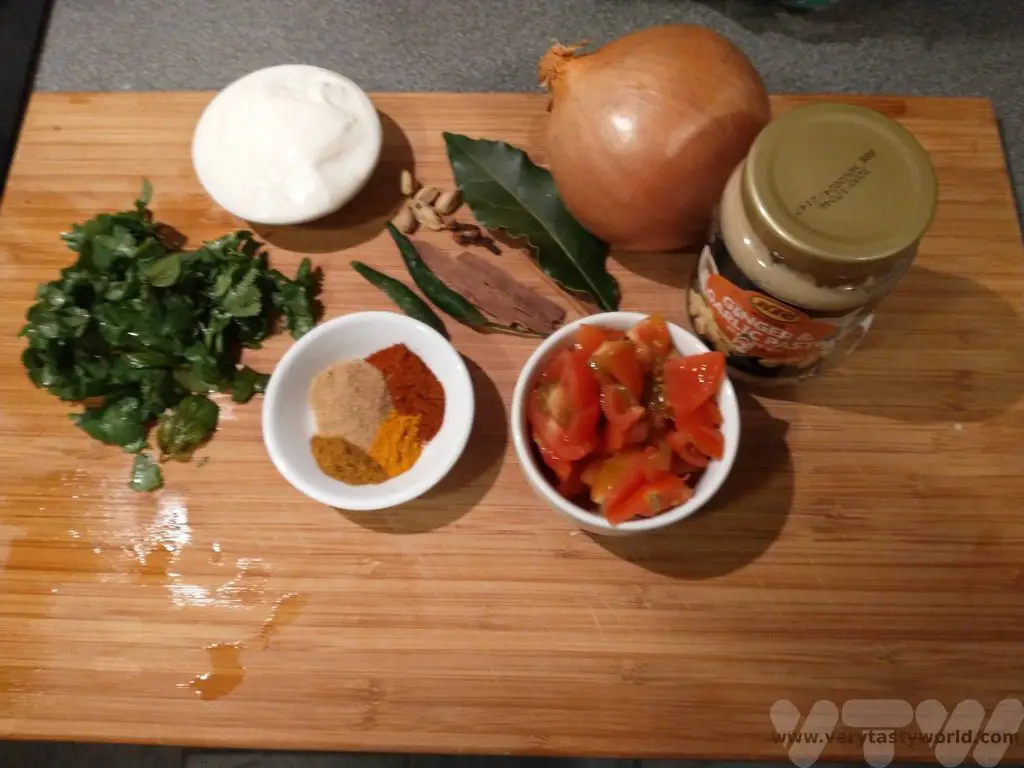
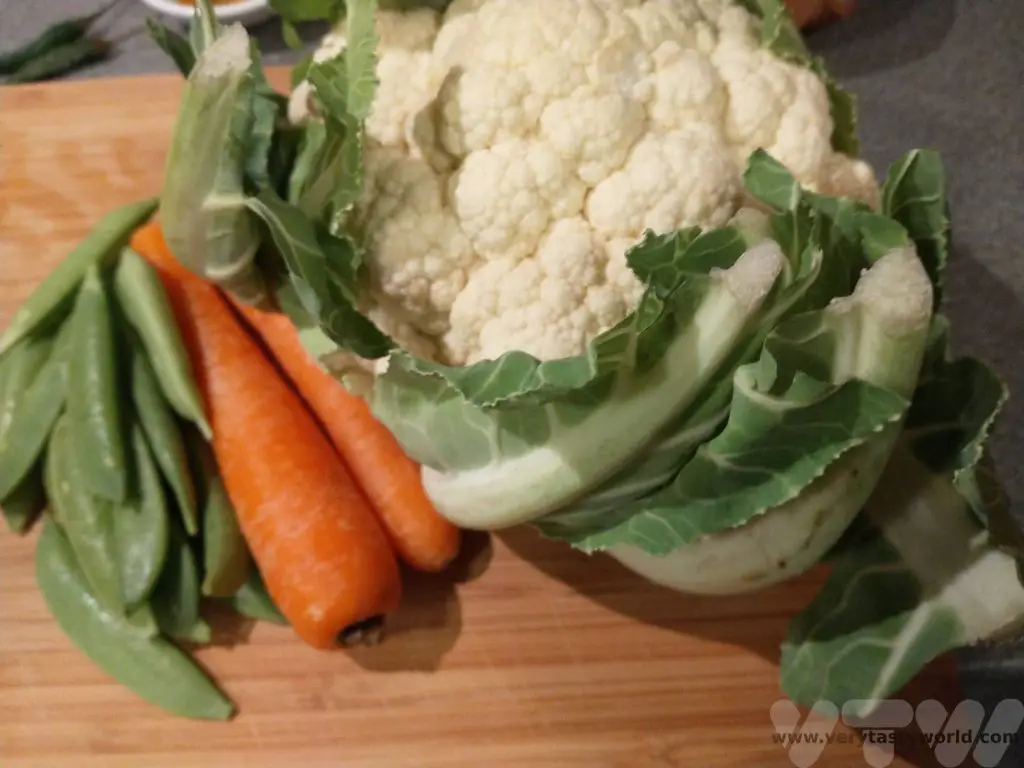
Method:
Add 1 cup basmati rice to a bowl and soak it in water for 30 minutes.
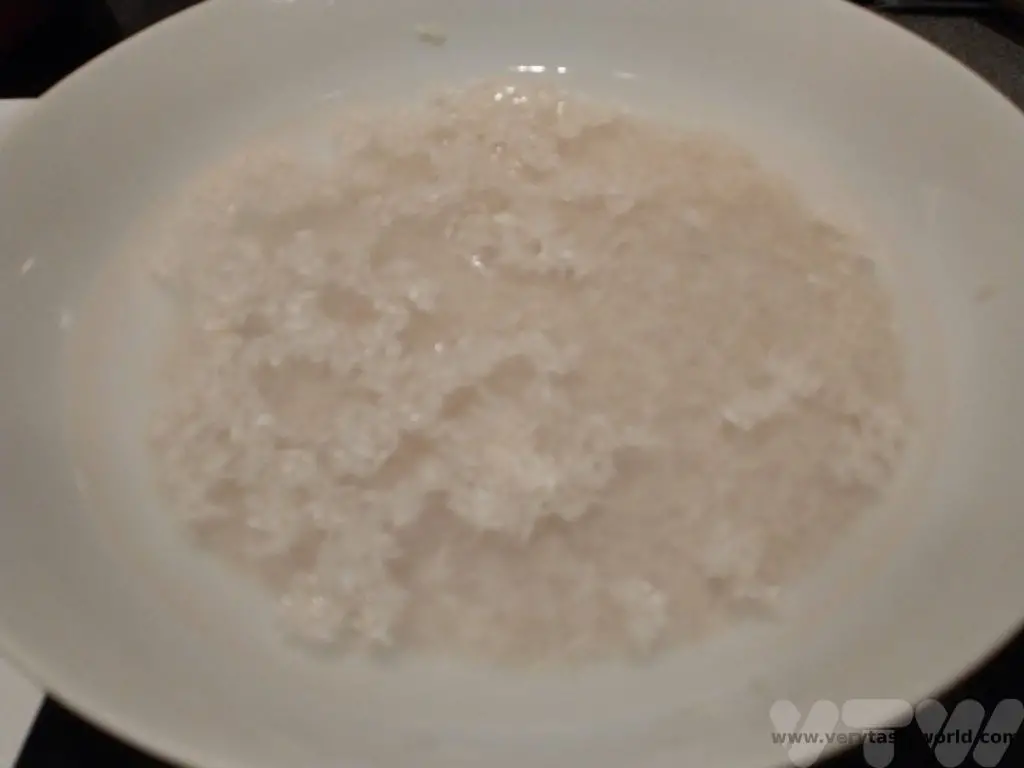
Heat 2 tablespoons oil or ghee or butter in a pot or pressure cooker.
Add whole spices:
1 bay leaf
1 inch cinnamon
3 green cardomom
3 cloves
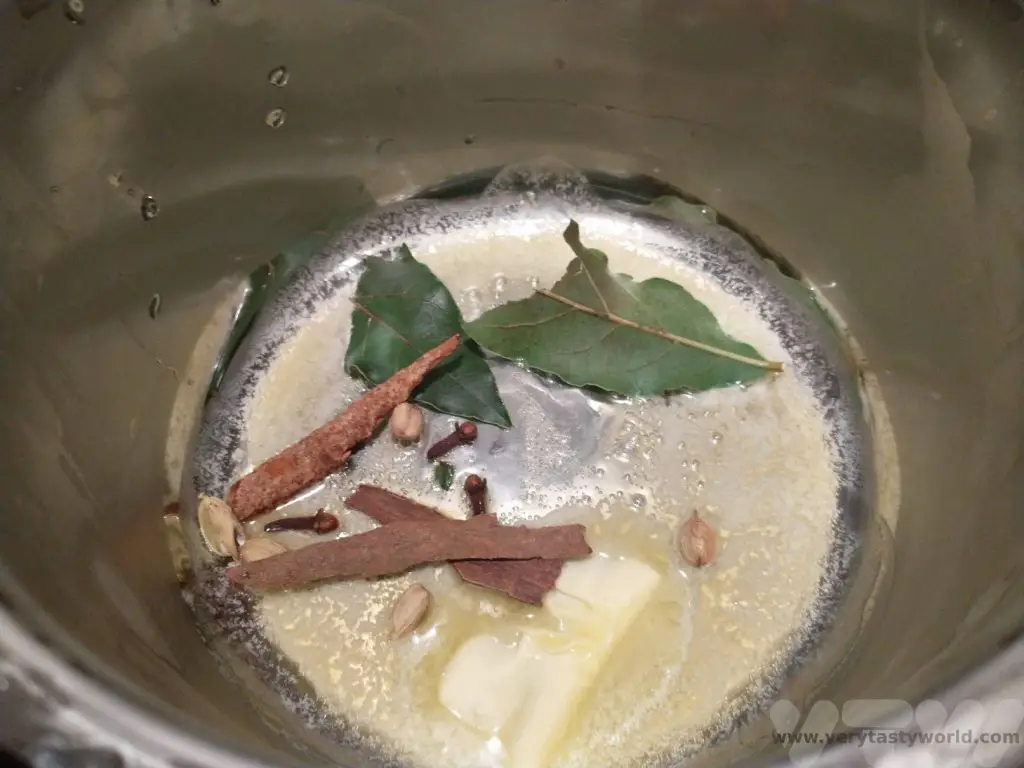
When the spices, begin to crackle, add 1 sliced onion and 1 chopped green chilli. On a medium heat, sauté until the onions turn golden.
Add 1 teaspoon ginger garlic paste. Sauté this for a couple of minutes until the raw smell goes away.
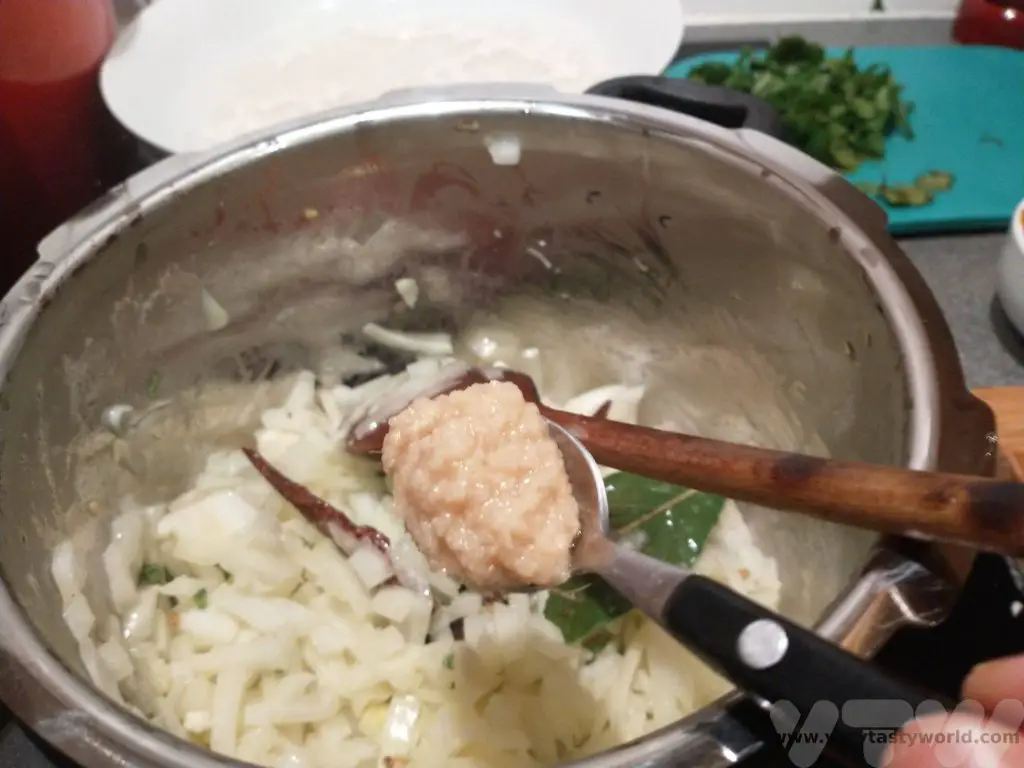
Add 1 cup chopped mix veggies and sauté on a medium heat for 2 -3 minutes.
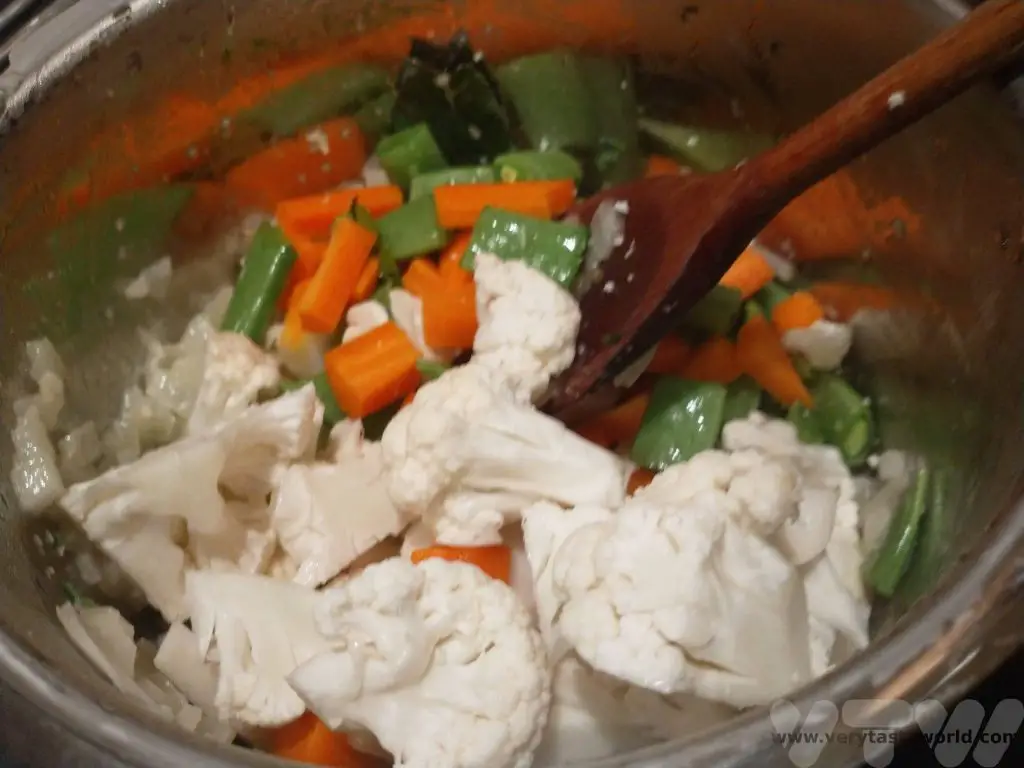
Add the following:
2 tablespoons mint leaves
2 tablespoons coriander leaves
½ teaspoon red chilli powder
1/2 teaspoon coriander powder
1/8 teaspoon turmeric powder
½ teaspoon garam masala
1 small finely chopped tomato
2 tablespoons of yogurt
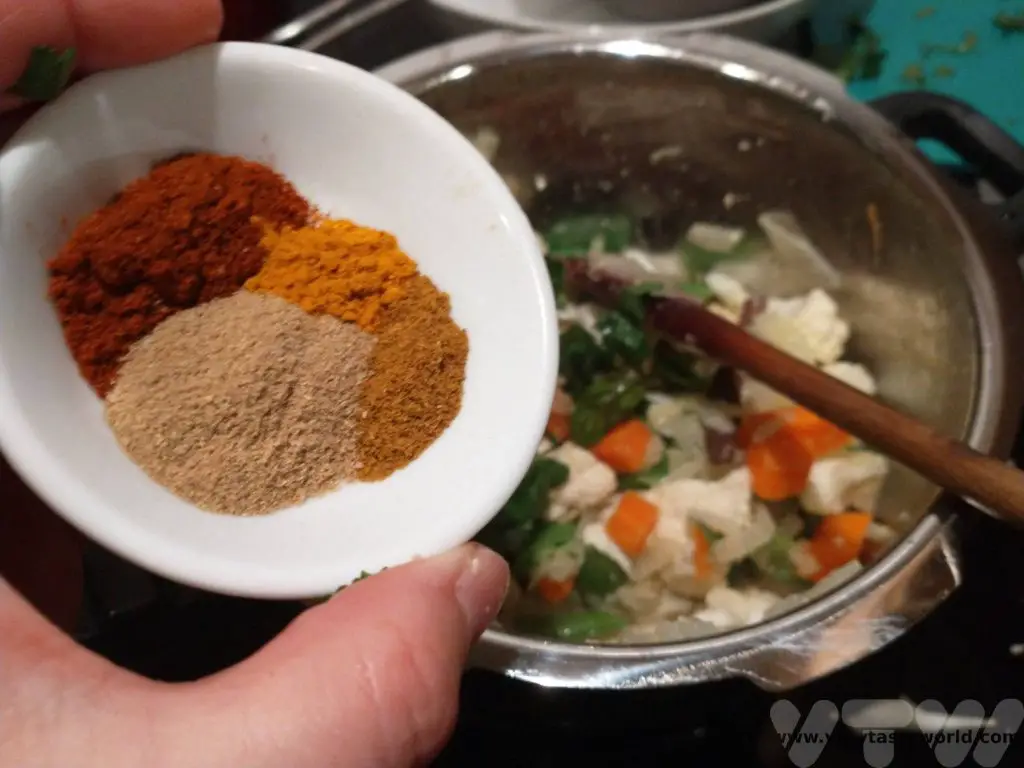
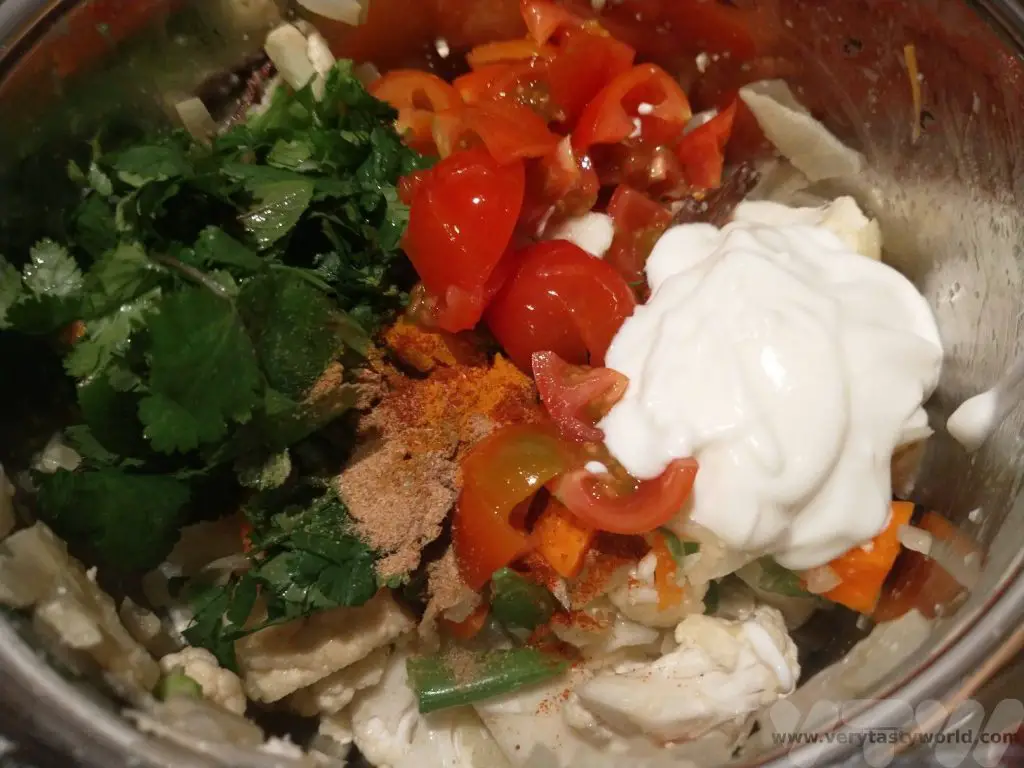
Mix and fry again for 5 minutes on a medium heat until the tomatoes break down. The mixture turns aromatic after frying.
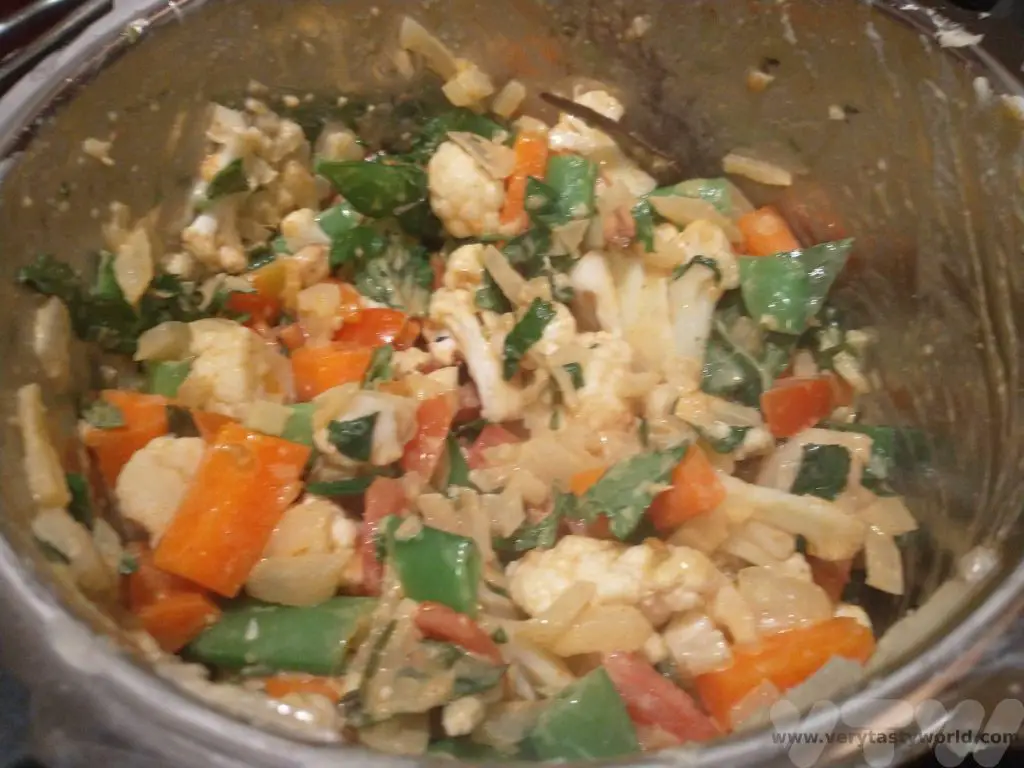
Add the drained rice and spread it evenly across the top of the mixture.
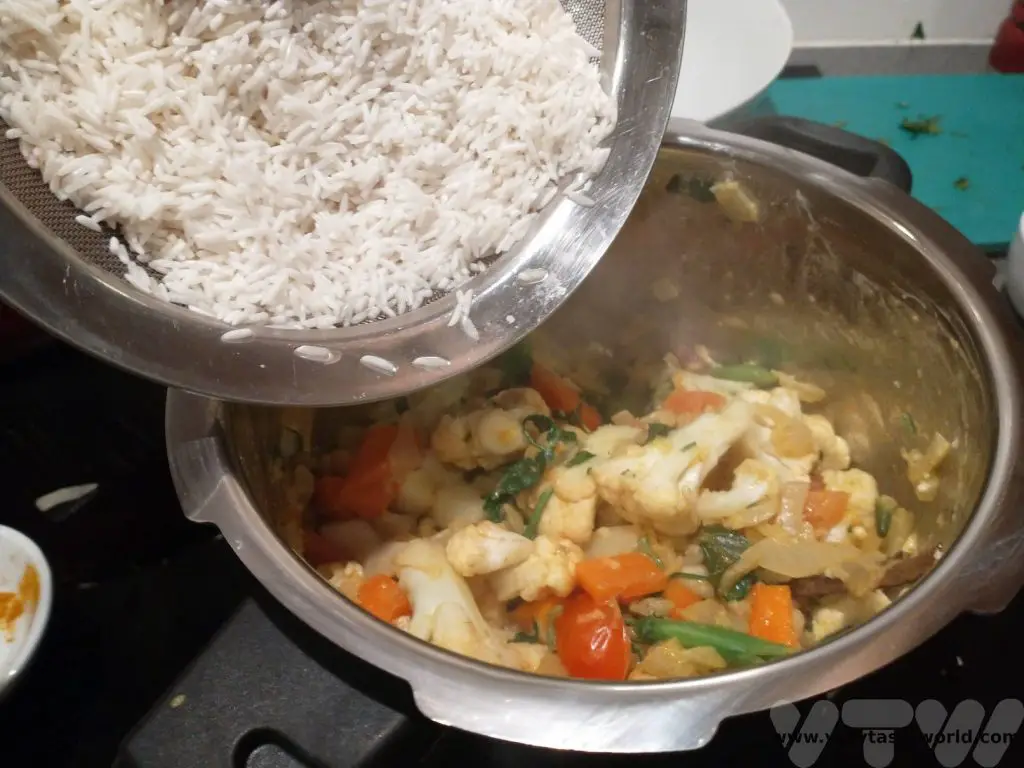
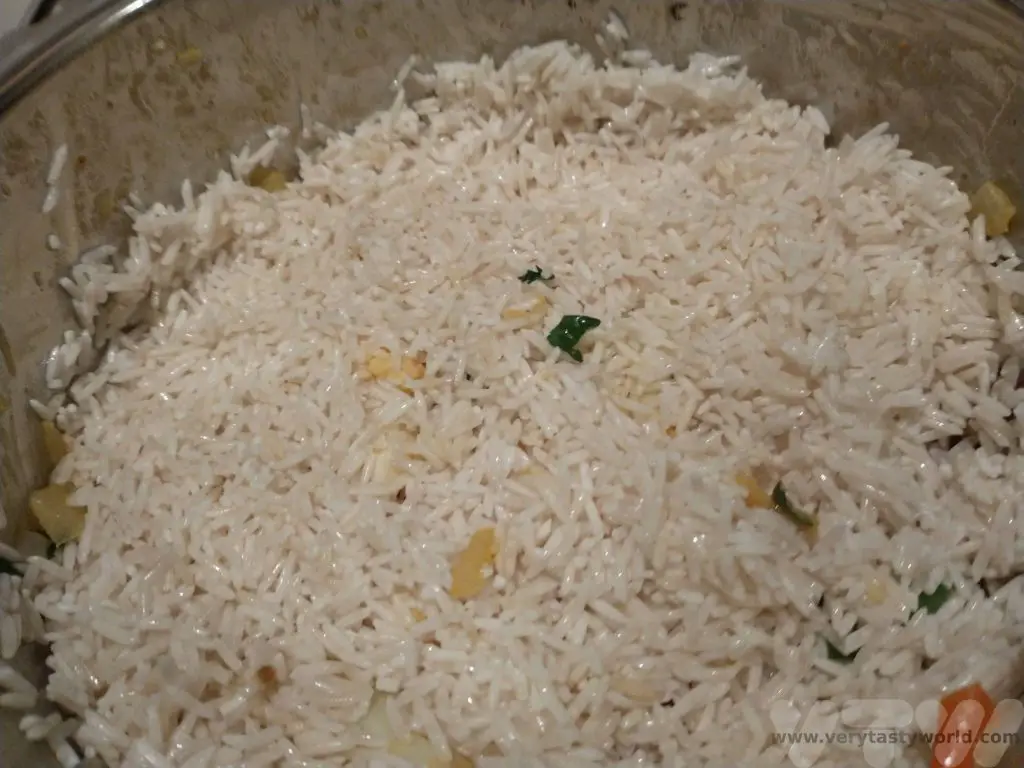
If you are using a pressure cooker: add 1 cup of water and salt to taste.
If you are using a pot: add 1.5 cups of water (this is because some steam will escape) and salt to taste.
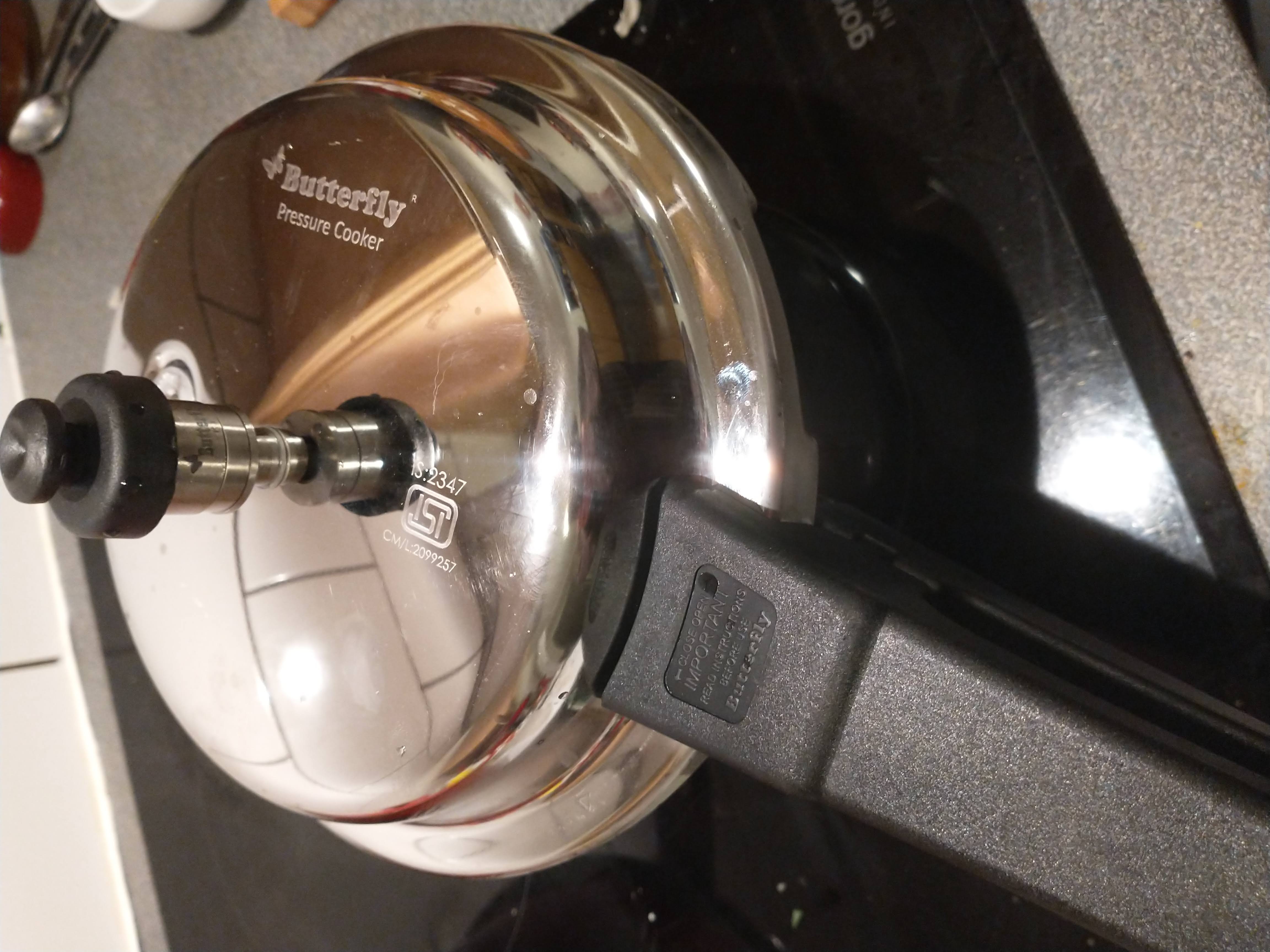
Cover the pot or pressure cooker with the lid.
Pressure cooker – cook on a medium-high flame for one whistle
Pot – cook on low heat until all of the water is absorbed and rice cooked is nicely.
Once the rice is cooked, take the biryani off the heat and let it rest for 15 minutes.
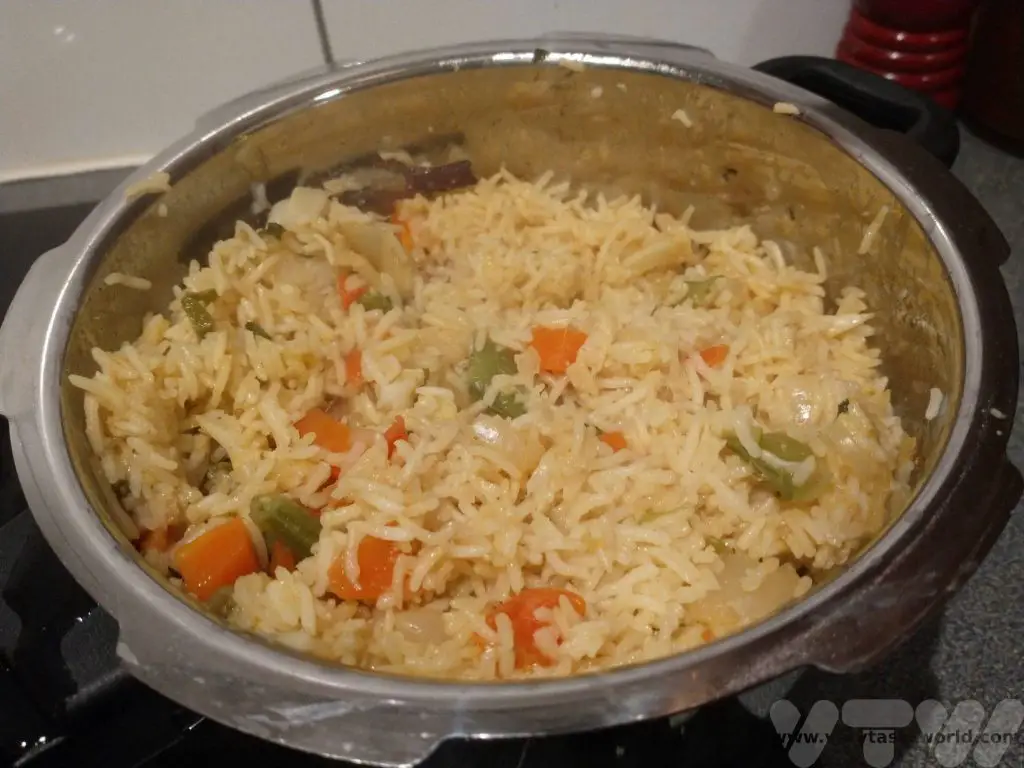
Serve on its own as a main meal, with a biryani raita, or it also makes a great accompaniment to other dishes.

We often enjoy it as an accompaniment to palak paneer – a paneer cheese and spinach curry – for a really delicious veggie meal.
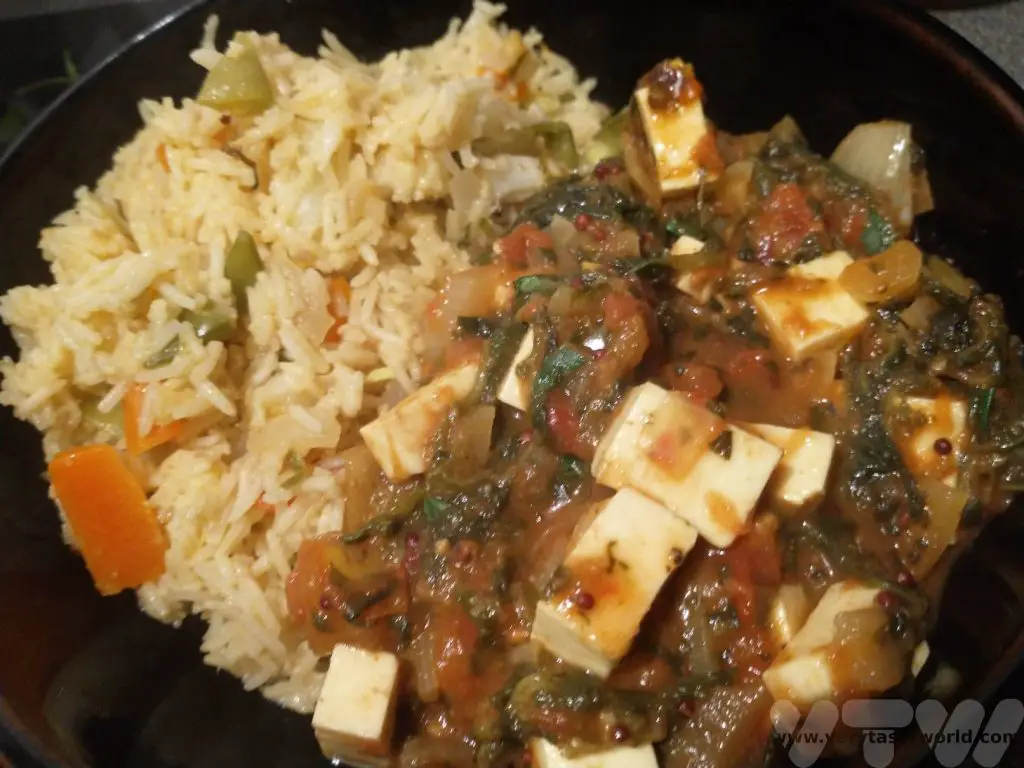

RECIPE: Vegan Wild Garlic Pesto
Every spring we make the most of foraging for greens in the English countryside. Wild garlic is our absolute favourite and we have a fabulous recipe for wild garlic pesto. But pesto uses cheese! So we also have a recipe for vegan wild garlic pesto.
In the UK you can forage wild garlic for free as long as you just take the leaves, stems and flowers. All these parts are edible. We make it a rule never to take more food than we need as it’s nice to leave some for other people and also ensure that the plant will appear next year. We try to pick one leaf from each stem so as not to disturb the plant too much.
Foraging for Wild Garlic
Wild garlic is pretty easy to recognise and has a very definite garlicky smell. Pick a leaf and crush it in your hand – it has a wonderful scent.
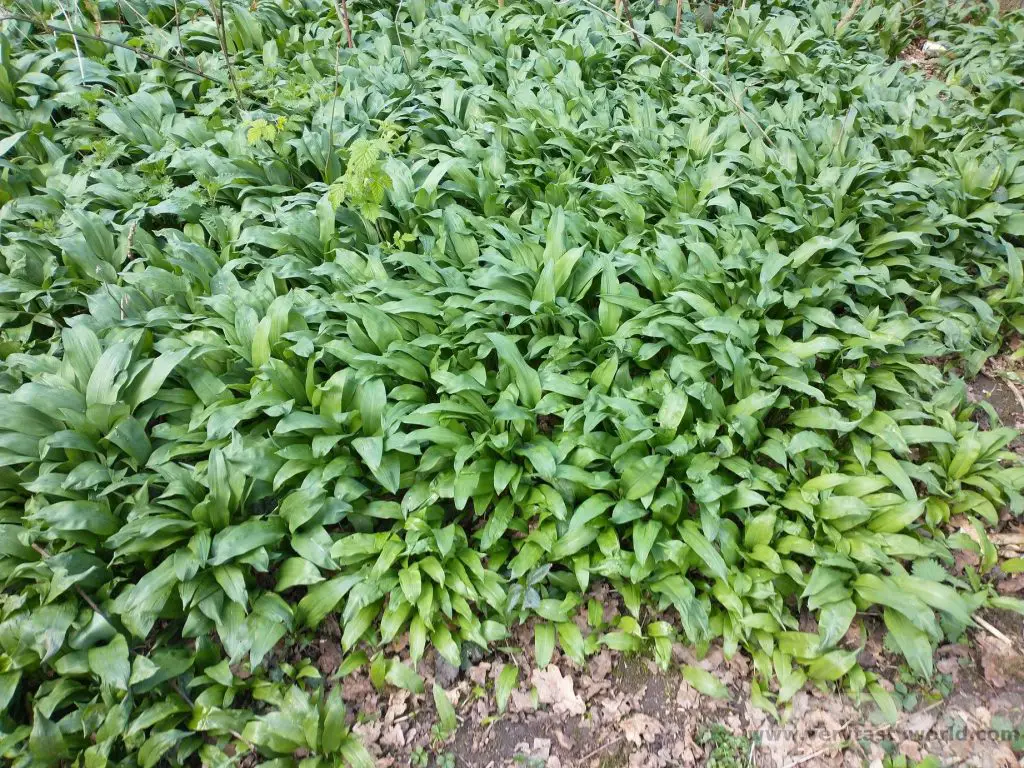
A little later into the season lovely white flowers appear. These have a very mild garlic flavour – we use them to garnish dishes.
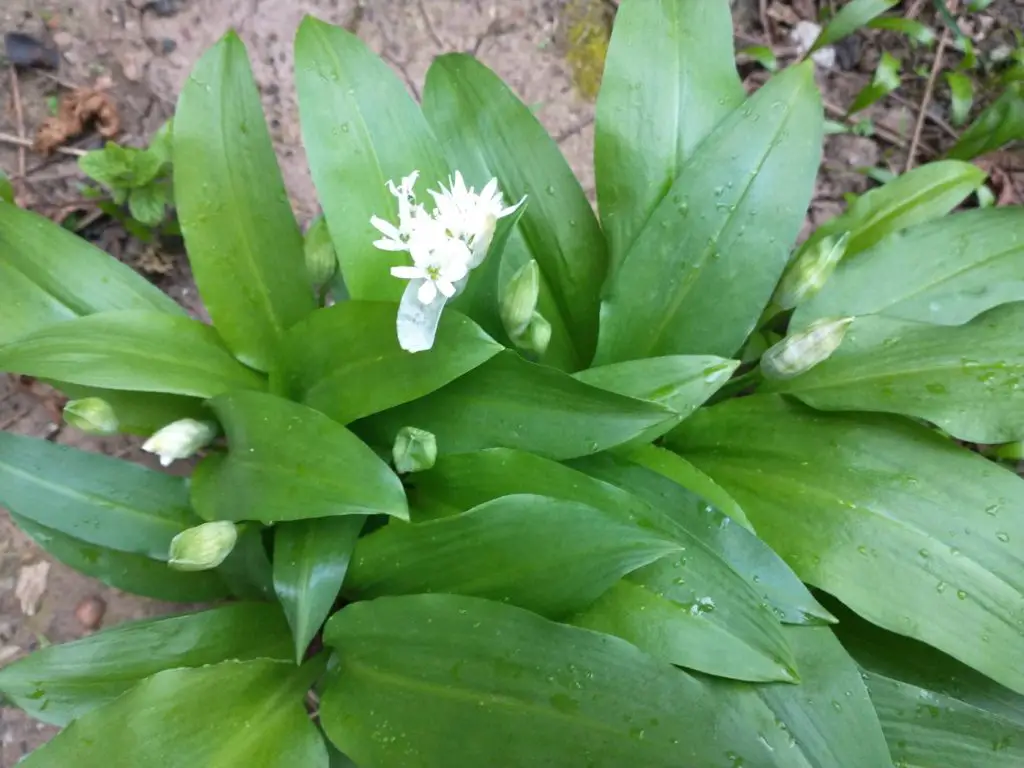
As with any foraging, you have to be 100% certain of what you are picking. Poisonous plants can grow near wild garlic. Arum maculatum, also known as Lords and Ladies, is very toxic. Apparently even putting the leaves into your mouth will result in an immediate burning sensation. It can grows worryingly close to the wild garlic. When it’s more mature it develops shiny arrow-head shaped leaves but when young, looks very similar to wild garlic.
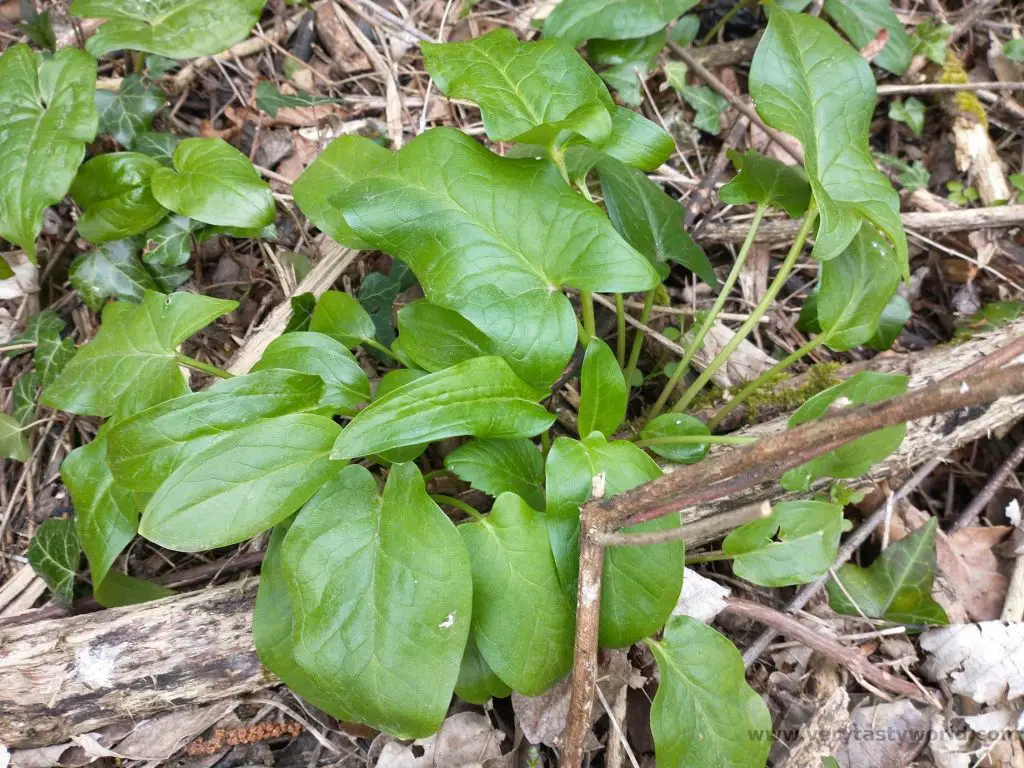
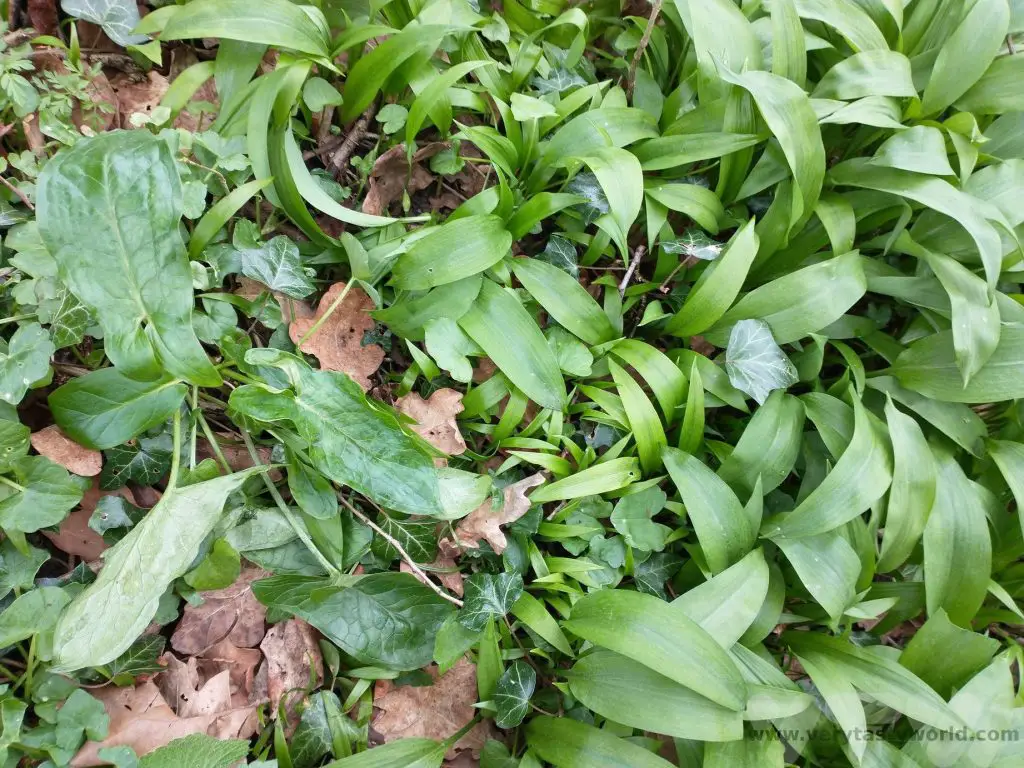
Bluebells, or their white-flowered counterparts, which can also easily be confused with wild garlic’s white flowers, can also grow nearby. Bluebells are extremely pretty but also poisonous.
If you are the slightest bit uncertain, DON’T eat it!
Vegan Wild Garlic Pesto Recipe
Just like our standard recipe our vegan wild garlic pesto isn’t precise. We use cashew nuts but you can also use pine nuts (and weep at the expense) or pistachios. You can use a blender to mix everything together but if you’re feeling hardcore you can use a pestle and mortar.
We use nutritional yeast as a substitute for the cheese. It’s a brilliant product that is really good for you – a great source of protein, fibre, vitamins and minerals. More importantly it has a cheesy flavour, perfect for adding that umami element to the pesto amidst the creamy cashew and heavenly garlicky scent.

Ingredients
Bunch of wild garlic leaves (around 150g)
Handful of cashew nuts (around 150g)
Generous sprinkle of nutritional yeast flakes (we recommend couple of tablespoons if you’re measuring)
Slosh of extra virgin olive oil
Squeeze of lemon
Pinch of salt
Method
Roughly chop the wild garlic leaves and place into a blender. Throw in the nuts and nutritional yeast flakes. We recommend adding the leaves first – to the bottom of the blender – so that the weight of the nuts helps with the grinding process.
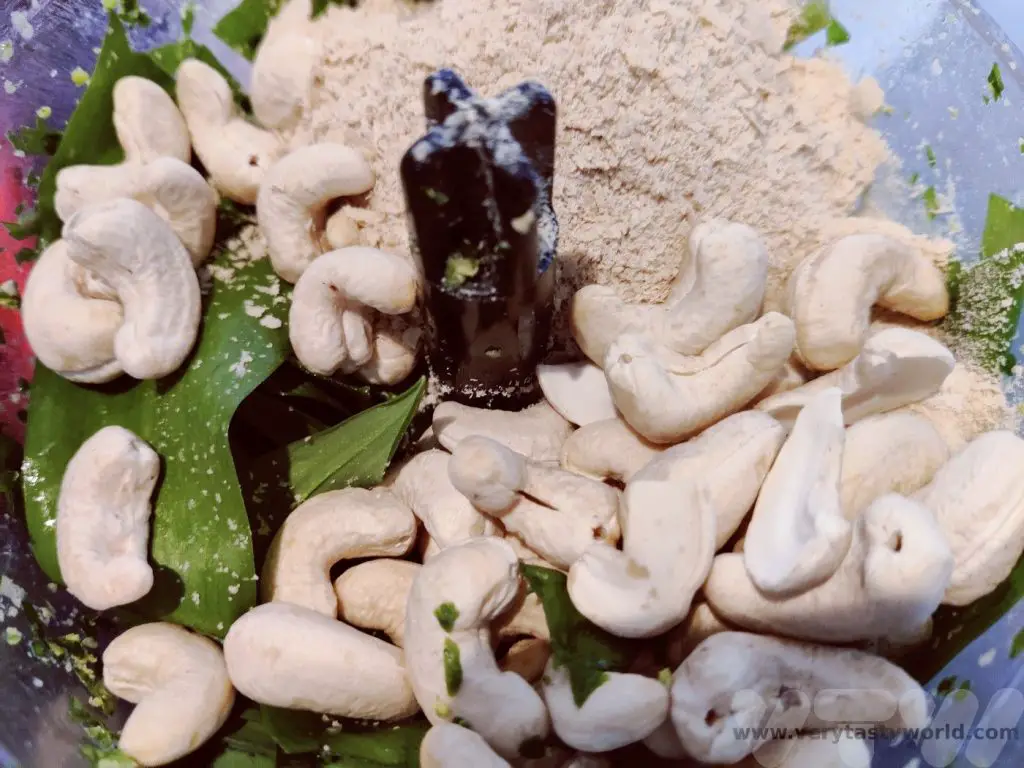
To take advantage of the season we make industrial quantities and freeze it, so we can enjoy the scented flavour of spring throughout the year. We don’t add the oil, lemon and salt before seasoning but stir it in after it has defrosted.
Blend together until you get the texture you like – smooth or nutty – both work well.
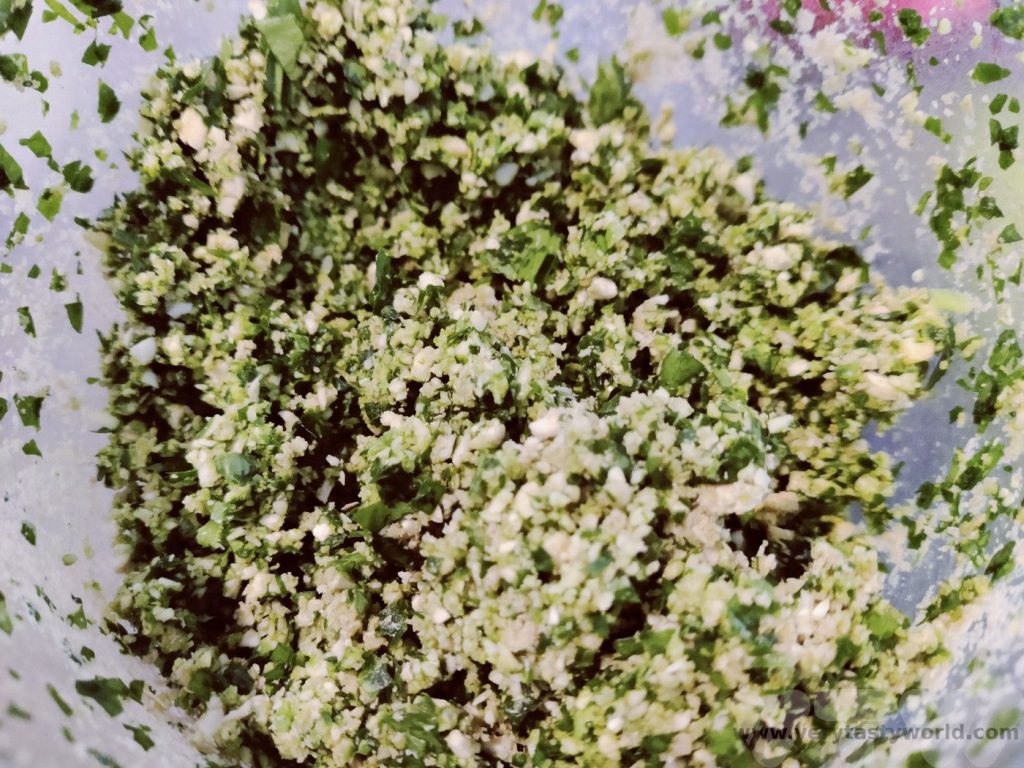
If you want to freeze the pesto, decant it into containers and put it into the freezer. It will freeze well and will last many months.
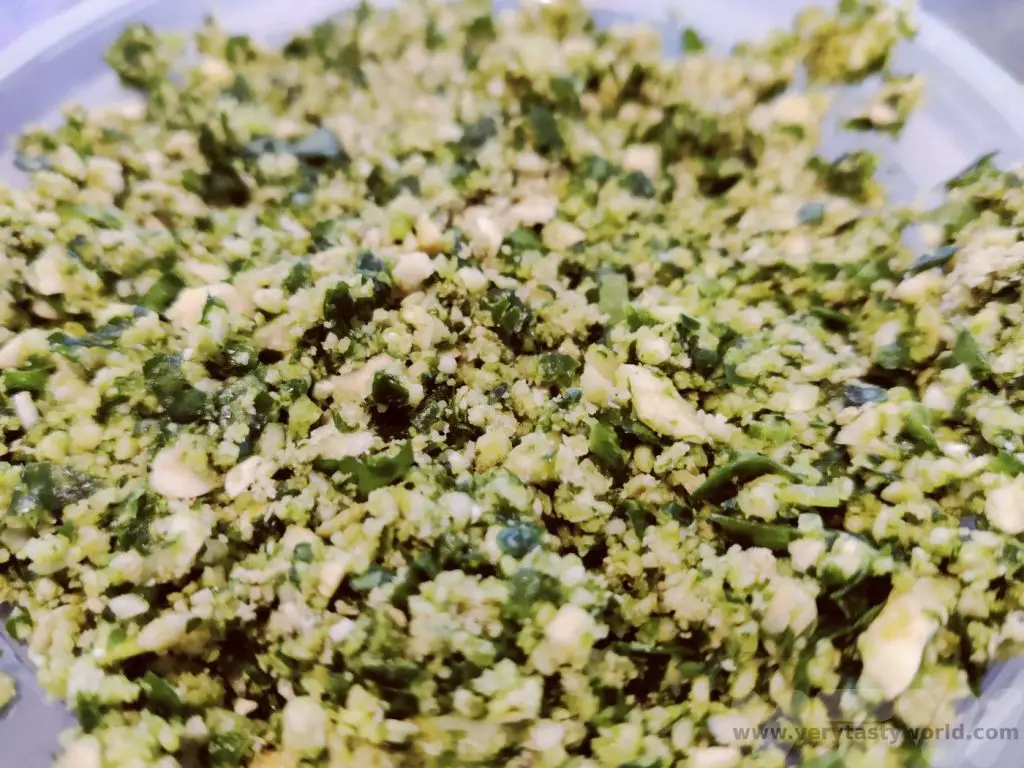
If you want to eat the pesto straight away (or store it in the fridge for a couple of days) add the oil, lemon juice and salt.
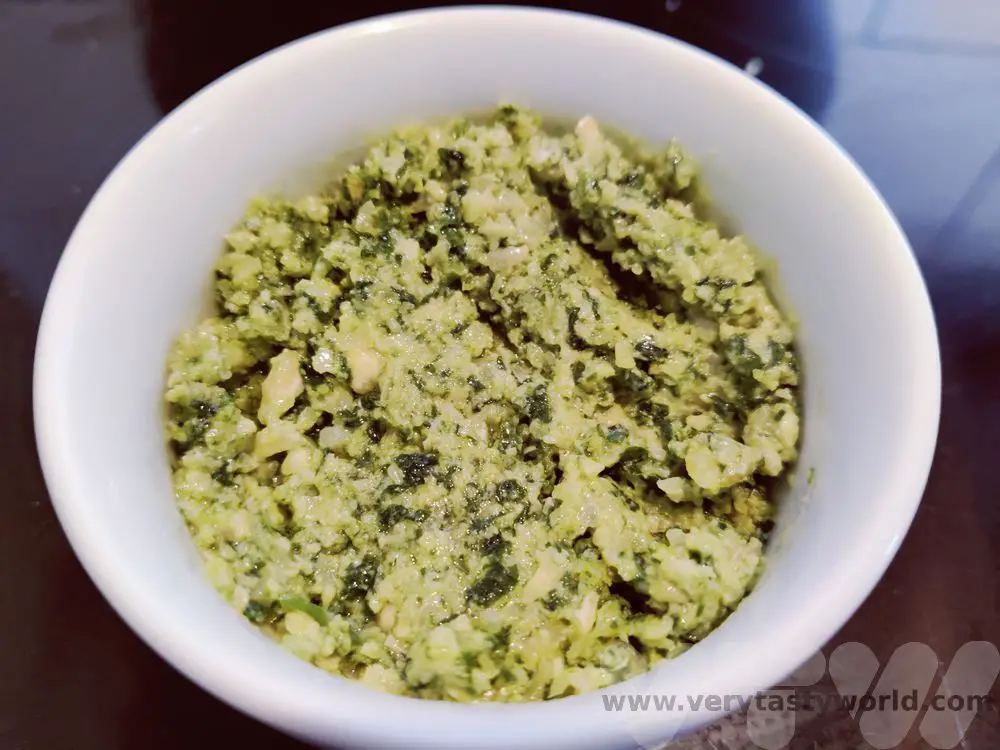
The great thing about this recipe is that is so easily adaptable – you can mix and match ingredients. It’s the underlying gentle garlicky flavour that the wild garlic leaves produce that make this such a brilliant pesto. We’ll be foraging and freezing for as long as the season lasts.
Related Posts You May Enjoy

- RECIPE Oyakodon Donburi
- Zero Waste Recipes Before Your Holiday
- RECIPE: Vegetable Biryani Tamil Nadu Style
- RECIPE: Vegan Wild Garlic Pesto
- Recipe: Venetian Pasta Sauce
- RECIPE: Biryani Raita Recipe
- RECIPE: How to Make Costa Rica’s Gallo Pinto
- Recipe: Japanese Simmered Pork Belly – Buta no Kakuni
- RECIPE: How to Make Umeboshi
Recipe: Venetian Pasta Sauce
When we visited Venice we were surprised to learn that the cuisine wasn’t all pasta pasta pasta – rice dishes such as risotto are more typical of the region. And of course there is lots of seafood on offer.

When we explored the Rialto market we fell for the touristy foodie goodies – from different types of pasta to various herb and spice mix condiments. All wrapped up very prettily and ideal as a souvenir.
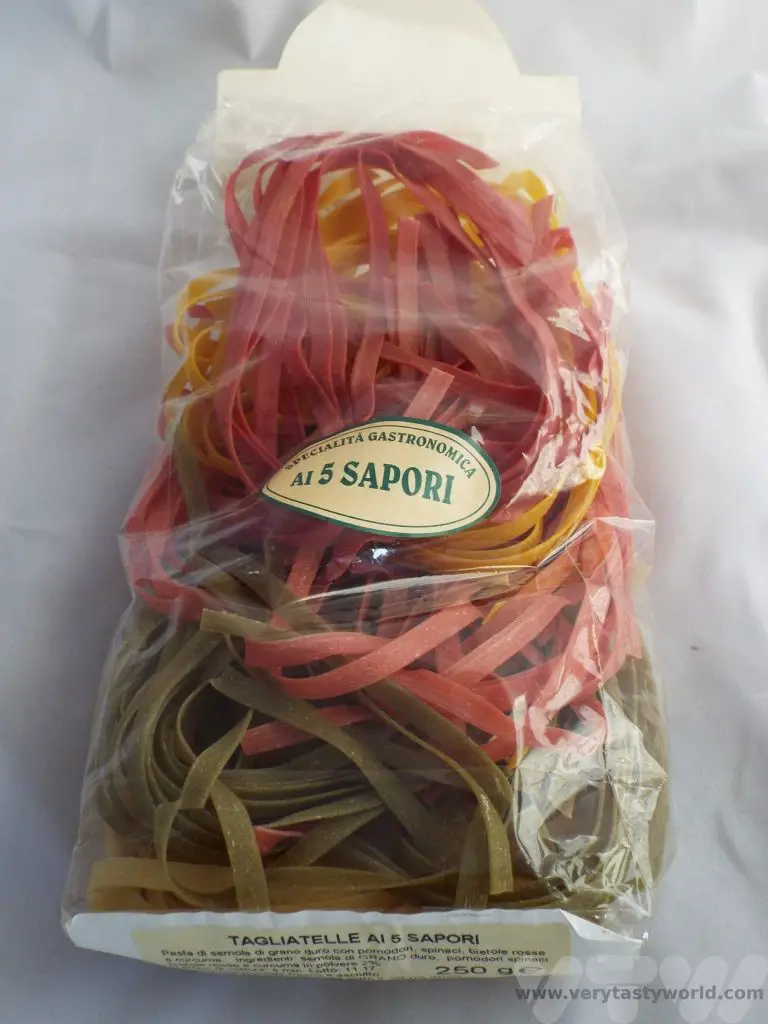
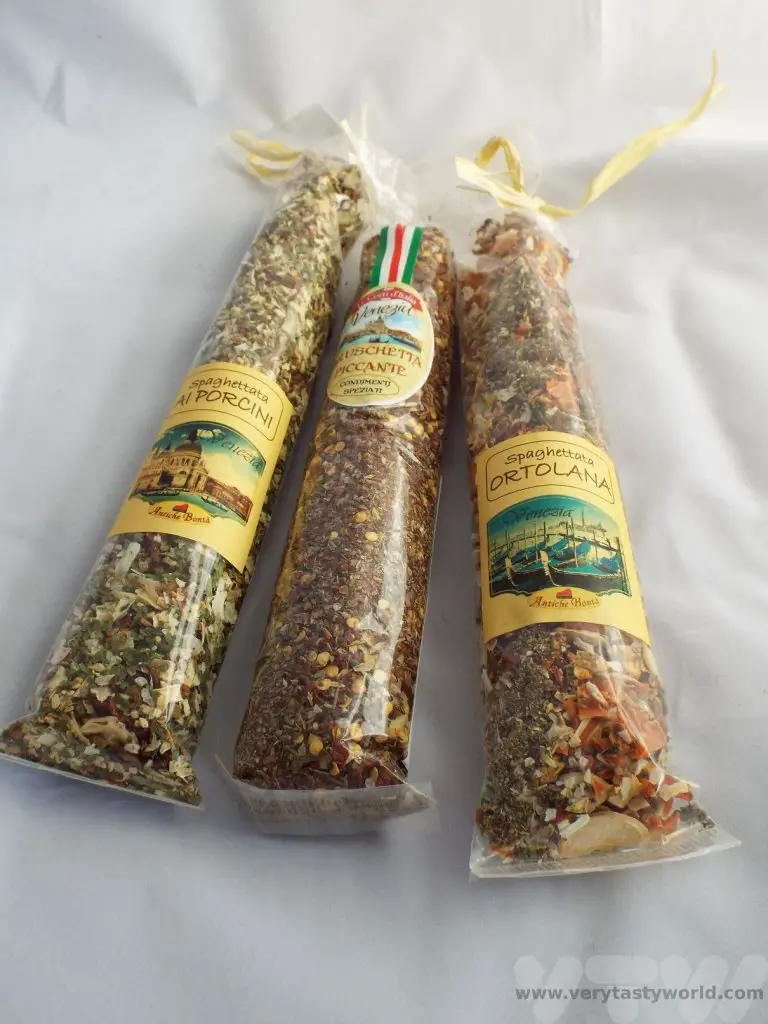
We wanted to try to make a sauce that was typically Venetian and came across salsa with bigoli.
This Venetian sauce is brilliant because it has a minimal number of ingredients, is really simple to cook, but packs a real punch in terms of flavour. The predominant flavours are sweet – from the onions which have a natural sweetness (any acrid onion flavour gets cooked away) – as well as salt and umami from the fish. It’s a fantastic combination.
Tinned fish is really popular these days and this recipe is great for using cheap ingredients – just onion and a couple of tins of fish. However, it does require quite a long cooking time, which uses energy, so we recommend making it in bulk and then freezing the leftovers. Then you can always have some to hand – just defrost and reheat.
Traditionally this sauce is served with bigoli, the pasta of choice in Venice. It’s like a big spaghetti, long and with a rough texture to soak up the sauce. We find it quite difficult to get bigoli in the UK, so spaghetti or tagliatelle work well as substitutes.
How to Make Venetian Pasta Sauce
Serves 4 people (or 2 and you can freeze any leftovers). Or double up and make a large quantity to freeze.
Ingredients
2 large onions
1 tin of anchovies in oil
1 tin of sardines in oil
Water
Black pepper to taste and green herb such as parsley to garnish
Pasta of your choice to serve it with (bigoli is traditional)
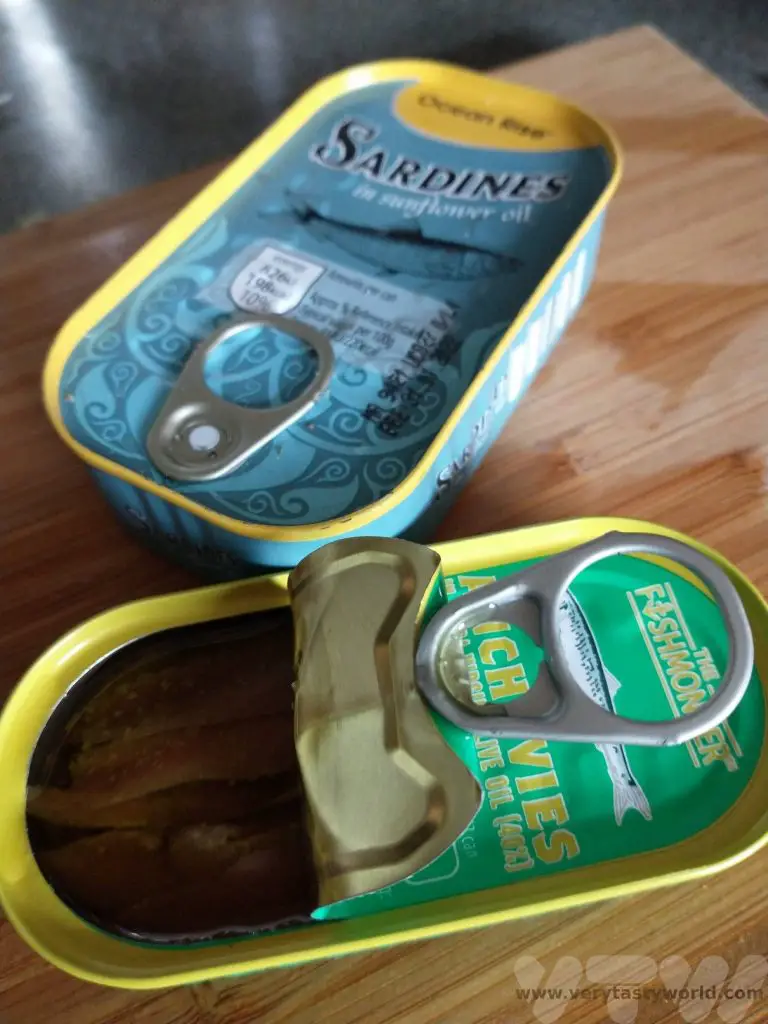
Method
Chop the onions very finely. When you think you’ve chopped them finely enough, chop them some more. The aim is to cook them to a mush.
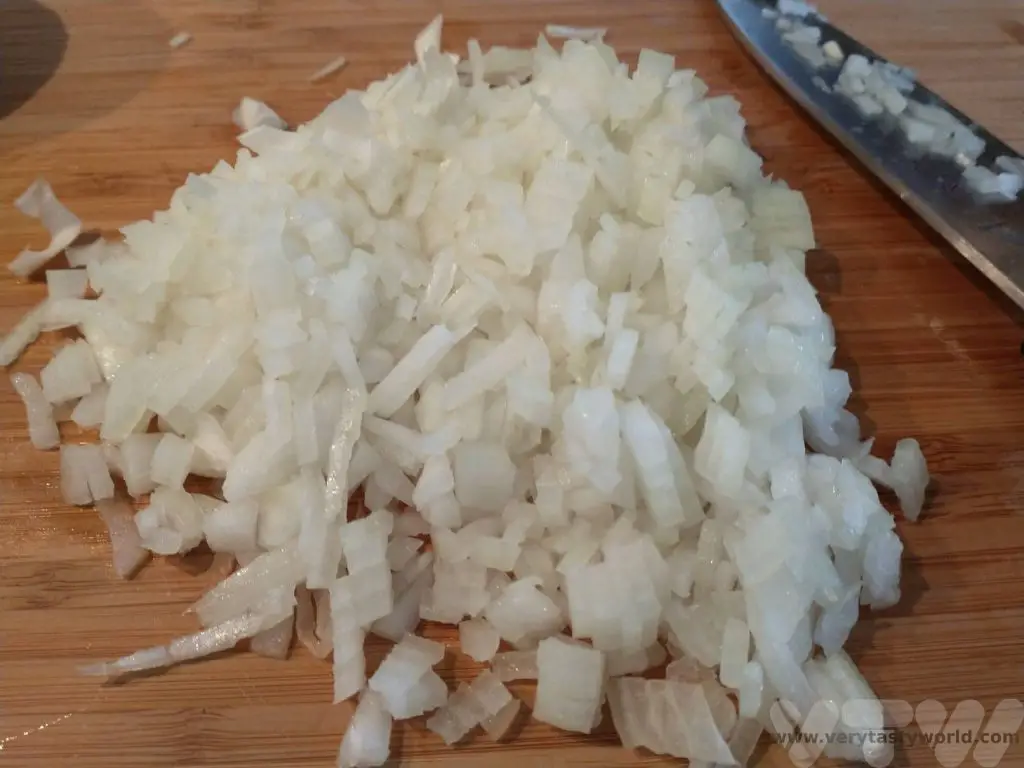
Put the very finely chopped onions into a pan and add water – just to the level of the onions. Use a low heat to cook them. Keep an eye on the water and top up a little if it evaporates.
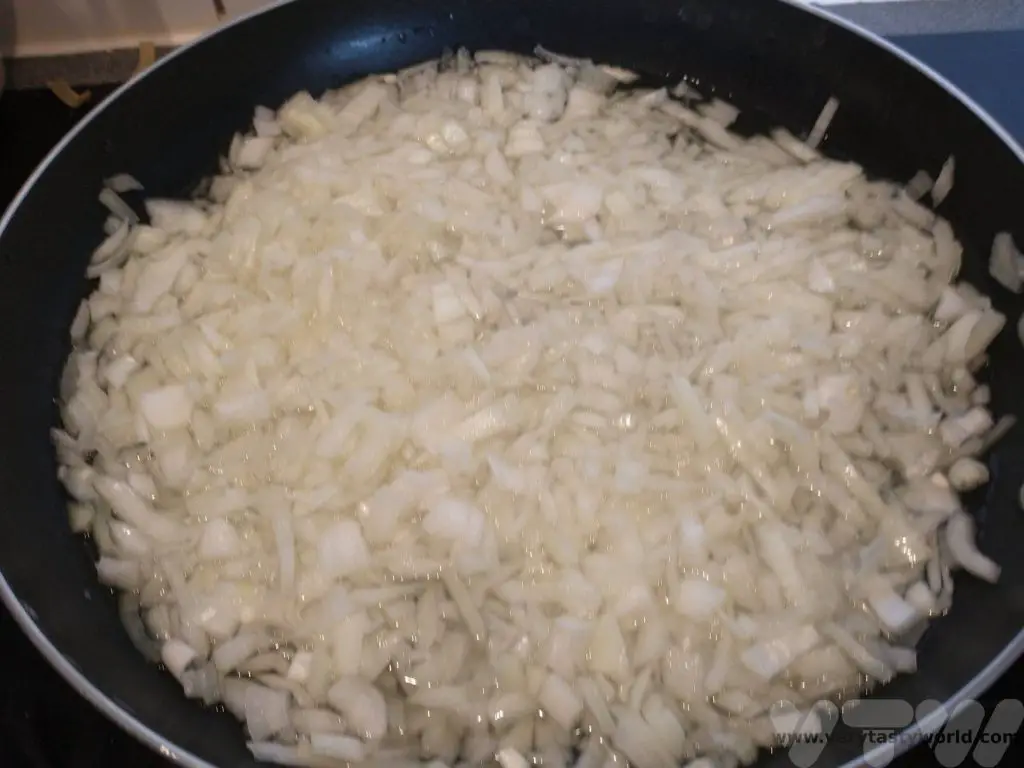
After around 35-45 minutes the onions should be nicely mushy. If there is still water in the pan, turn up the heat briefly to let it evaporate off. Otherwise use a potato masher or a wooden spoon to mash them if needed.

Open the sardine and anchovy tins and chop the fish finely. Retain any oil that’s in the tin.
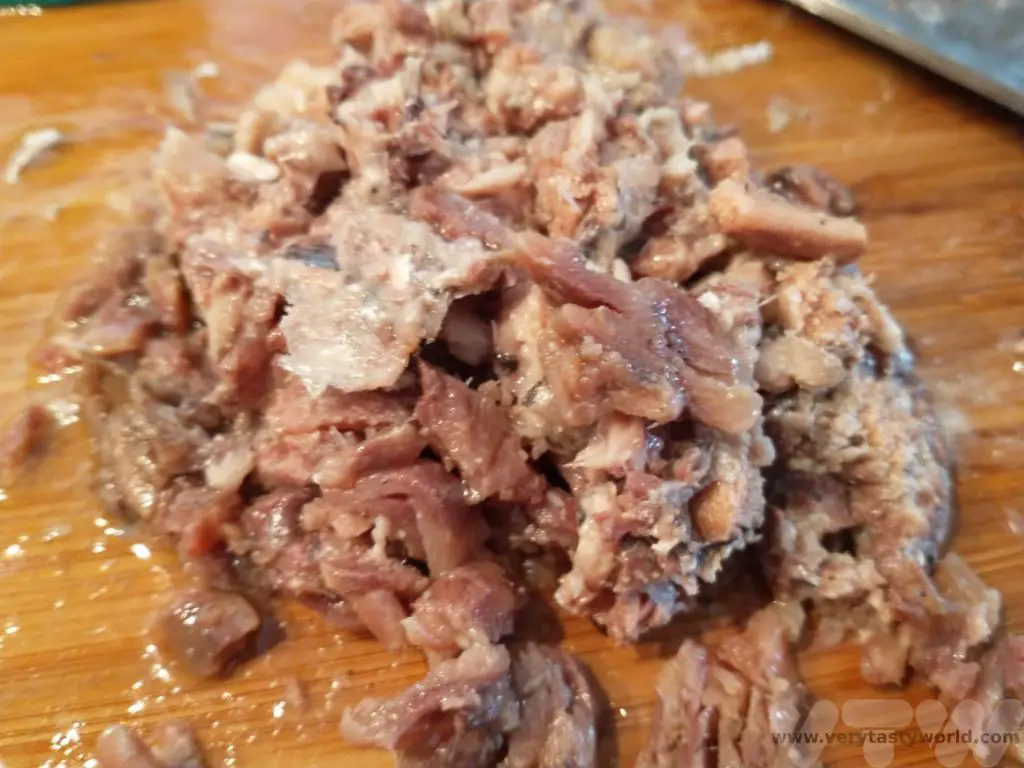
Add the chopped fish to the onions and stir. Let them dissolve into the mixture.
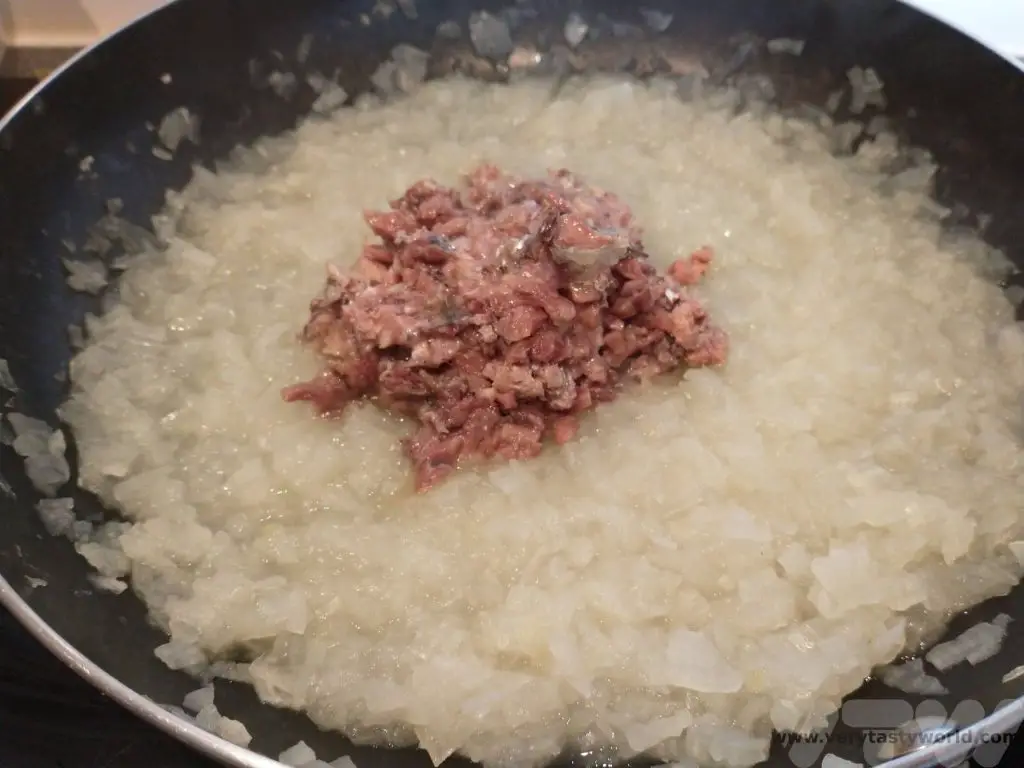
That’s it. The sauce is ready. Keep it warm on a low heat while you cook your pasta.
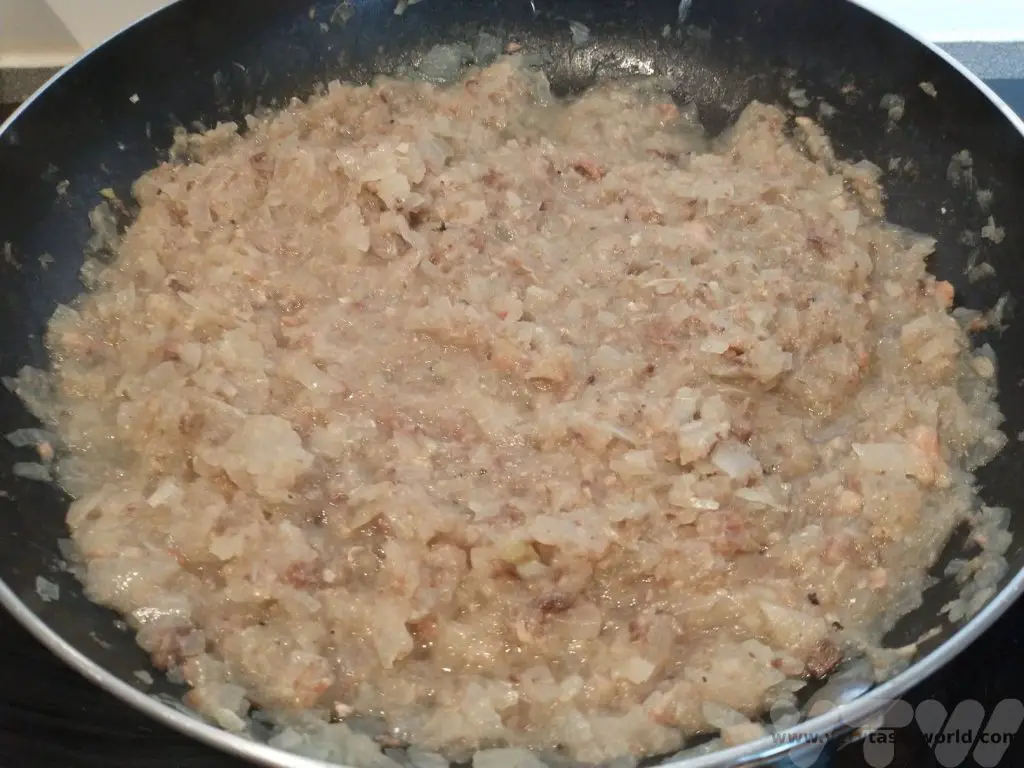
We didn’t have any bigoli on hand but we did have some tagliatelle, bought in Venice as a souvenir, in the colours of the Italian flag, which we felt was an appropriate pasta to use.
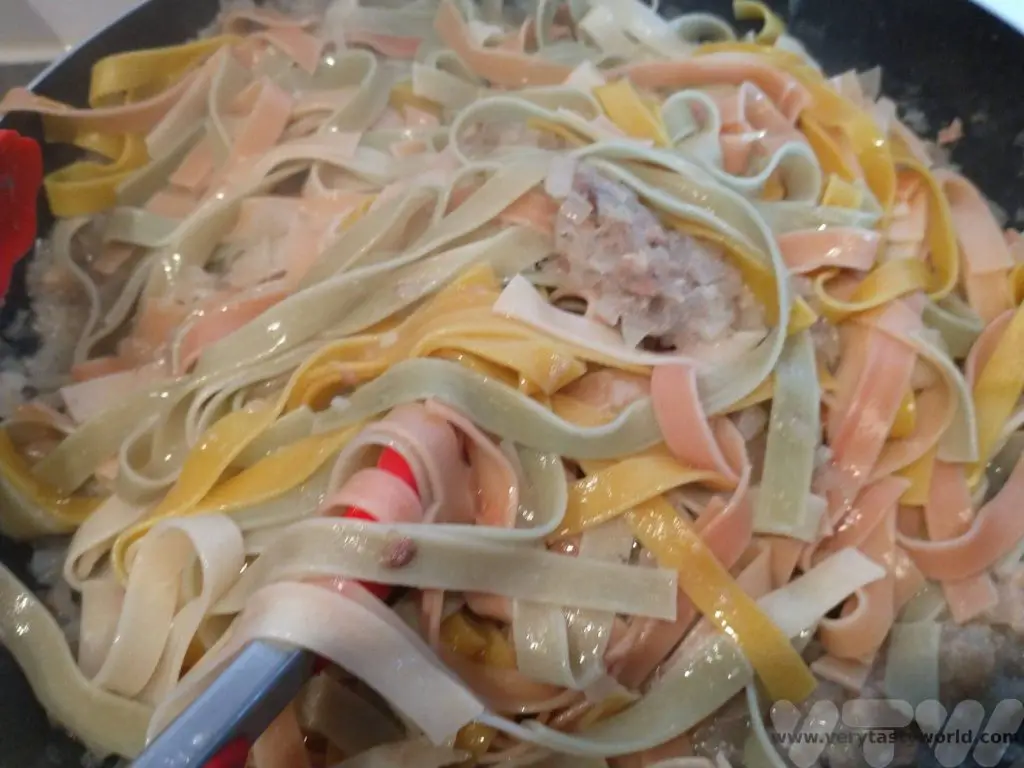
Cook the pasta. When we cooked the pasta we didn’t add salt to the water because the anchovies are pretty salty, but season to your taste if needed.
Add the pasta to the sauce and mix. We seasoned with freshly milled black pepper and our garnish was some foraged garlic mustard leaves but a green herb like parsley will be fine as well.
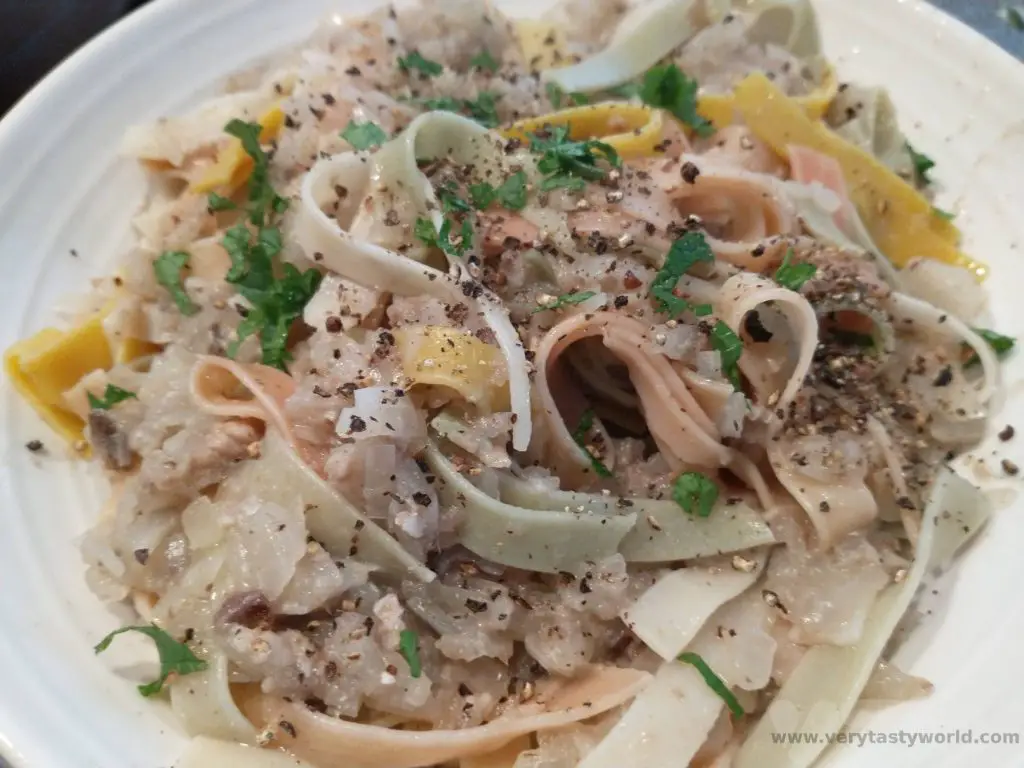

- RECIPE Oyakodon Donburi
- Zero Waste Recipes Before Your Holiday
- RECIPE: Vegetable Biryani Tamil Nadu Style
- RECIPE: Vegan Wild Garlic Pesto
- Recipe: Venetian Pasta Sauce
- RECIPE: Biryani Raita Recipe
- RECIPE: How to Make Costa Rica’s Gallo Pinto
- Recipe: Japanese Simmered Pork Belly – Buta no Kakuni
- RECIPE: How to Make Umeboshi
RECIPE: Biryani Raita Recipe
There are many cuisines around the world that use yoghurt-based dips or sauces to accompany particular dishes. Tzatziki is a Greek dish which incorporates cucumber and herbs into a Greek yoghurt. Salatat Khyar is an Arabic salad which is similar to tzakziki in that it uses cucumber and mint with the yoghurt but can be eaten as a standalone salad. And then there’s raita, often used in Indian cuisine as an accompaniment to ‘cool’ the spiciness of a main dish. This biryani raita recipe is simplicity itself to make and really delicious.
Yogurt is ideal to counteract the heat of chillies in any dish it accompanies. There’s a protein called casein which is found in dairy products. It binds to the active component of chillies which is called capsaicin and is the main cause of the burning sensation in the mouth. The casein helps soothe the burn. If you eat a spicy chilli, a drink of milk will help quash the heat far better than water.
(The combination of chilli and cheese in Bhutan’s national dish is cleverly designed to be spicy but the intense heat is tempered by the cheese.)
Raita uses cucumber but it can also have other vegetables such as onion and carrot, often diced. This dish can easily be adapted to incorporate different vegetables or even spices. If you wanted to add a warm earthiness, chuck in a teaspoon of cumin. Or add a touch of fire with a teaspoon of chilli or paprika. Harissa is a nice addition for a Middle Eastern dish. Similarly, you can vary the herbs – mint is a lovely alternative to the coriander or you can just add both in.
Our biryani raita is fantastically flexible in accompanying so many different types of dish.
Biryani Raita Recipe
Ingredients
3 heaped tbs plain natural yoghurt
2 garlic cloves (use 1 if you’re not so keen on garlic or are planning on kissing someone later on in the day)
Juice of half a lemon
Half a cucumber
2 spring onions (green onions)
Bunch of coriander/cilantro (mint also works really wall, or combine the two)
Pinch of salt. We particularly like crystal salt rather than table salt
Method
Grate the cucumber.
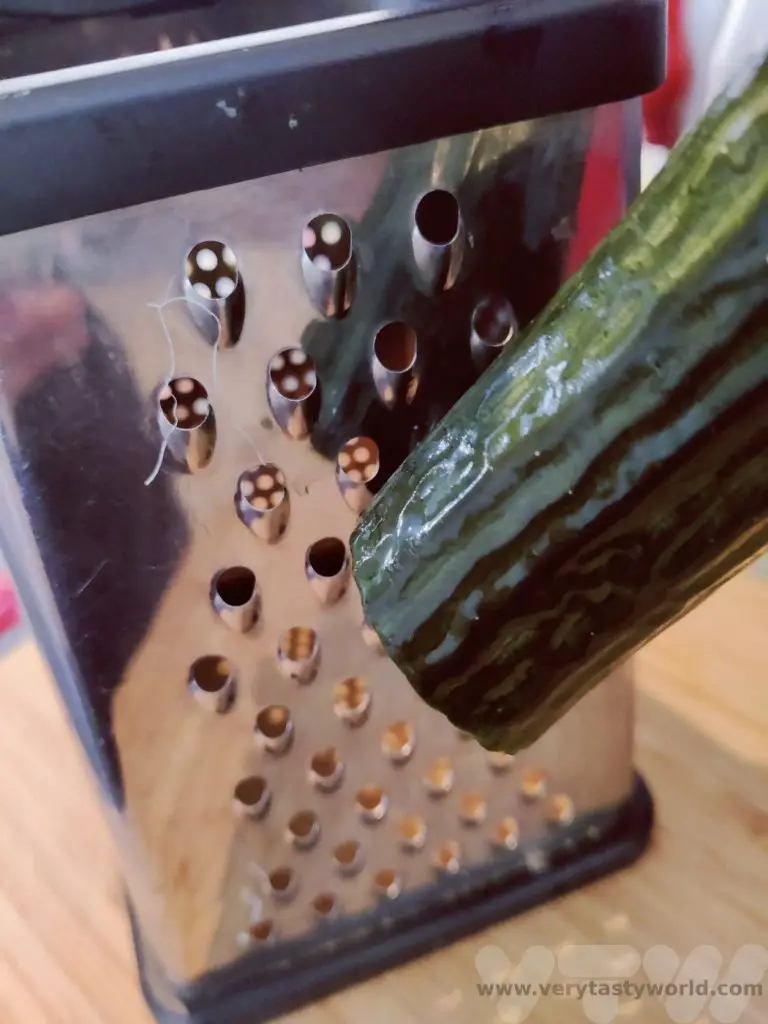
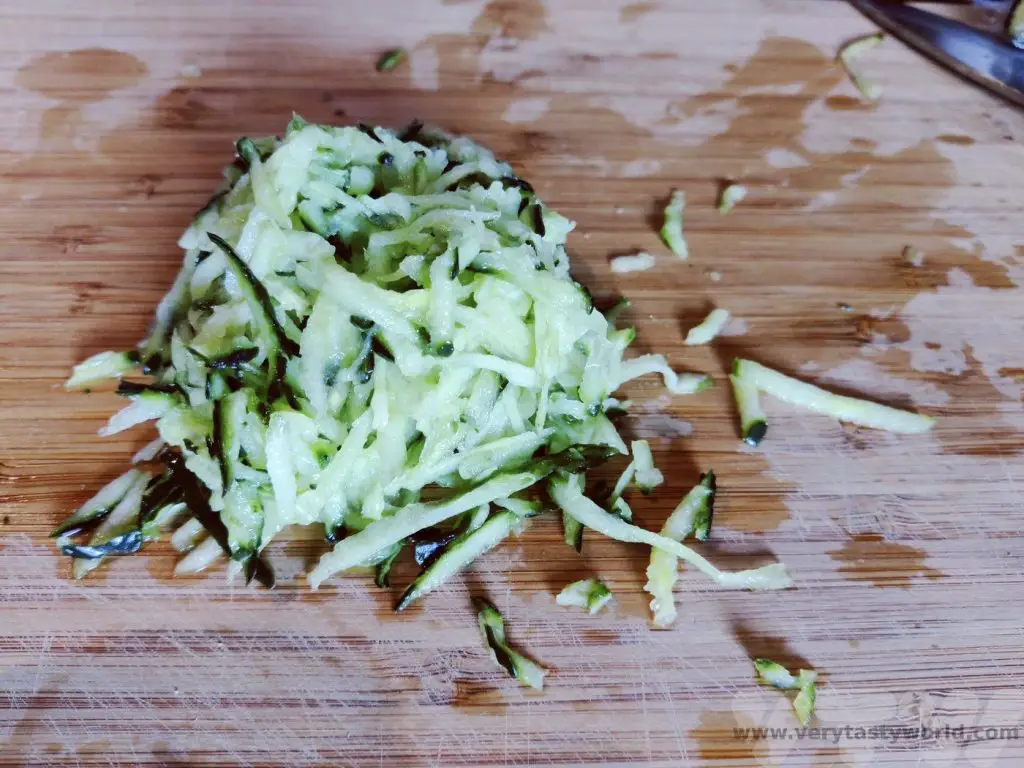
Gather up grated cucumber and squeeze the water out.
If you wish you can wrap the grated cucumber in a tea towel to absorb the rest of the water. It’s important to get as much water out of the cucumber as possible to avoid the raita becoming watery.
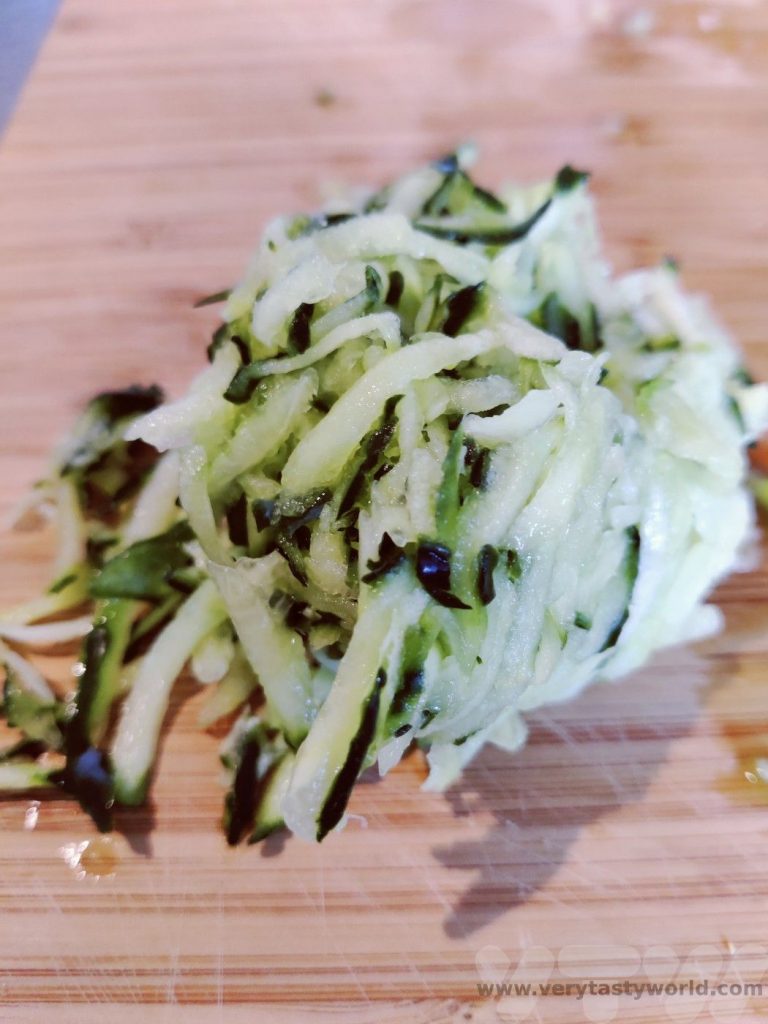
Finely chop the spring onions and coriander.
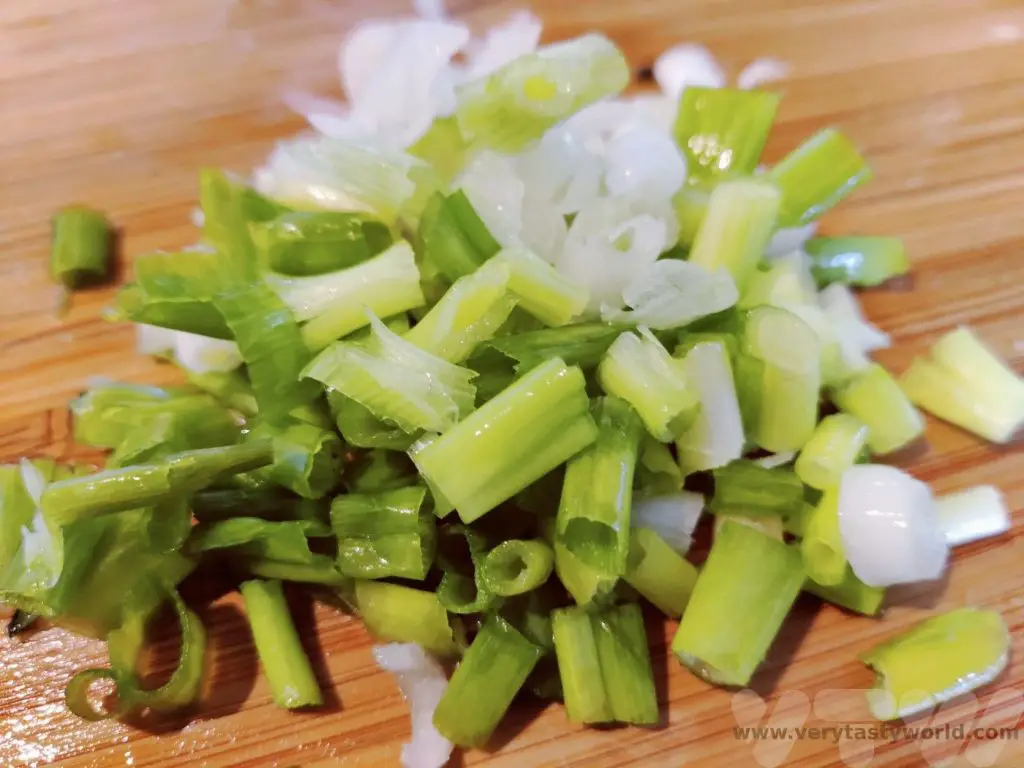
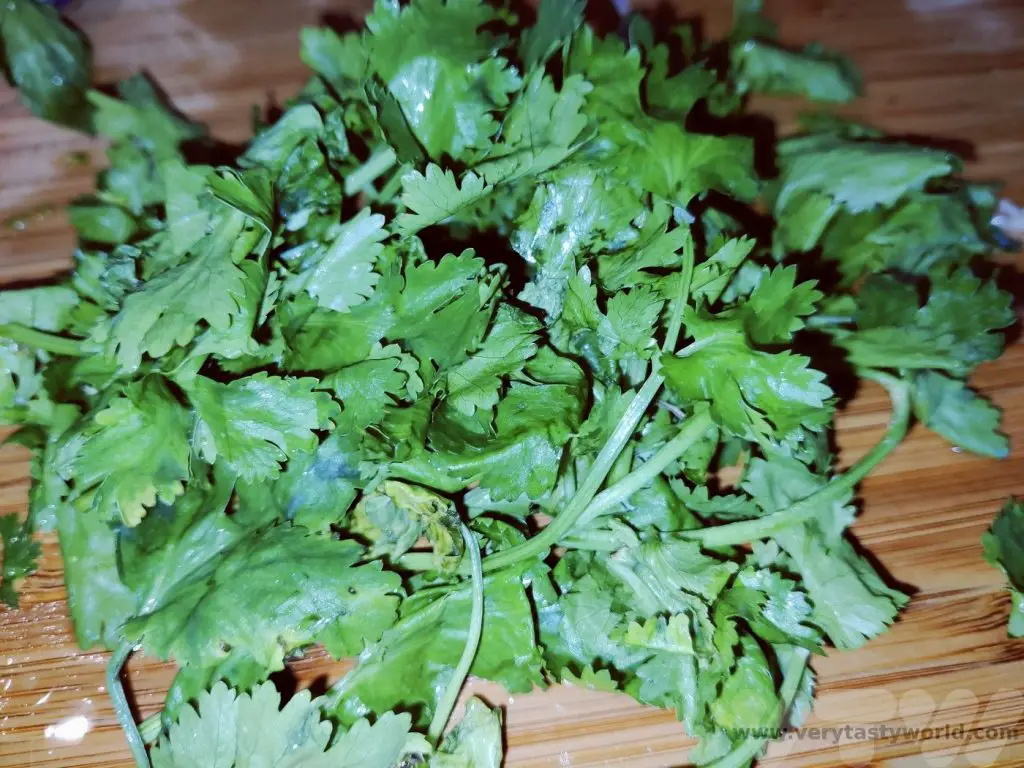
Place yoghurt in a bowl. Add the cucumber, spring onions and coriander.
Grate the garlic into the bowl – we find that a microplane grater is perfect for this. Our you could use a standard garlic press.
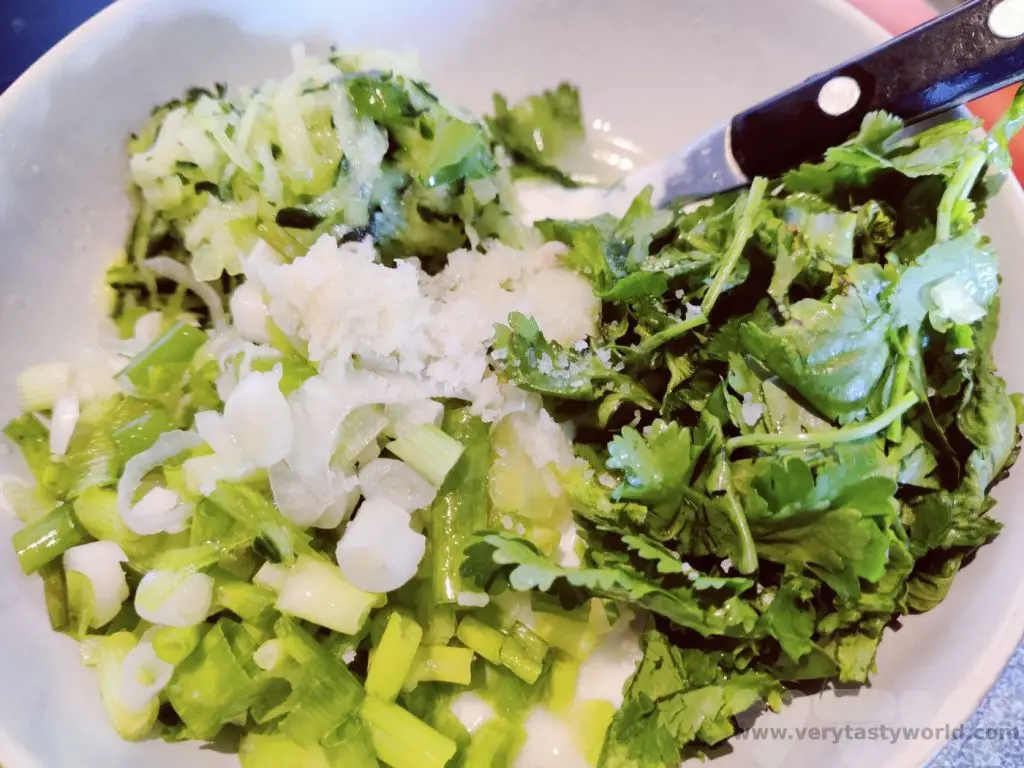
Squeeze the lemon to extract its juice, making sure that none of the pips end up in the mixture, and add the salt.
Mix together.
Ready to serve.
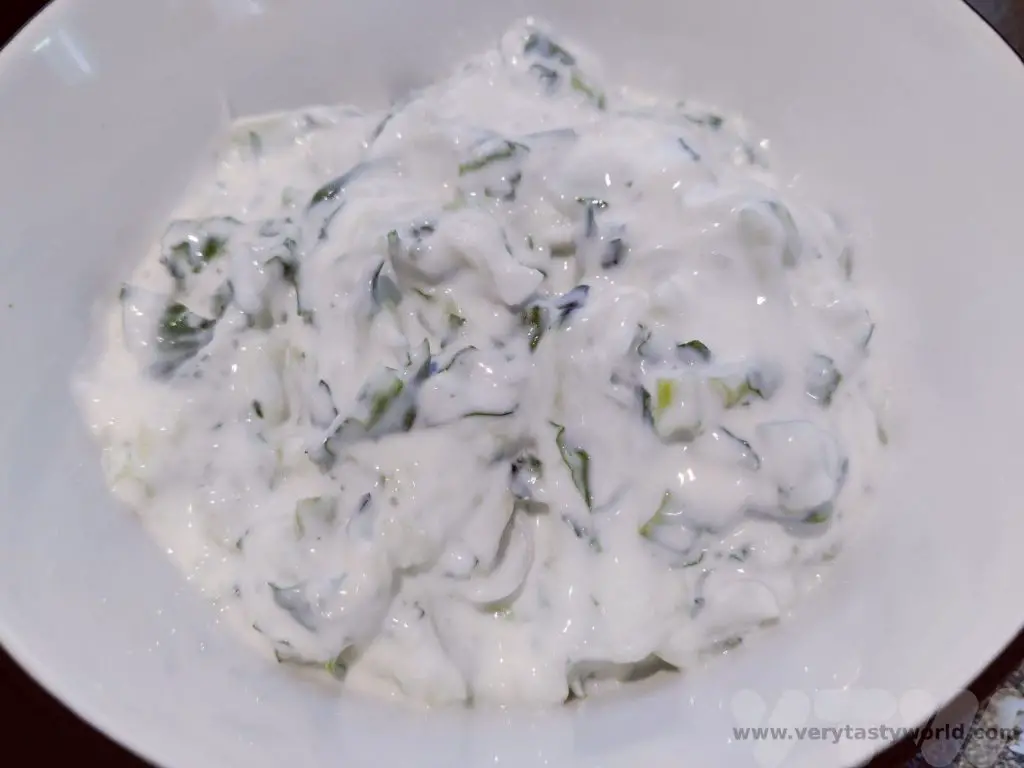
This works brilliantly to accompany a biryani, and cool it down if it’s particularly chilli hot.
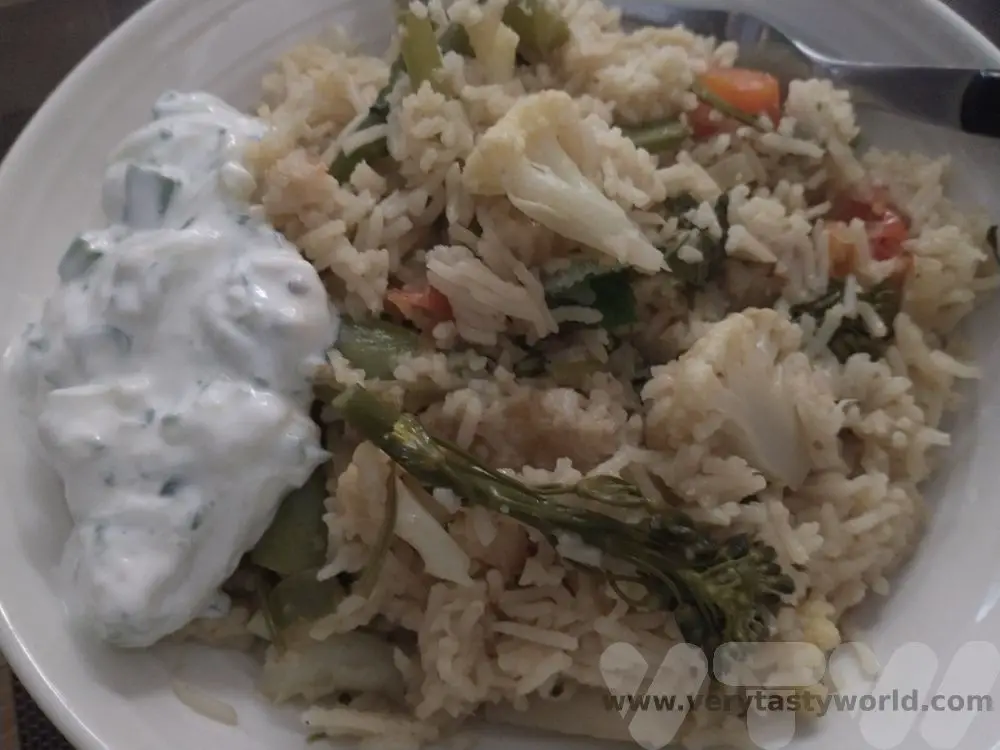
Or a delicious dollop as a great accompaniment to felafel in a wrap.
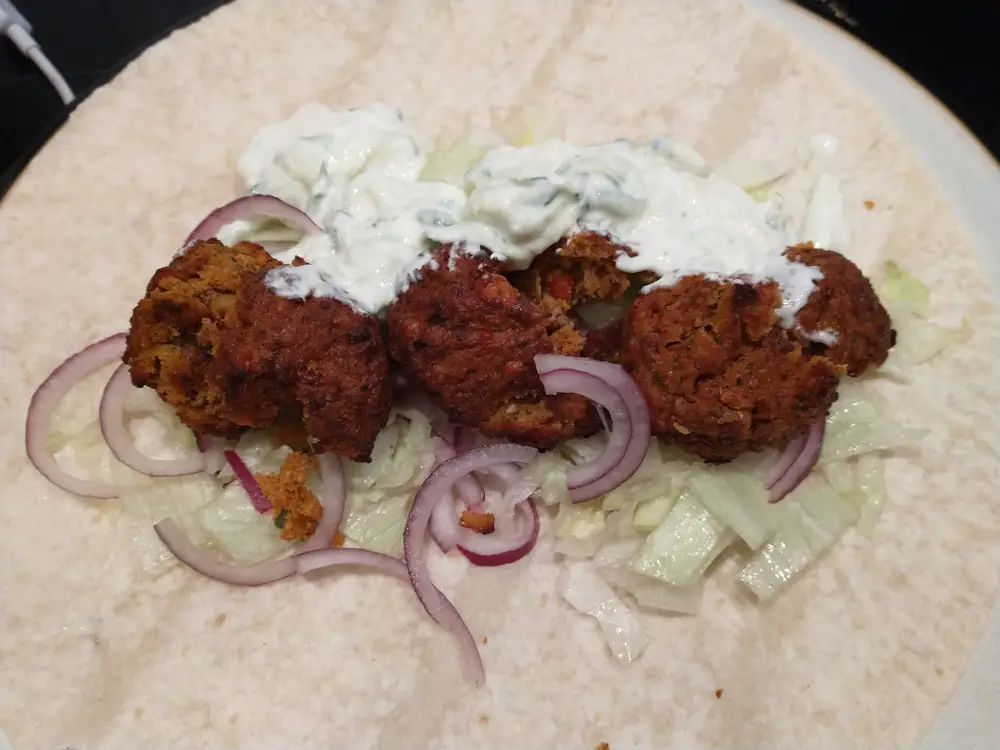
Or to accompany a Middle Eastern mezze. Here with home-made dolma (stuffed vine leaves), baba ganoush (aubergine dip) and tabbouleh (cous cous herb salad).
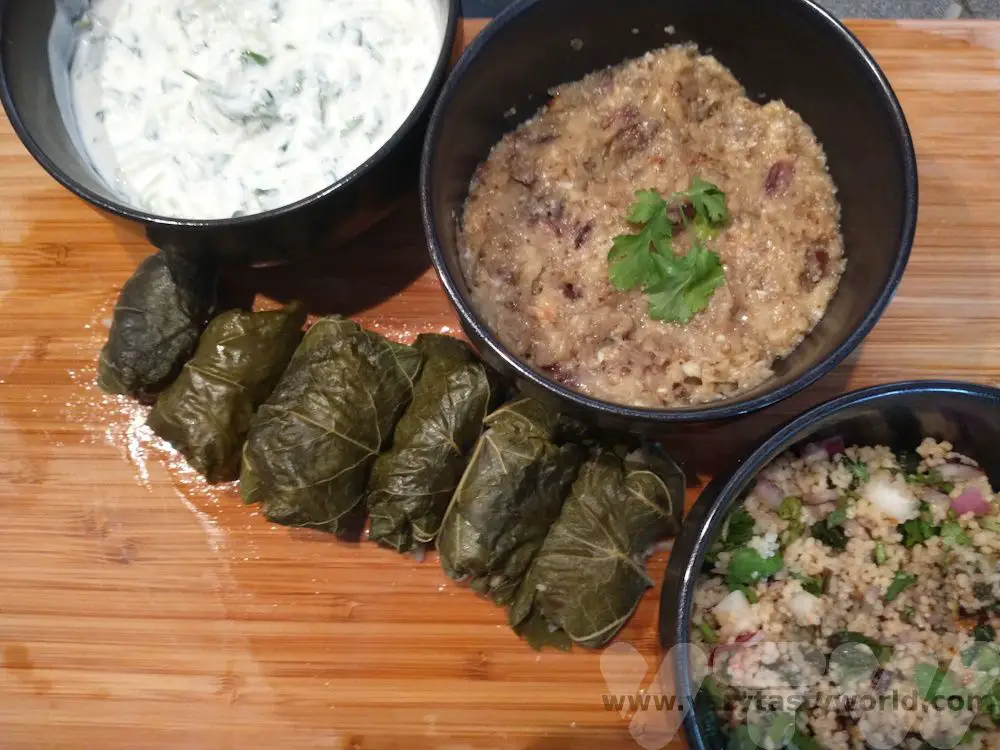
Related Posts You May Enjoy

- RECIPE Oyakodon Donburi
- Zero Waste Recipes Before Your Holiday
- RECIPE: Vegetable Biryani Tamil Nadu Style
- RECIPE: Vegan Wild Garlic Pesto
- Recipe: Venetian Pasta Sauce
- RECIPE: Biryani Raita Recipe
- RECIPE: How to Make Costa Rica’s Gallo Pinto
- Recipe: Japanese Simmered Pork Belly – Buta no Kakuni
- RECIPE: How to Make Umeboshi

RECIPE: How to Make Costa Rica’s Gallo Pinto
Gallo pinto is Costa Rica’s national dish. It’s so popular it can be eaten for breakfast, lunch and dinner. It comprises rice and beans cooked together and served with a variety of accompaniments – such as sausage, vegetables and eggs.
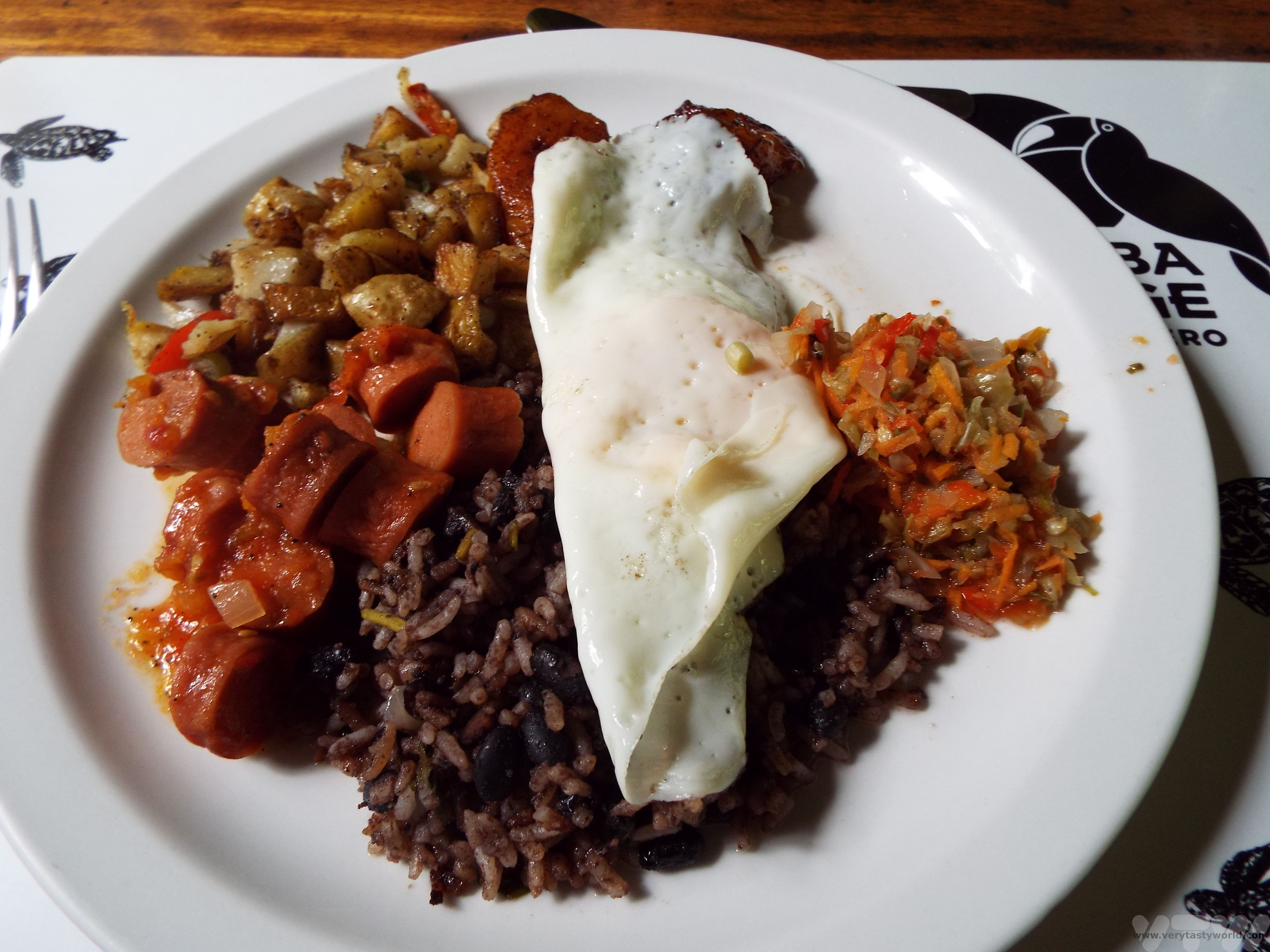
Gallo pinto can be translated as “spotted rooster” and refers to the black beans dotted through the white rice, the colours of which resemble a speckled chicken. Costa Rican food is considered to be highly nutritious and gallo pinto is no exception, but importantly, it’s also hearty, filling and delicious.
The type of rice used is traditionally white long grain. Brown rice or short grain rice is okay to use if that’s what you have. Gallo pinto is great if you cooked too much rice for dinner the night before – it’s an ideal leftovers meal.
The sauce used in this dish is called Lizano. If you ask for salsa at a restaurant in Costa Rica they will bring Lizano. It is used to accompany many dishes and we managed to bring back a couple of bottles from our trip. It is a tangy, spicy (but not searingly hot) sauce that has a lovely piquancy. It’s available in the UK but often at a massively inflated price – we’ve seen it available at an eye-wateringly expensive £30 for two bottles! No, we didn’t buy it. Instead we’ve worked out a recipe using easily available sauces/spices that replicates the flavour pretty well.
Gallo Pinto Recipe (Serves 4)
Ingredients
2 cups long grain white rice (our cups are around 150 ml)
1 tin of black beans (240g)
2 Tbs Lizano sauce (if you can’t get this you need 1 Tbs brown sauce, 2 tsp Worcestershire sauce, 1/2 tsp cayenne pepper, 1 tsp celery salt)
Clove or two of garlic (depending on how garlicky you feel), finely sliced or crushed
2 tsp cumin
1 egg per person
Lots of fresh coriander
Side Dish/Accompaniment Ingredients
Chopped vegetables – bell peppers, tomatoes, onion
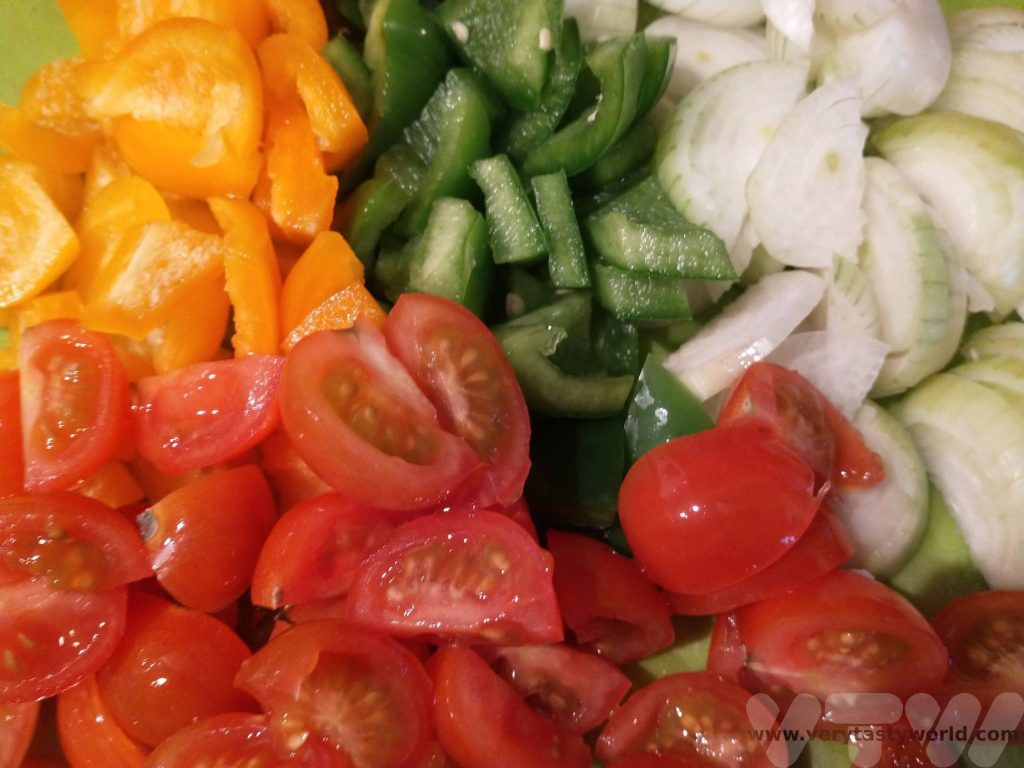
Method
Cook the rice. We use a ratio of 2 cups of water to 1 cup of rice. Our cups are around 150ml in size. Gallo pinto uses long grain rice.
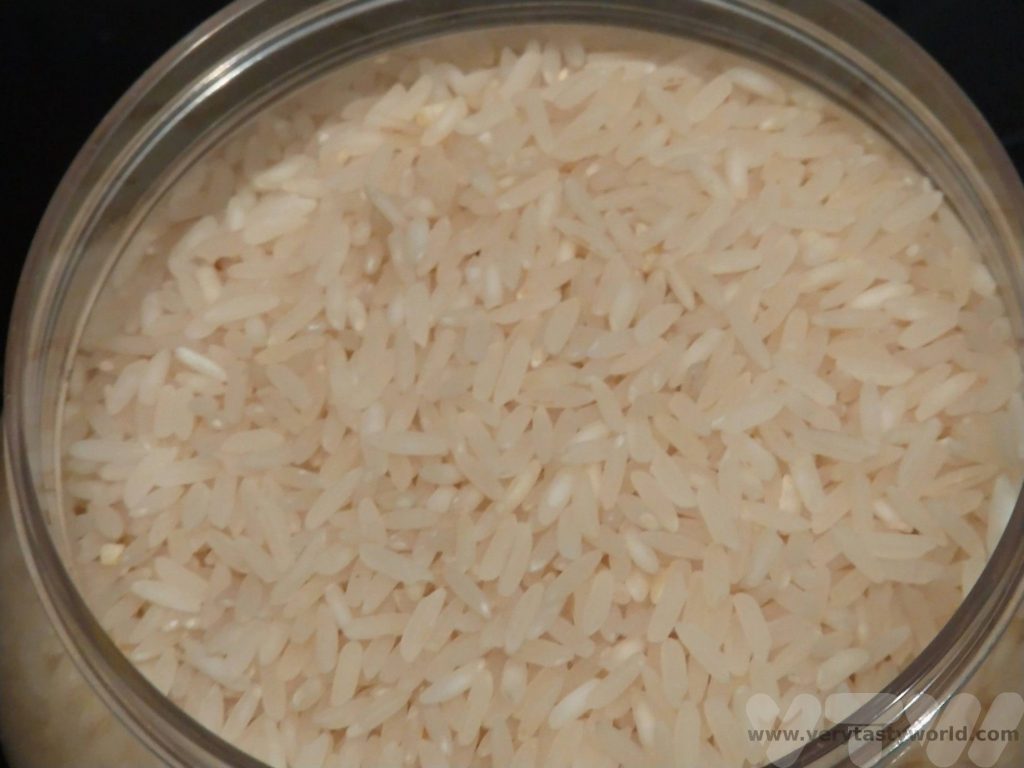
We use a rice cooker which is absolutely brilliant for cooking rice (as well as other things) as we can just bung the rice and water in and set it off. If you don’t have a rice cooker a saucepan is fine – use the same ratio of rice to water. When the rice has absorbed all the water it should be done. It’s absolutely fine to cook the rice well in advance and let it cool, in fact, it’s probably better not to put hot rice into the gallo pinto. Sometimes if we’re having a meal with rice the day before, we’ll make extra rice and let it cool down so that we can have gallo pinto the next day.
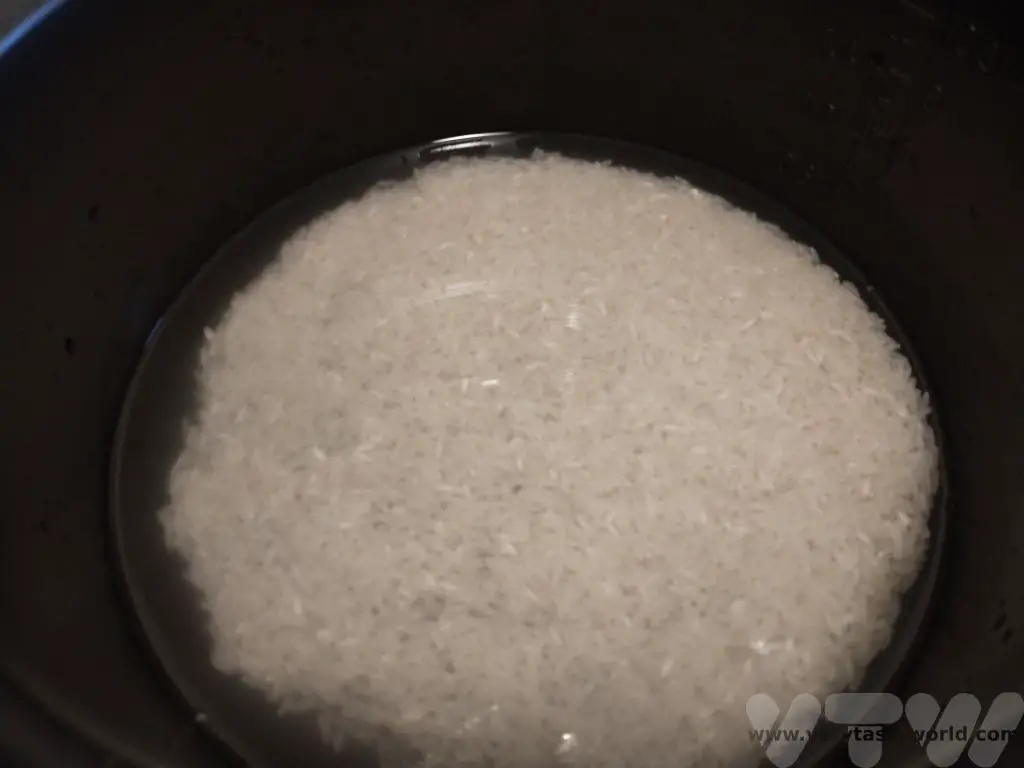
When ready to make the gallo pinto, gently fry the garlic in oil and add the cumin. Then add the rice and stir through.
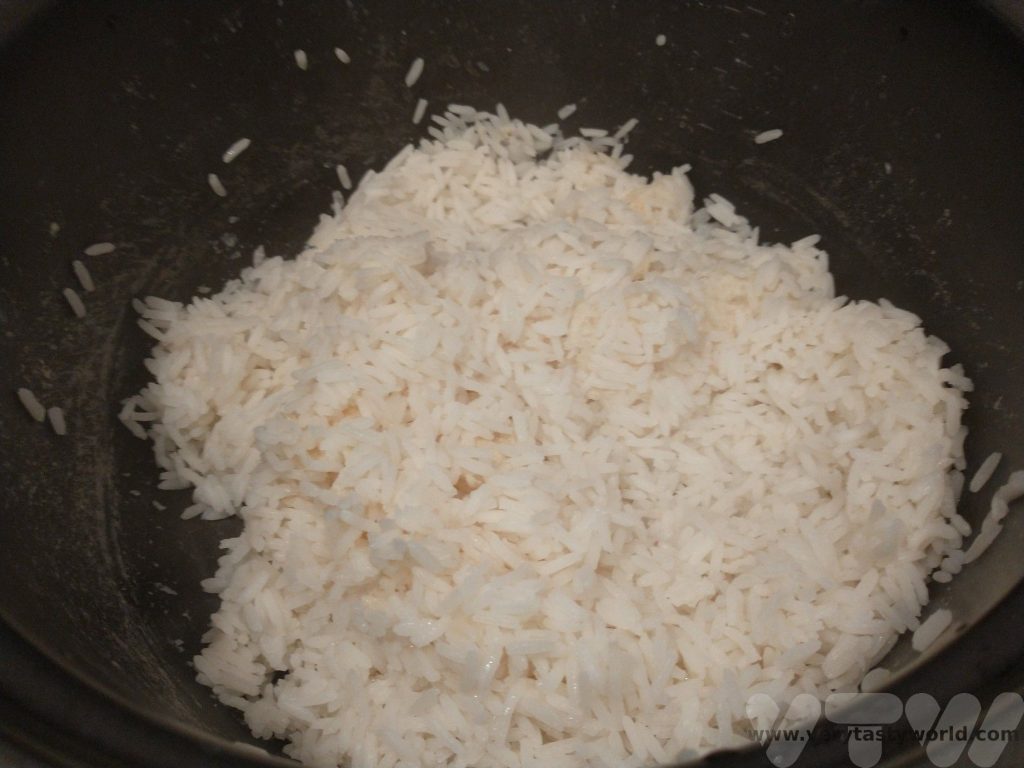
Open the tin of black beans and add the entire contents – including the water.
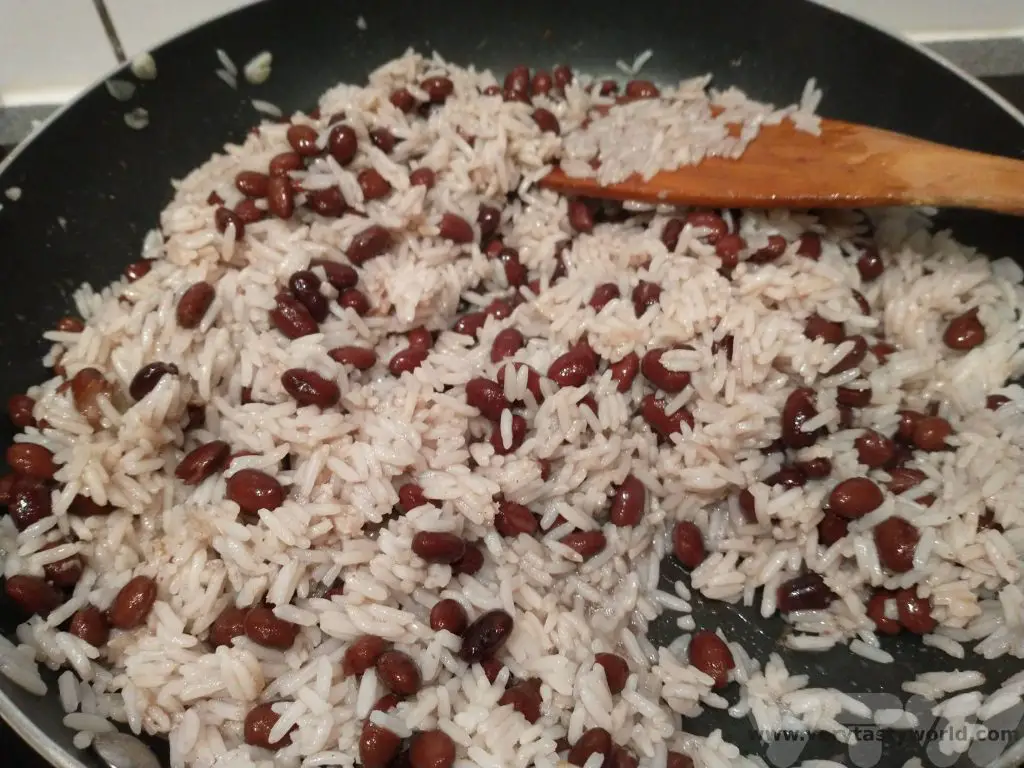
Add 2 Tbs of Lizano sauce.
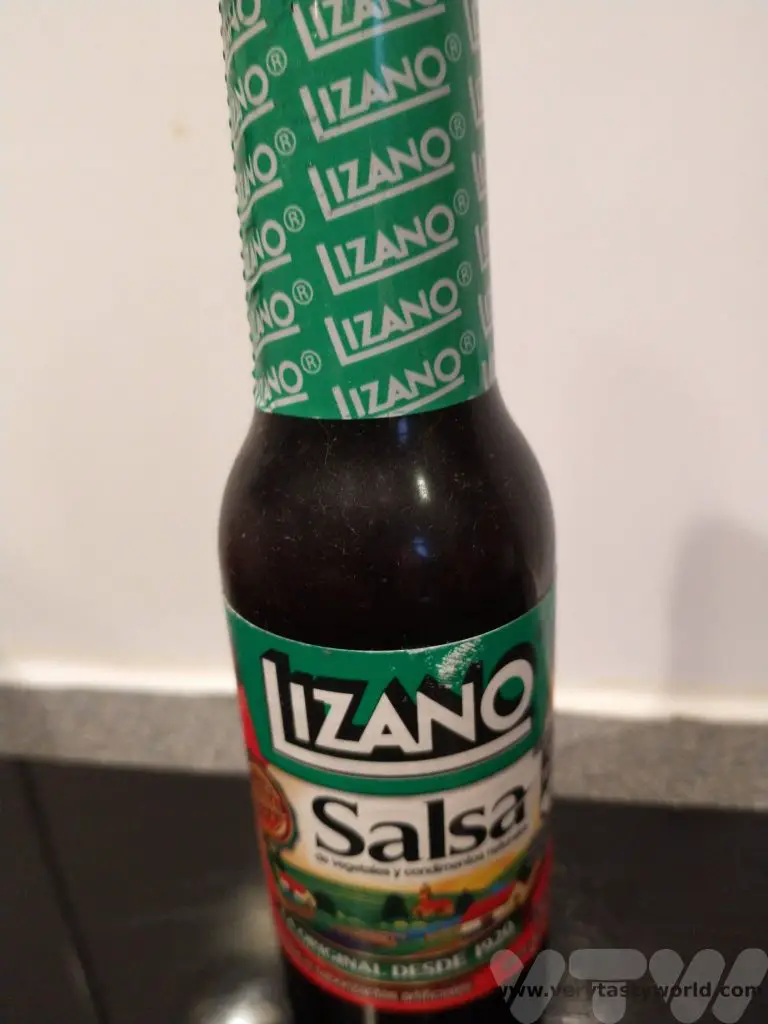
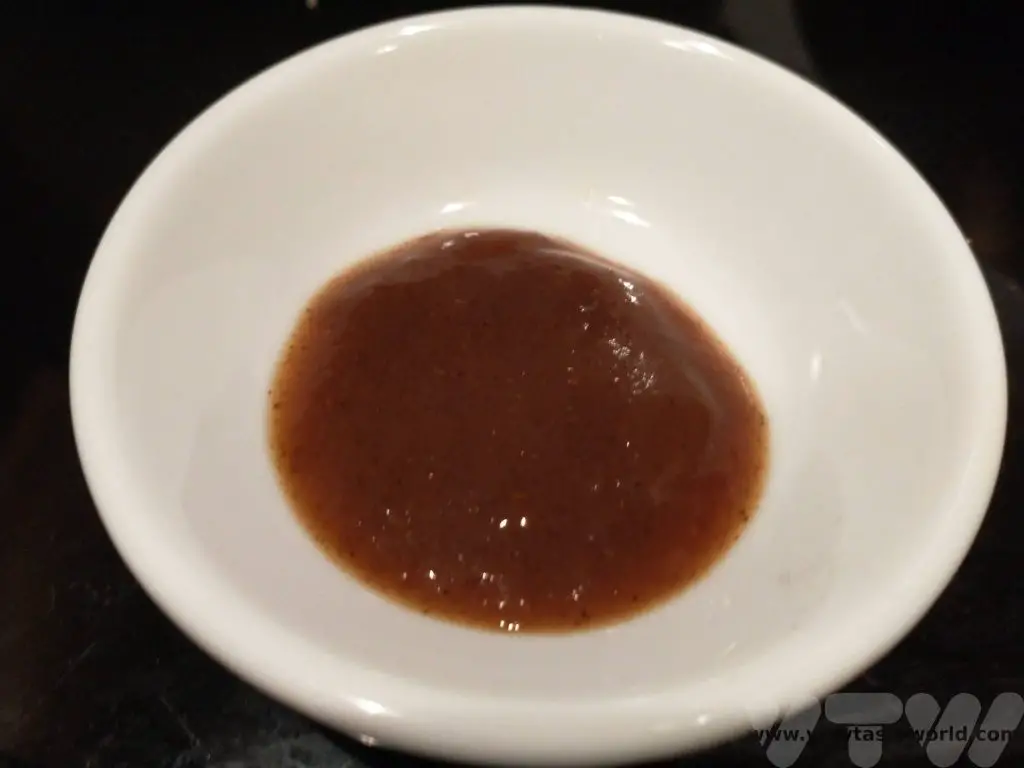
If you can’t get Lizano you can make a reasonable approximation by mixing brown sauce and Worcestershire sauce with spices: 1 Tbs brown sauce, 2 tsp Worcestershire sauce, 1/2 tsp cayenne pepper, 1 tsp celery salt.
Mix it all together gently.
Let the gallo pinto keep warm on a low heat while you fry an egg for each person.

Garnish with chopped coriander.
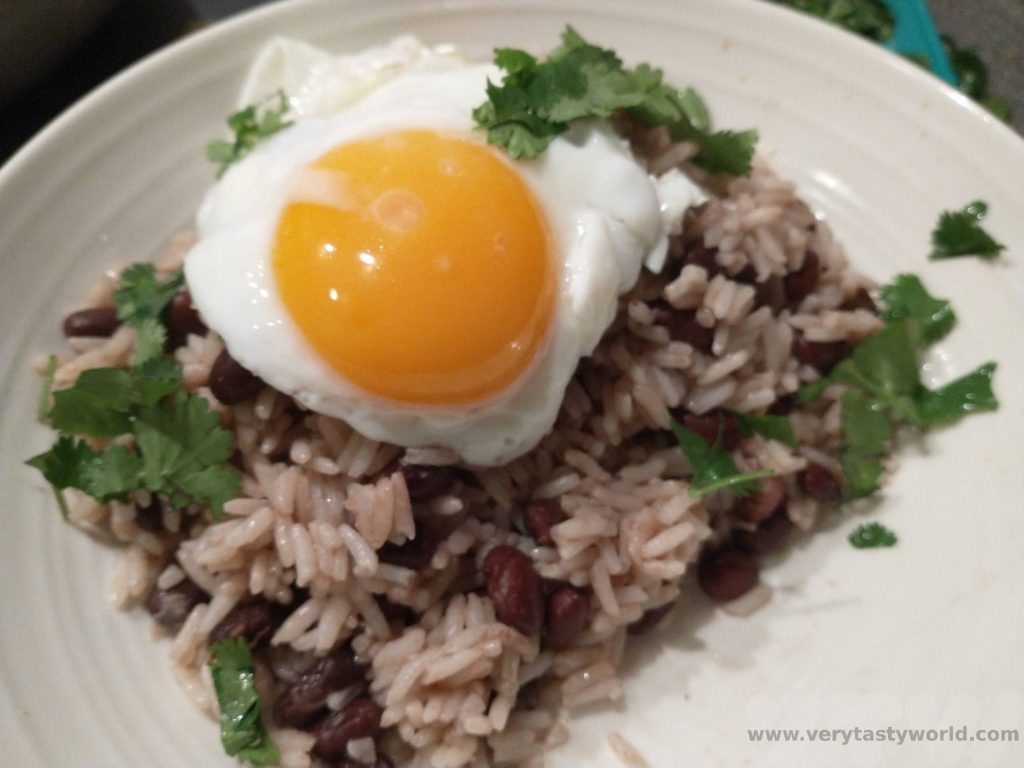
For a more complete meal, stir fry some vegetables and serve alongside the gallo pinto.
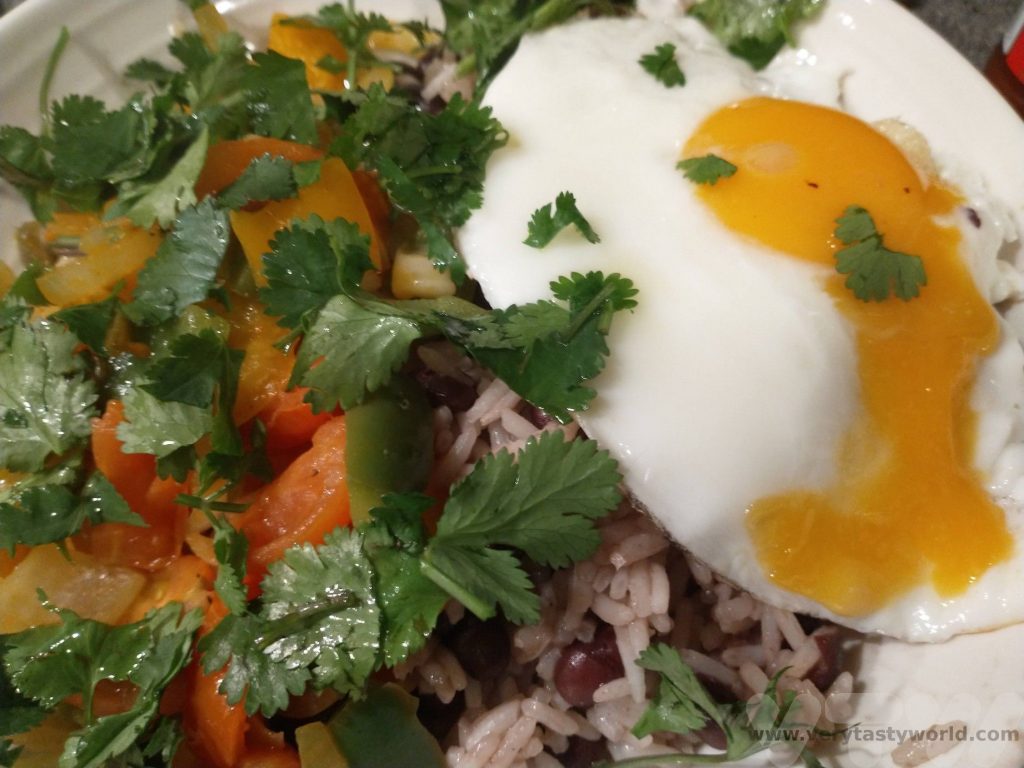
Alternative – at the garlic frying step, add chopped vegetables such as onion or bell pepper and stir into the gallo pinto itself.
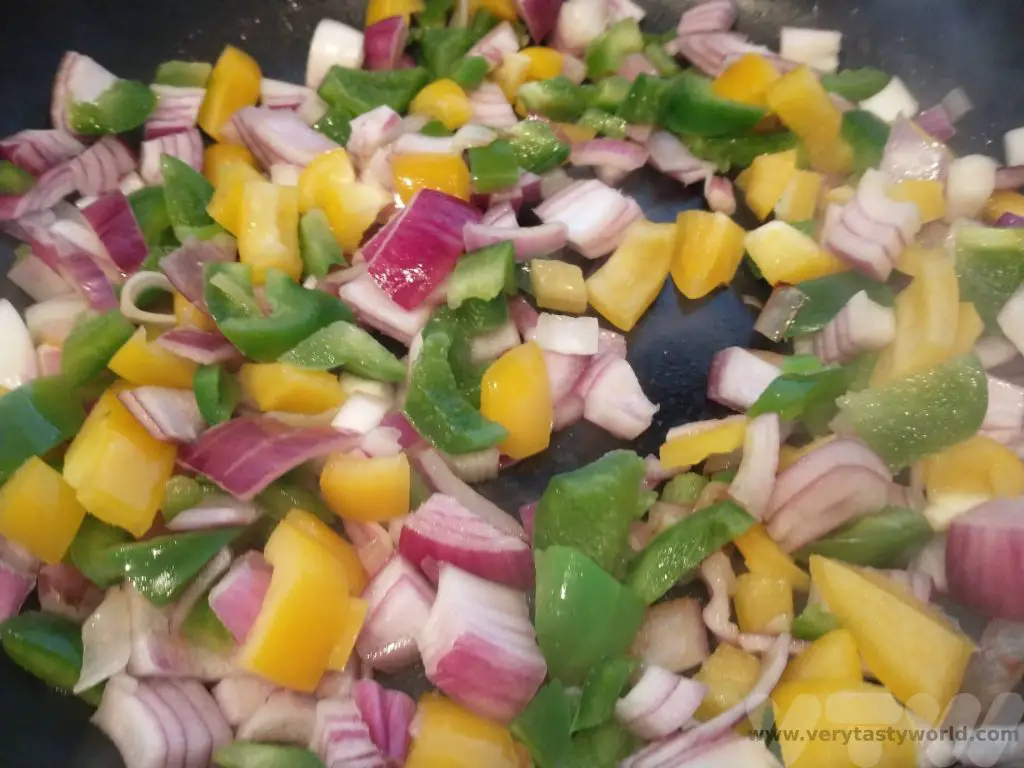

Gallo pinto can be eaten as a meal in itself but can also accompany other dishes. We enjoyed it with steaks, sausages and fried plantain amongst many other delicious ingredients.
Related Posts You May Enjoy

- Best Time To Visit Machu Picchu 2024 Update
- A 2 Week Patagonia Itinerary
- Day of the Dead in Campeche
- A Galapagos Land Based Itinerary
- RECIPE: How to Make Costa Rica’s Gallo Pinto
- A Tasty Puebla Food Tour
- Costa Rica Wildlife Sanctuary – Caño Negro
- Visit Torres del Paine National Park in Patagonia
- Atacama Desert Itinerary

- RECIPE Oyakodon Donburi
- Zero Waste Recipes Before Your Holiday
- RECIPE: Vegetable Biryani Tamil Nadu Style
- RECIPE: Vegan Wild Garlic Pesto
- Recipe: Venetian Pasta Sauce
- RECIPE: Biryani Raita Recipe
- RECIPE: How to Make Costa Rica’s Gallo Pinto
- Recipe: Japanese Simmered Pork Belly – Buta no Kakuni
- RECIPE: How to Make Umeboshi
Recipe: Japanese Simmered Pork Belly – Buta no Kakuni
Japanese simmered pork belly, known as buta no kakuni, is a rich, indulgent dish that is sweet, savoury, sticky and utterly sumptuous. Pork belly is a really fatty cut of meat but fat means flavour and the process of cooking the pork for a long time ensures that a lot of the fat will melt away. Any fat that remains is soft and juicy.
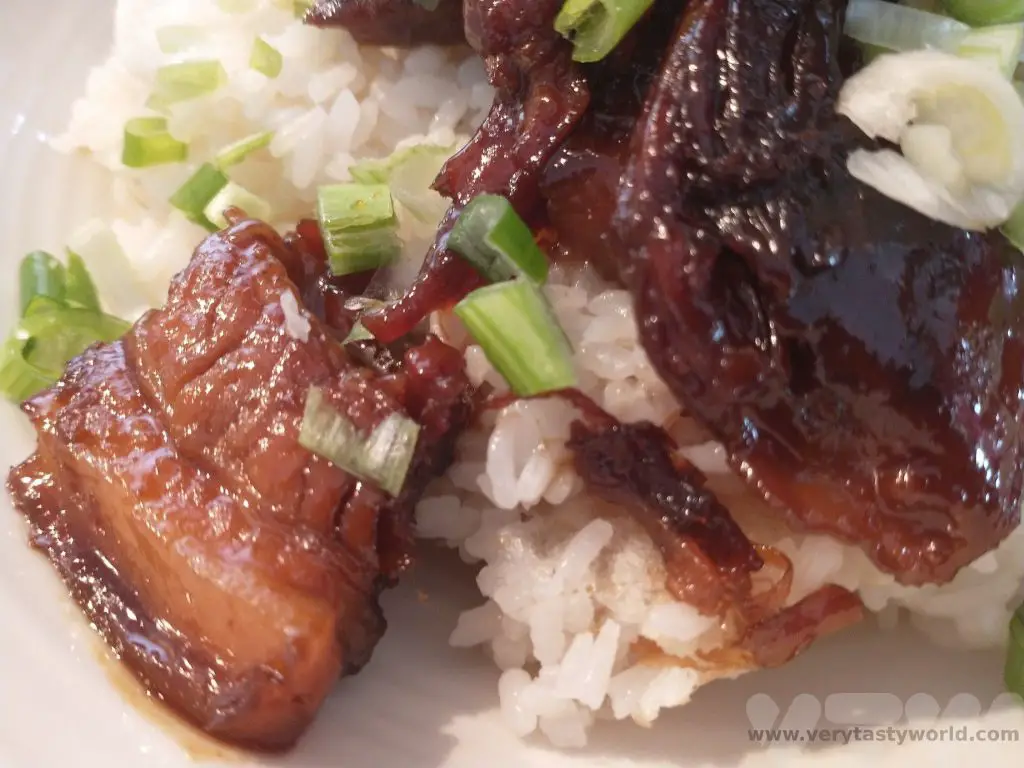
In Japanese, buta means pork and kakuni derives from two longer words: kaku- to cut into cubes and ni – simmer.
It is traditional to serve kakuni with a drop of Japanese mustard called karashi (辛子 or からし). Karashi is a bit darker yellow than most other mustard. It does not really have much acidity in it (unlike other mustards) and very hot. It is perhaps closest to hot English mustard, which is a good substitute.
How to Make Buta No Kakuni Japanese Simmered Pork Belly (Serves 2)
Ingredients
Portion of pork belly per person (allow around 150-200g per person depending on how hungry you are)
Water
Stock cube – dashi stock if possible or you can make your own
2 spring onions, sliced into 2-3cm chunks plus another for garnish
2 inches of ginger, peeled and cut into strips
16 tbs (1 cup) of water
4 tbs (1/4 cup) soy sauce
4 tbs (1/4 cup) cooking sake (if you can’t get sake, white wine will be a good substitute)
4 tbs (1/4 cup) caster sugar
4 tbs (1/4 cup) mirin (if you can’t get mirin, add a little more sake and sugar)
Generous splash of rice vinegar (we like this to counterbalance some of the sweetness of the dish)
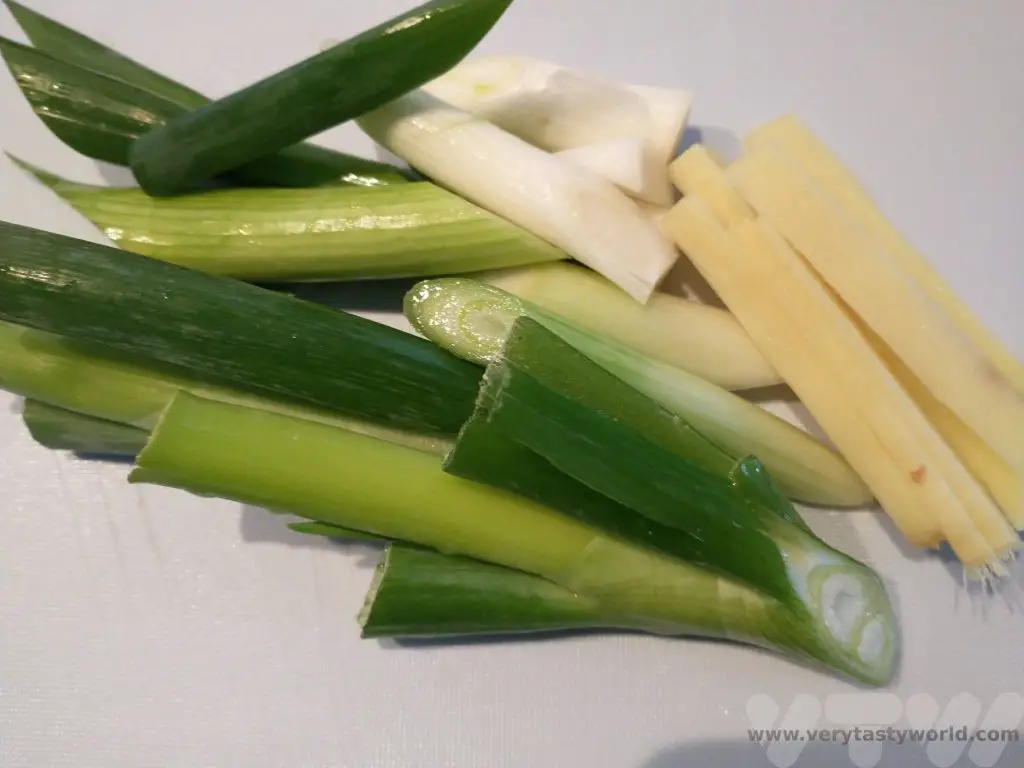
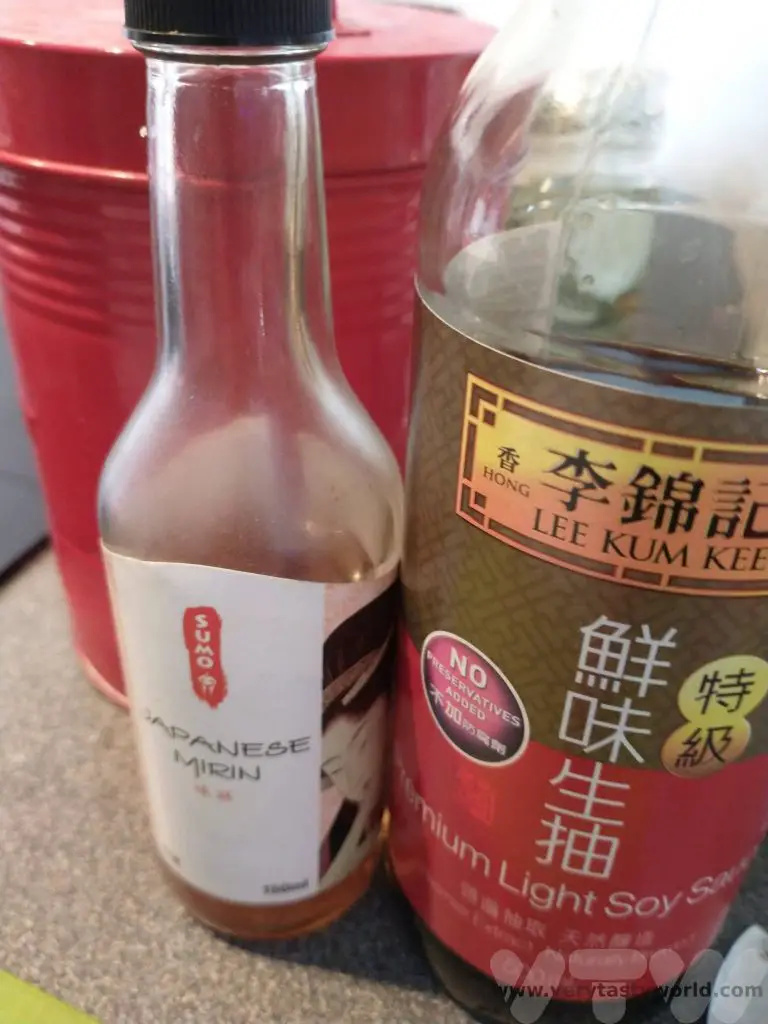
Method
Place the pork belly in a frying pan and sear on both sides for a couple of minutes.
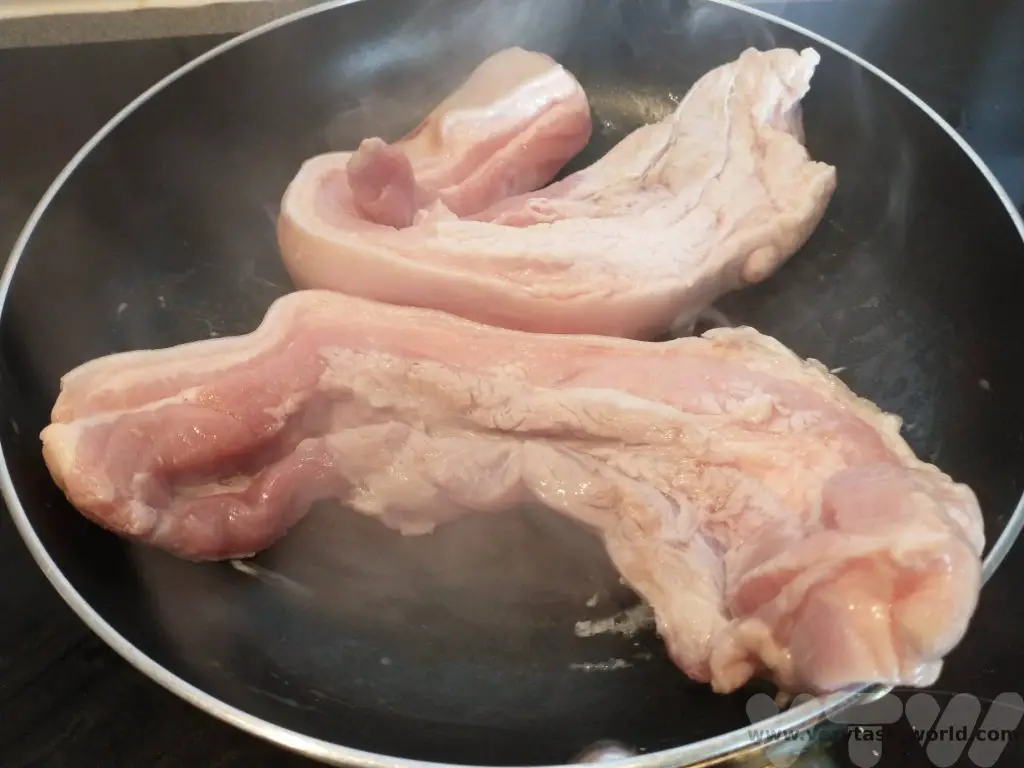
Place the pork belly in a pot and cover with water. Add the stock cube, spring onion and ginger. Turn on the heat and bring the water up to a simmer. Simmer the pork for 2 hours or until nice and tender. Alternatively, you can do as we do and use a pressure cooker. Just prepare the pork as above and cook at pressure for 40 minutes.
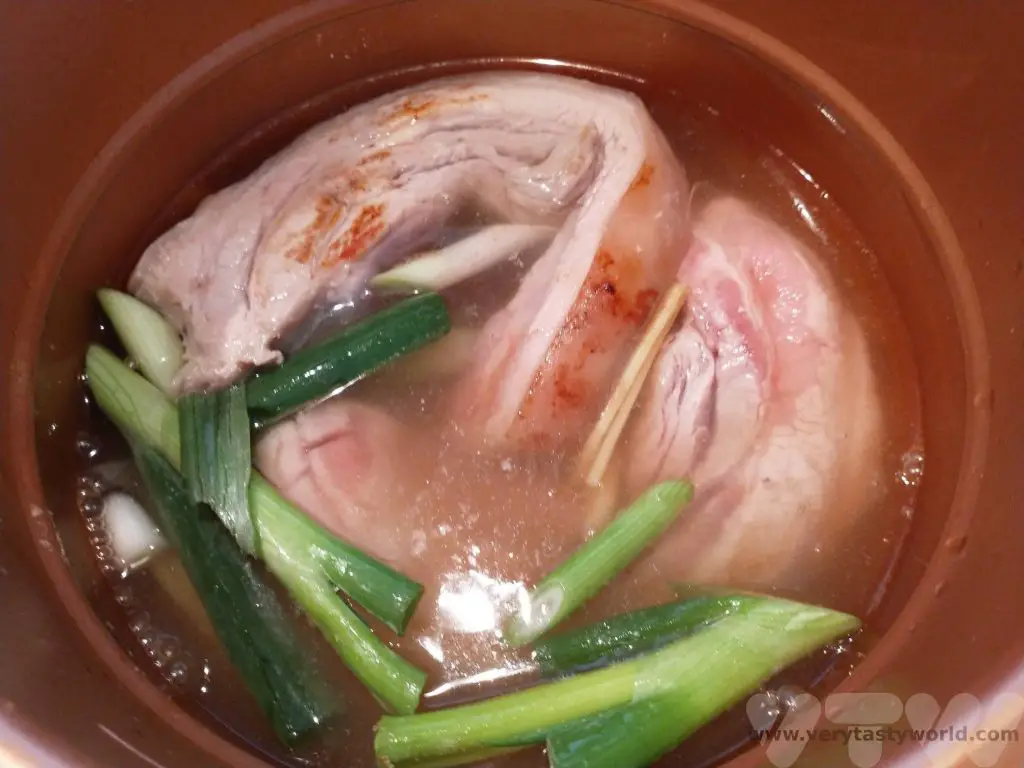
When the pork comes out it should be wonderfully soft and close to falling apart (but not actually falling apart). Cut the pork into chunks – about 2cm length. We also decided to cut off the rind at this stage.
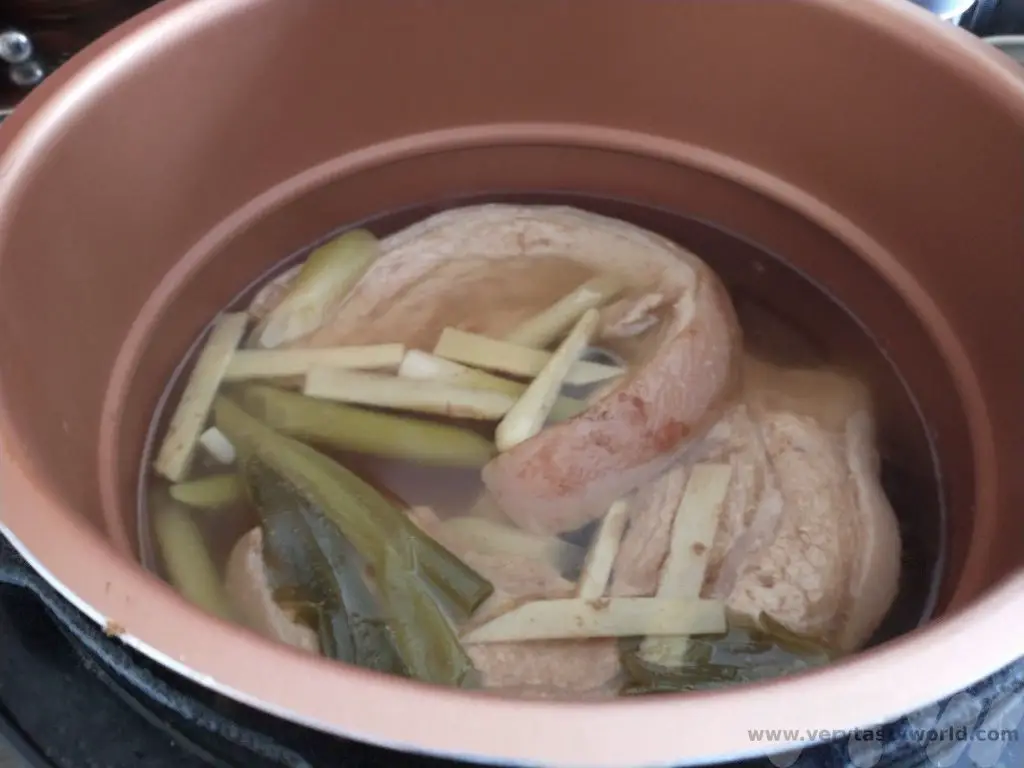
Don’t forget to keep the stock – it will make a wonderful base for ramen noodles or soup. You can pop it into the freezer if you’re not going to use it immediately.
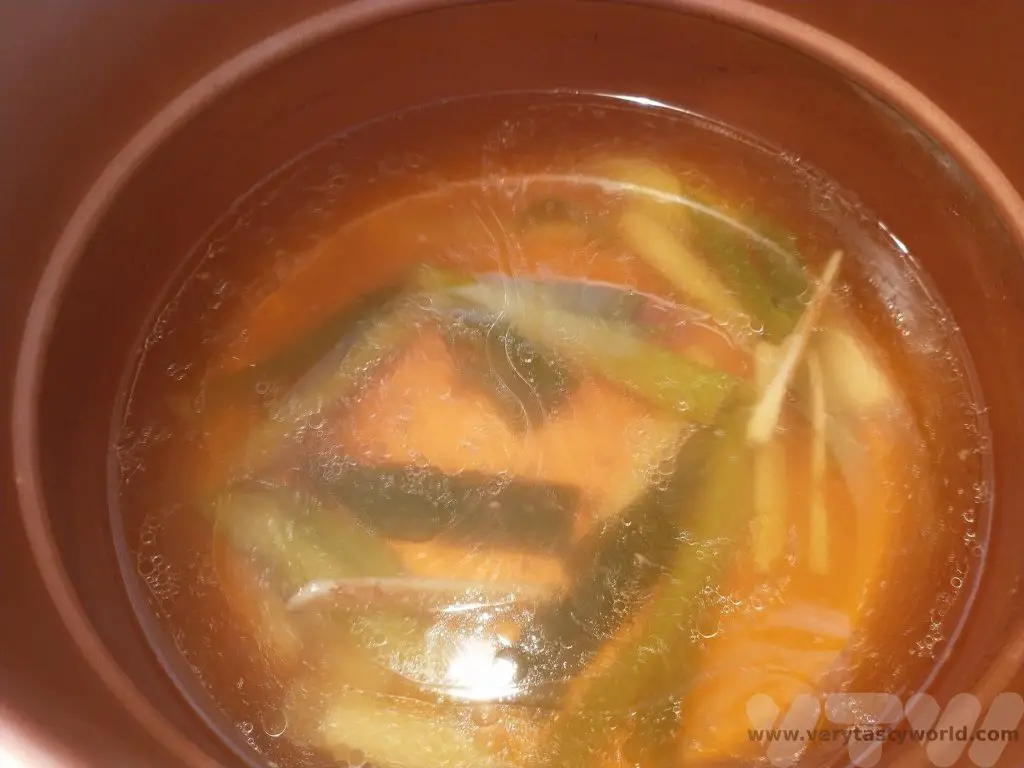
Put the water, soy sauce, sake (or wine), mirin and sugar into a pan and bring to the boil.
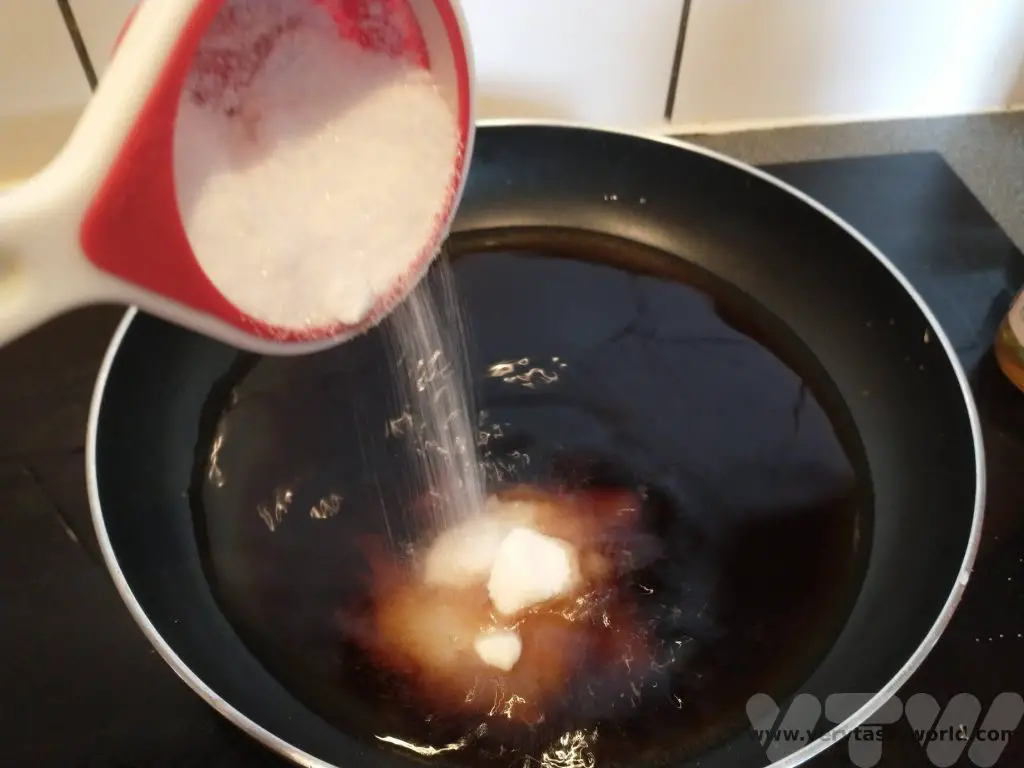
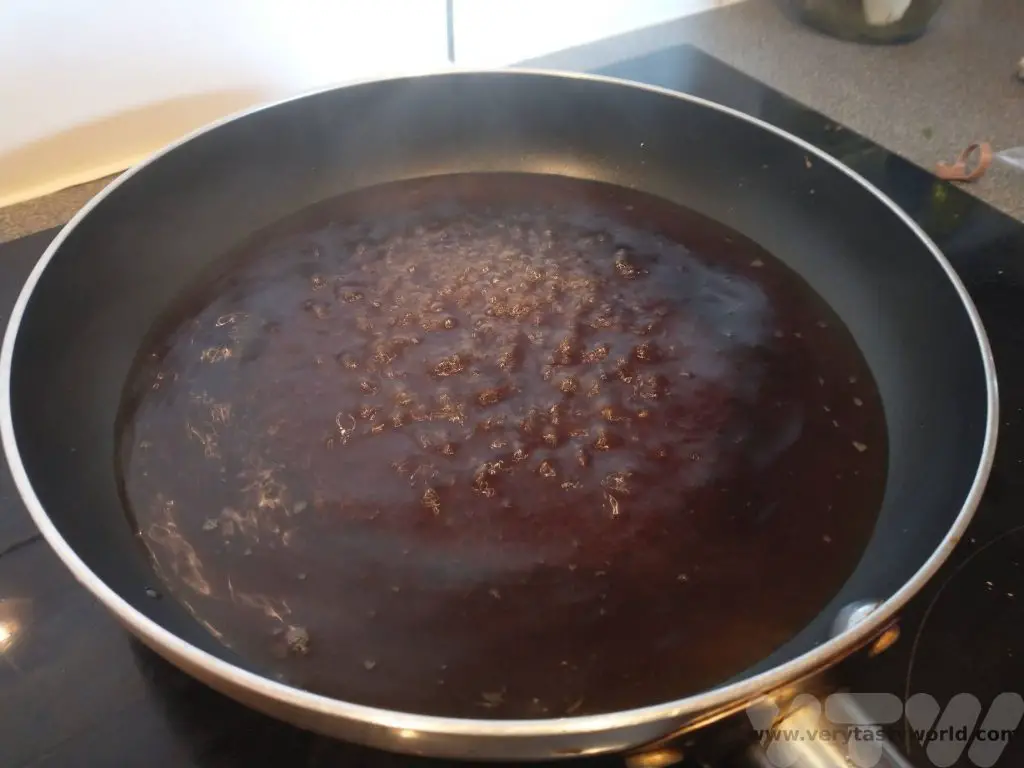
Carefully place the pork chunks into the pan and press down so that the sauce completely covers them.
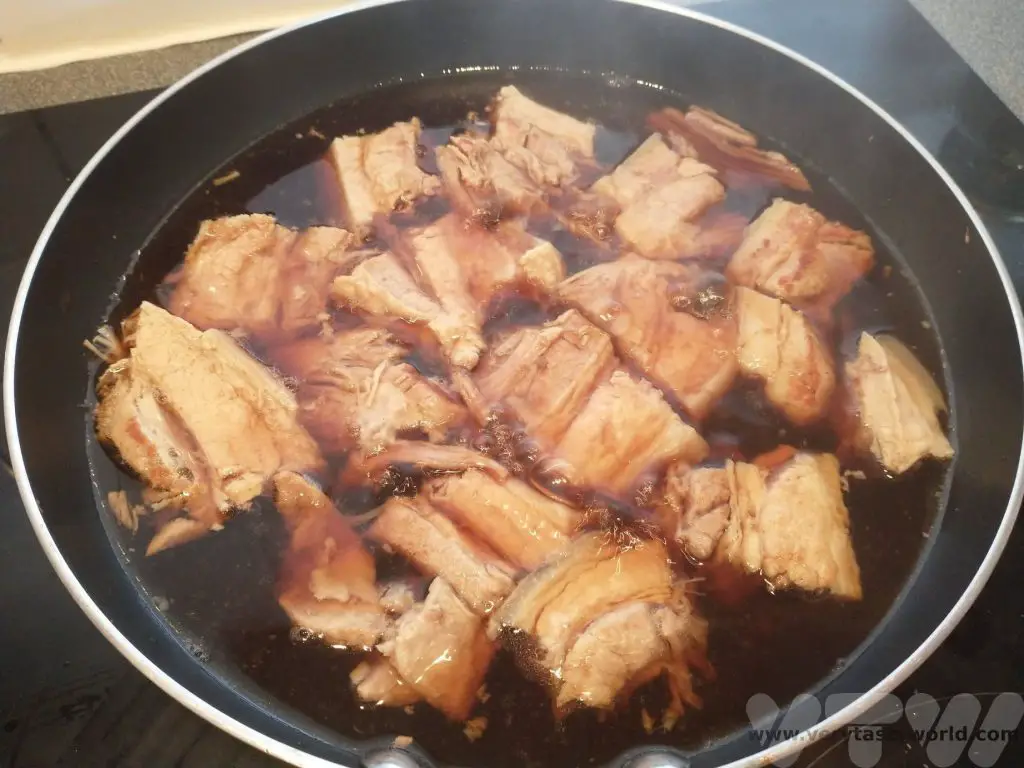
(In retrospect we should have put the pork into a deeper pan – a casserole dish – because the sauce did splutter a lot and because there was sugar in it, it stuck to our hob which made clearing up a bit of a nightmare!)
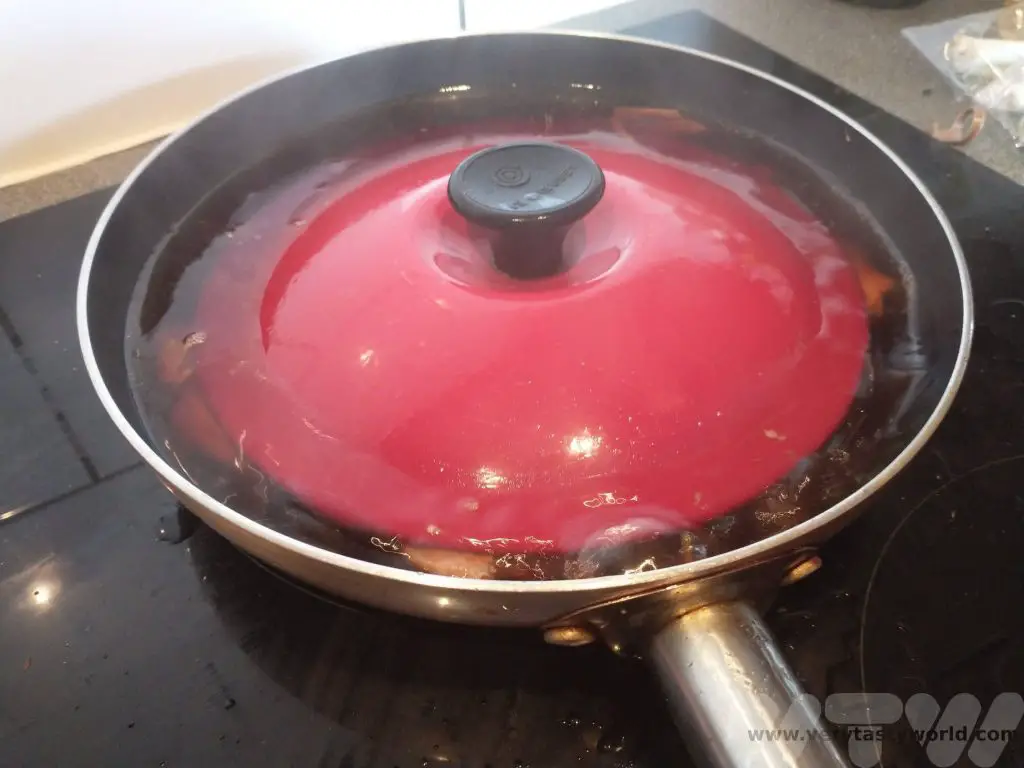
Reduce the sauce until it has almost become a paste – it will have coated the pork and caramelised on the underside. It will look glossy and luscious.
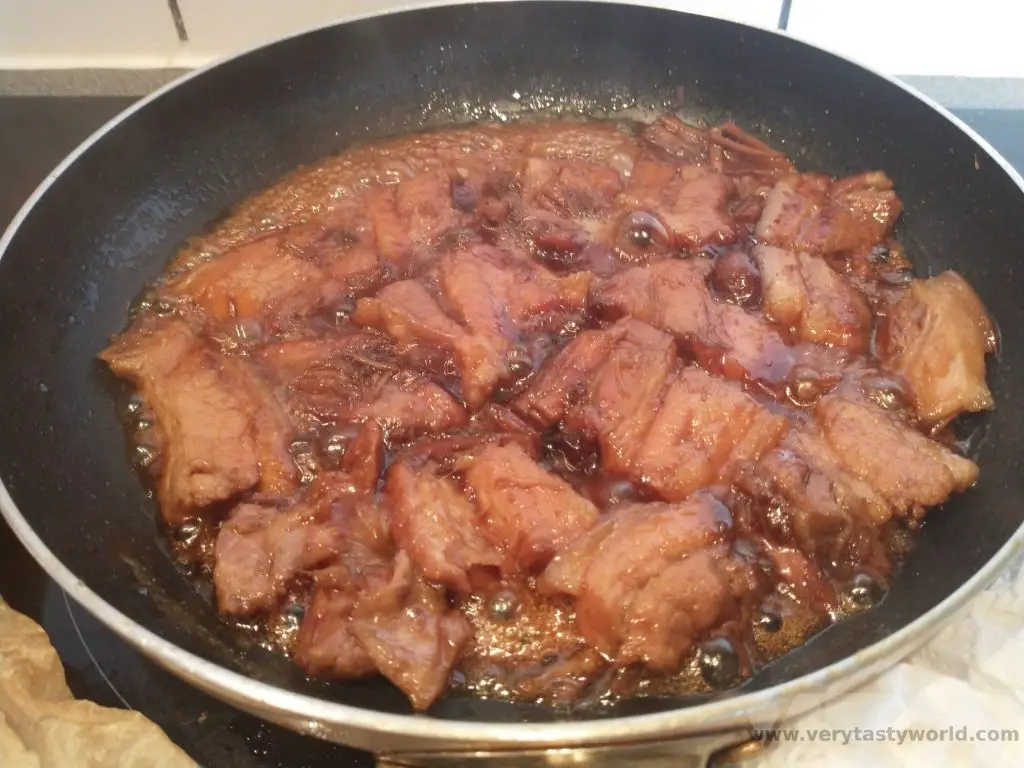
Serve atop plain white rice garnished with chopped spring onion. It is often accompanied with a splodge of karashi. We like adding some pickled ginger as well.
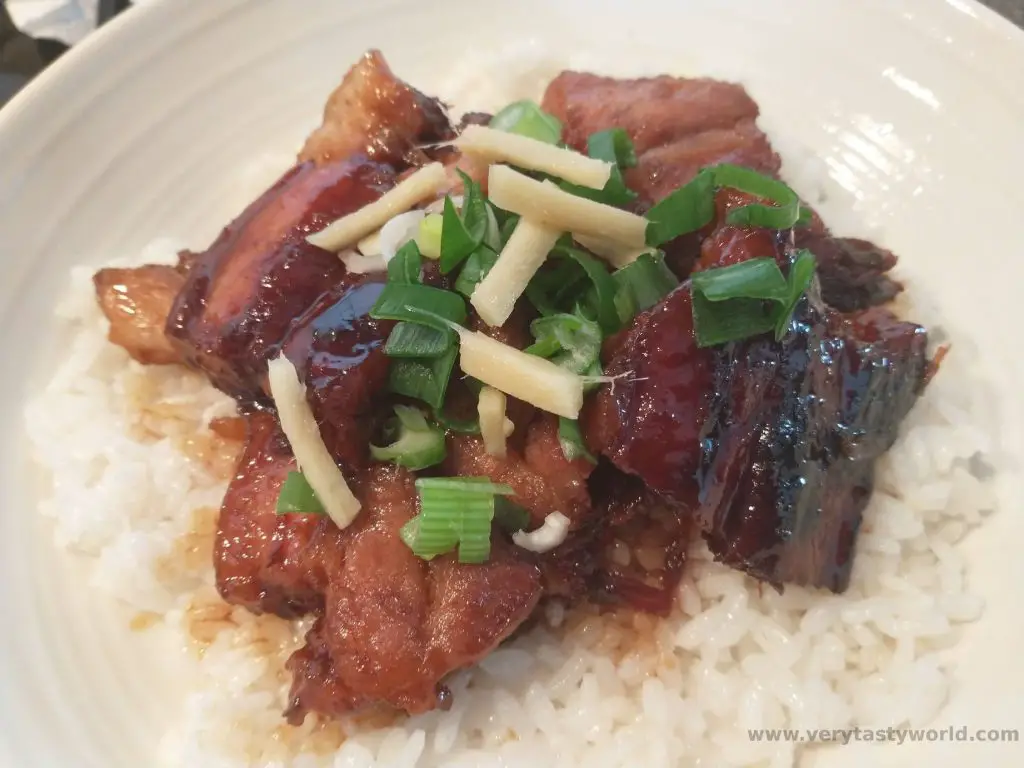

- RECIPE Oyakodon Donburi
- Zero Waste Recipes Before Your Holiday
- RECIPE: Vegetable Biryani Tamil Nadu Style
- RECIPE: Vegan Wild Garlic Pesto
- Recipe: Venetian Pasta Sauce
- RECIPE: Biryani Raita Recipe
- RECIPE: How to Make Costa Rica’s Gallo Pinto
- Recipe: Japanese Simmered Pork Belly – Buta no Kakuni
- RECIPE: How to Make Umeboshi

- Recipe: Simmered Shiitake Mushrooms

- How to Use Public Transport in Japan

- RECIPE Oyakodon Donburi

- Planning a Trip to Japan

- The Makanai: Cooking for the Maiko House

- Setsubun Food – Bean Throwing Day

- The Gassho Farmhouses of Rural Japan

- Recipe: Japanese Simmered Pork Belly – Buta no Kakuni

- RECIPE: How to Make Umeboshi

RECIPE: Japanese Fried Chicken Karaage
Fried chicken is one of life’s great pleasures. And Japanese fried chicken karaage is no exception. In Japan, it is a tradition to eat fried chicken from KFC on Christmas Day before the traditional new year celebrations commence. However, we feel that JFC offers far superior fried chicken.
Always use chicken thigh meat. It has so much more flavour than breast meat and is guaranteed to be juicier and more succulent.

Making karaage isn’t difficult but it also isn’t a quick process. However the results are definitely worth taking the time to make the dish. The chicken absolutely needs to be marinated – this adds so much flavour. The word karaage refers to the cooking technique, that is frying the food in oil. You don’t need equipment such as a deep fat fryer – a frying pan will be just fine.
Recipe for Japanese fried chicken karaage:
Ingredients
Serves 4
800g boneless chicken thigh (skin-on is fine), each thigh cut into 4 pieces
For the marinade
4 tbs soy sauce
1 tbs mirin (if you can’t get this, add a little more sake/wine and a tsp of sugar)
1 tbs cooking sake (or white wine if you can’t get that)
1 inch of ginger (finely grated)
1-2 cloves of garlic (finely grated) depending on how garlicky you like your food
For the coating
Potato starch. If you can’t get this, fine rice flour or even cornflour will be fine. (Icing sugar would not!) We didn’t have quite enough potato starch so mixed in a little rice flour. About a cup’s worth (275ml) – as much as you need to coat all the chicken.
For the cooking
Vegetable oil (enough to get about 1 cm depth of oil in your pan)
Method
Place the chicken thigh pieces in a bowl and add the soy sauce, mirin, sake, ginger and garlic. Mix well and leave to marinate for at least an hour.
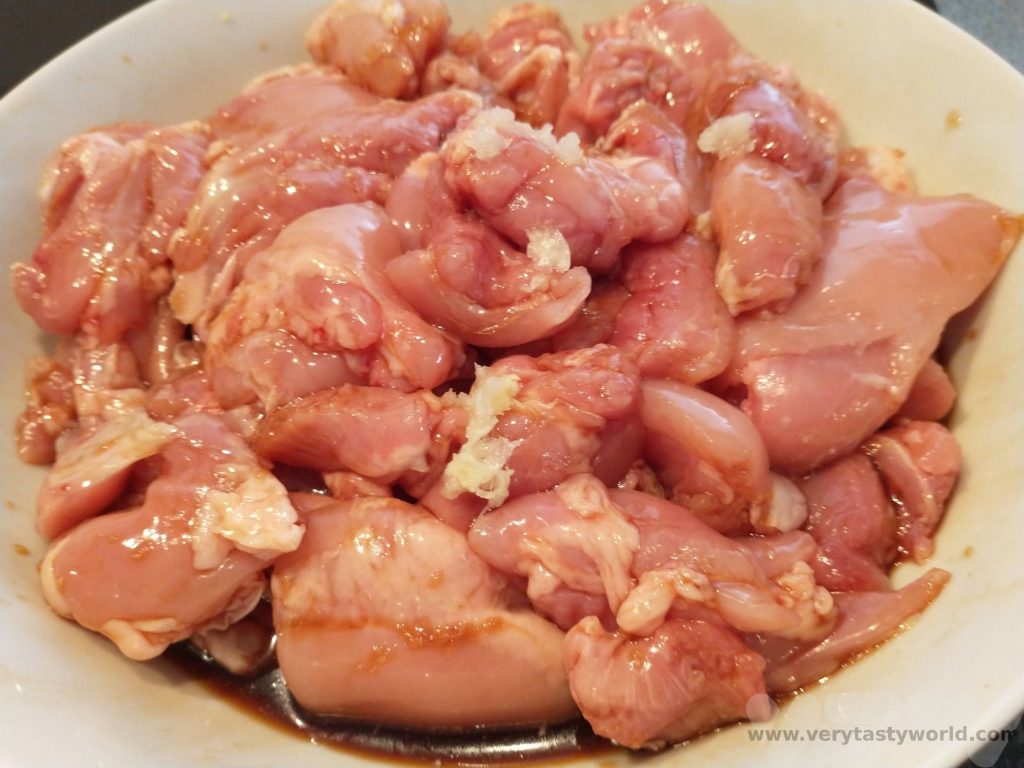
Pour the oil into a frying pan until it’s about 1 cm deep. Heat up. The oil will be hot enough when you put a little flour into it and it sizzles.
When the chicken has had a chance to acquire those lovely flavours pour the potato starch into a bowl.
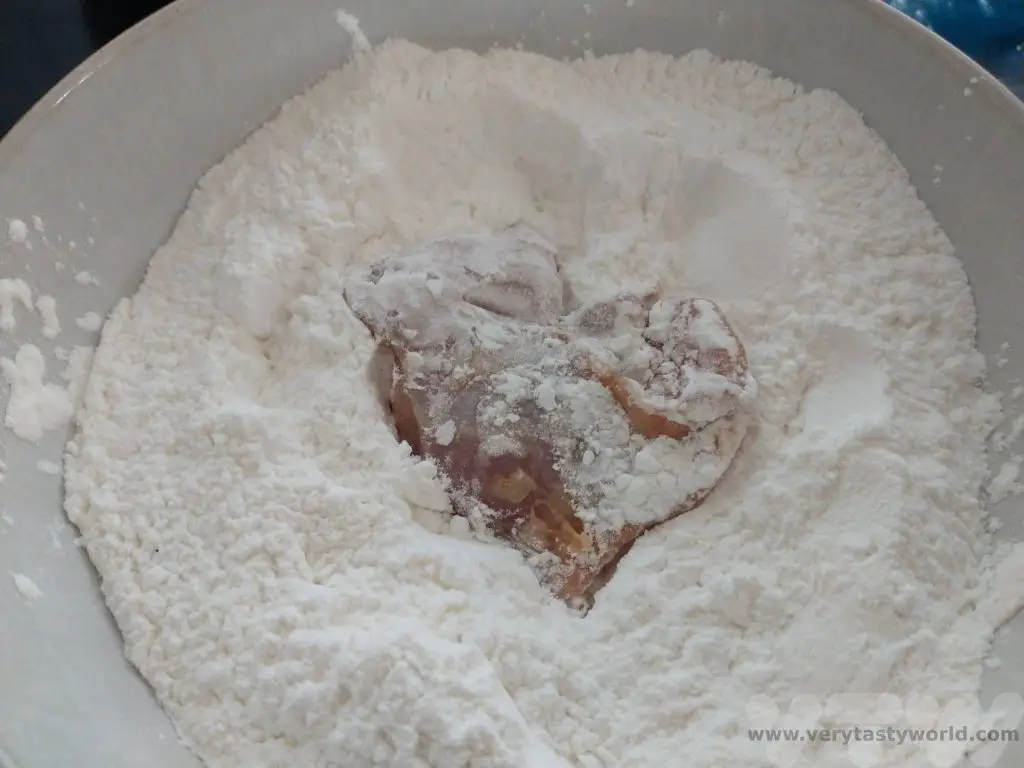
Take each piece of chicken, dip both sides in the flour, shake any excess off, and then carefully place in the oil.

Repeat for further pieces of chicken. Do not overfill the pan – this is a process whereby the chicken should be cooked in batches. We tend to use a clock method – put a piece of chicken at the top, then go round the pan putting further pieces in in a clockwise direction so we know which piece was put in first. Cook the chicken for 5-7 minutes, turning occasionally, until the pieces are golden brown.
Then remove from the oil and place on kitchen paper to soak up excess oil. You can transfer the chicken from the first batches into a heatproof bowl in the oven set on a low heat to keep them warm.

Start the next batch and repeat until all the chicken has been cooked.
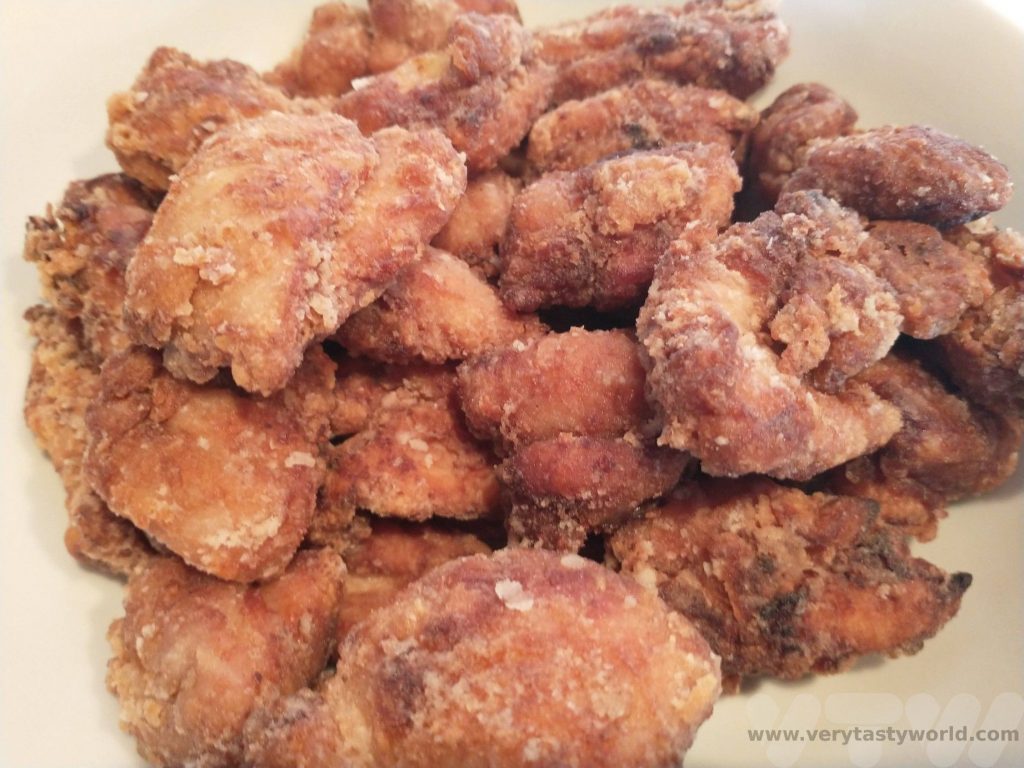
Serve with Japanese mayo. It’s not at all healthy but it’s oh, so decadent and delicious! If you’re feeling more health conscious, shredded cabbage is a popular accompaniment.

Karaage chicken is also yummy when served cold the following day. It often features in bento boxes.
Related Posts You May Enjoy

- RECIPE Oyakodon Donburi
- Zero Waste Recipes Before Your Holiday
- RECIPE: Vegetable Biryani Tamil Nadu Style
- RECIPE: Vegan Wild Garlic Pesto
- Recipe: Venetian Pasta Sauce
- RECIPE: Biryani Raita Recipe
- RECIPE: How to Make Costa Rica’s Gallo Pinto
- Recipe: Japanese Simmered Pork Belly – Buta no Kakuni
- RECIPE: How to Make Umeboshi
RECIPE: How To Make Wild Garlic Pesto
Spring is a fantastic time of year for walking in the English countryside. The weather is often warmer and the blossom on the trees provides a wonderful backdrop. We even get a bit of sunshine sometimes! It’s also a great time for foraging for the spring greens that start growing – there’s nothing like picking free food whilst on a walk. At the moment, nettles, ground elder, three cornered leek, garlic mustard (aka Jack-by-the-hedge) are all flourishing and they can all be used to create and add flavour to delicious dishes. Wild garlic is our favourite and we have a fabulous recipe for wild garlic pesto.
There are some basic rules to foraging in the UK. You are allowed to pick flowers, fruit and leaves but you are not allowed to dig up roots (e.g. horseradish) unless you have the landowner’s permission. We never take more food than we need.
Wild garlic is an invasive plant and when it grows it spreads wildly, which is fantastic for a forager. It’s usually easy to recognise and has a very definite garlicky smell.

A few weeks after the leaves show through, delicate little white flowers will appear. These are edible too and have a very mild garlic flavour – they make a fantastic edible garnish. The buds can also be pickled and can be used as substitute for garlicky capers.

If you are foraging it is really important that you are 100% sure of what you are picking. Never eat anything if you are not certain about what it is. Many plants are poisonous and some can look very similar to edible species. Beware: there is a plant which looks very similar to wild garlic when it’s young and just peeping through the soil. Arum maculatum, also known as Lords and Ladies, is very toxic. Apparently even putting the leaves into your mouth will result in an immediate burning sensation. It sometimes grows worryingly close to the wild garlic. When it’s more mature it develops shiny arrow-head shaped leaves but when young, looks very similar to wild garlic.


Bluebells, or their white-flowered counterparts, which can also easily be confused with wild garlic’s white flowers, can also grow nearby. Bluebells are extremely pretty but also poisonous.
Whenever we gather wild garlic we go through a process of washing it thoroughly and checking each leaf when we get home.
Wild Garlic Pesto Recipe
This is a recipe that is not at all accurate – it’s one where you can fling the ingredients together and end up with something delicious. Our wild garlic recipe uses cashew nuts instead of pine nuts. They are a lot cheaper and add a lovely creaminess to the pesto.
Ingredients
Bunch of wild garlic leaves
Handful of cashew nuts
Chunk of Parmesan or Grana Padano cheese
Slosh of extra virgin olive oil
Squeeze of lemon
Pinch of salt
Method
Roughly chop the wild garlic leaves and place into a blender. Throw in the nuts. Roughly chop the cheese into chunks and add these. We recommend adding the leaves first – to the bottom of the blender – so that the weight of the nuts and cheese ensures they get chopped up more finely.
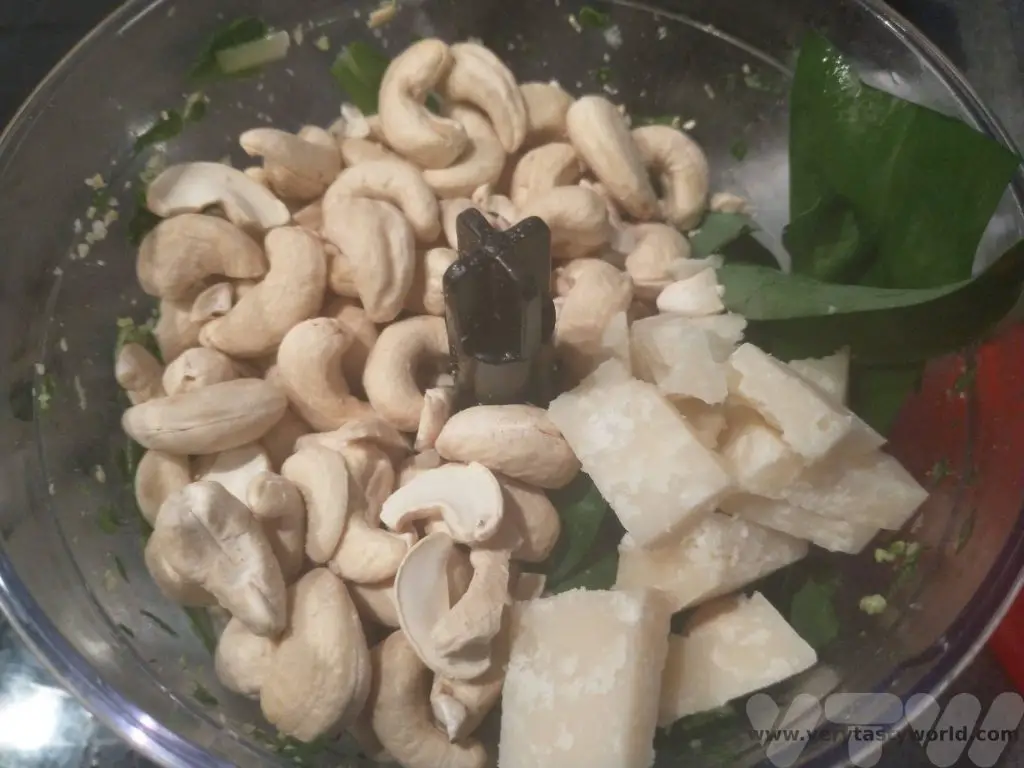
If you are planning to eat the pesto right away, add the oil, lemon juice and salt. The pesto freezes really well but if we are planning to freeze it we don’t add the oil or seasoning; instead we stir it in once it has defrosted.
Blend together until you get the texture you like – smooth or nutty – both work well.
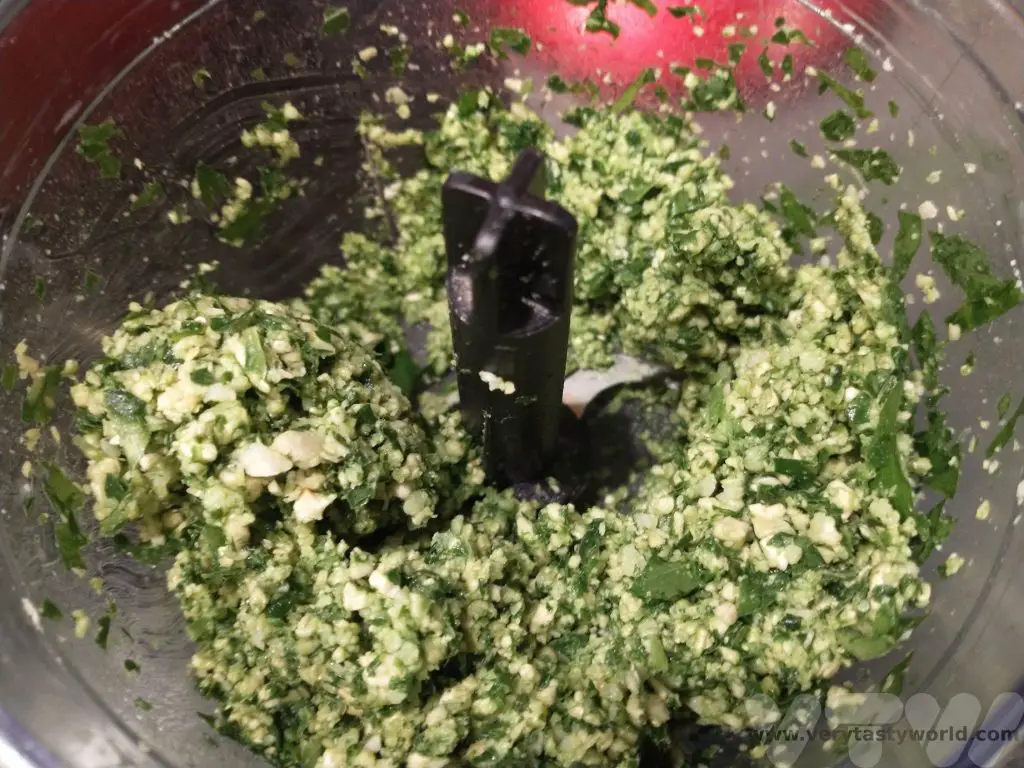
If you are planning to freeze the pesto, decant into containers and pop into the freezer. We recycle plastic takeaway containers as they provide the perfect portion for two people.
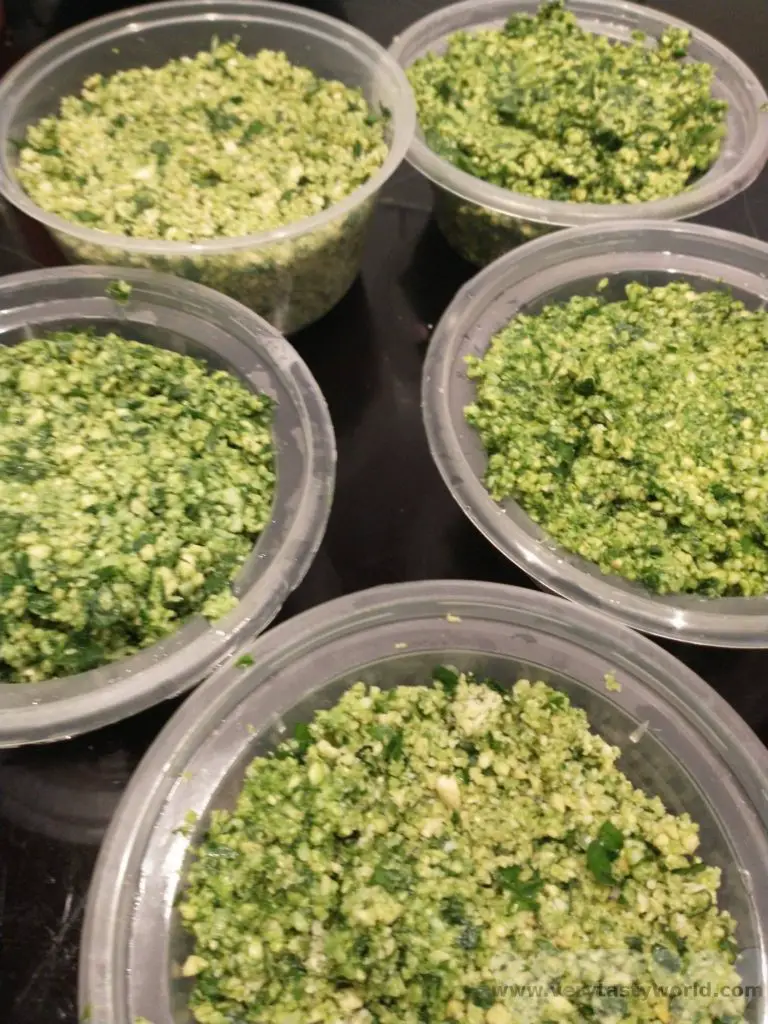
We’ve tried variations using pistachio nuts and nutritional yeast, which can replace the cheese in order to develop a vegan version. Pistachio are more nutty in texture and their flavour is more pronounced in the finished pesto.
The great thing about this recipe is that is so easily adaptable – mix and match ingredients. It’s the underlying gentle garlicky flavour that the wild garlic leaves produce that make this such a brilliant pesto. We’ll be foraging and freezing for as long as the season lasts.
Related Posts You May Enjoy

- RECIPE Oyakodon Donburi
- Zero Waste Recipes Before Your Holiday
- RECIPE: Vegetable Biryani Tamil Nadu Style
- RECIPE: Vegan Wild Garlic Pesto
- Recipe: Venetian Pasta Sauce
- RECIPE: Biryani Raita Recipe
- RECIPE: How to Make Costa Rica’s Gallo Pinto
- Recipe: Japanese Simmered Pork Belly – Buta no Kakuni
- RECIPE: How to Make Umeboshi
RECIPE: How to Make Stinging Nettle Hummus
If there’s one thing that can ruin a walk in the lovely English countryside it’s stinging nettles. If you brush past them with bare skin you can get a painful sting which usually isn’t harmful for most people but hurts for a while. But you can exact revenge on them by eating them! Nettles are not only edible, they are highly nutritious – they contain iron, calcium and magnesium, as well as vitamins A and B. They are great in soup, can be dehydrated to make crisps, can be used like spinach in a variety of dishes such as stir fries and stews, and can also be used in dips and sauces. The process of cooking with them renders them harmless by getting rid of the sting. One of our favourite things to make with them is stinging nettle hummus and we have a recipe.
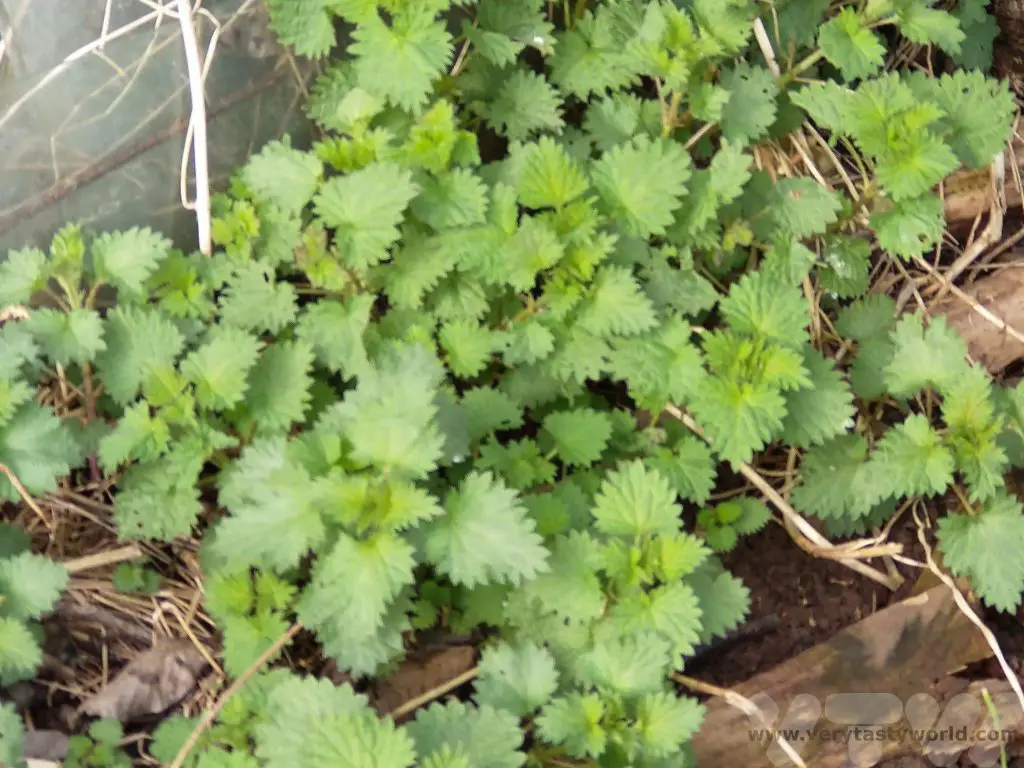
Despite them being found all over the British Isles nettles are not native plants, they were introduced by the Romans a couple of thousand years ago. Some stories suggest that they were used by Roman soldiers who would flog themselves with the nettle plants in order to use the stings to warm their skin in cold northern climes.
If you do get stung by a nettle there is a plant that you can use that helps soothe the pain. The standard view is that a dock leaf rubbed onto the sting will help. Actually it’s a plantain leaf (which used to be called dock in bygone times) which is more likely to help. Rubbing the sting with a dock leaf won’t harm but plantain will provide more relief.
It is the perfect time of year to go foraging for spring greens. We are already keeping an eye on our local patches of wild garlic, ground elder, mustard garlic, sorrel and three-cornered leek to see how they are growing, and also to plan lots of recipes for them. Stinging nettles are absolutely ready right now.
Preparing Stinging Nettles For Hummus
Go foraging for nettles. Try to find a patch where it’s unlikely that dogs may have been walking (just in case they have used that area for a toilet). Hardy foragers pick the nettles with their bare fingers but we use gloves to save ourselves from the stings. It’s best to pick in early spring to get the most tender leaves (the leaves will become quite tough as summer progresses). You need around half a carrier bag’s worth but you don’t need to be precise.
A word of warning – nettles are generally one of the easiest plants to identify but please be 100% sure that you have identified the correct plant. If you have the slightest doubt, don’t eat it. Plant identification apps aren’t always reliable either.
Wearing gloves, wash the nettles and have a look through them to see whether there are any leaves that should be discarded and look out for any insects to brush away. You can also make sure that no extraneous leaves from other plants. It’s quite common for grasses to end up in your bag as well.
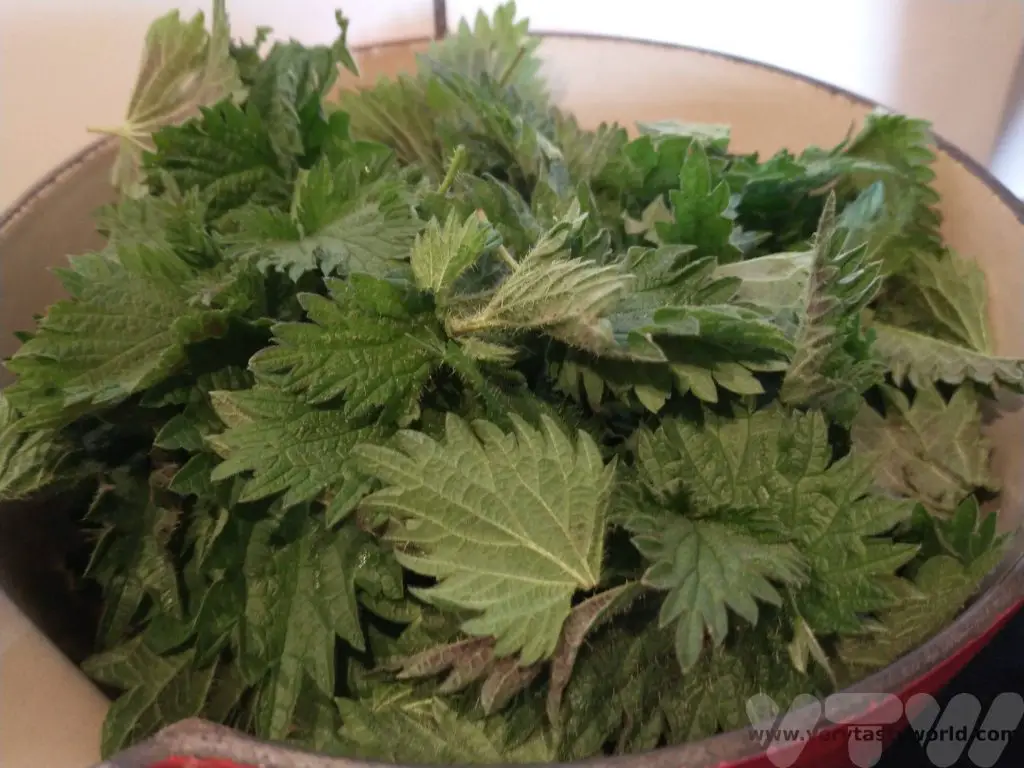
Place the nettles into a saucepan and pour boiling water over them to cover them. Stir for a minute or so. They will start wilting. This process gets rid of the sting and you can handle them with your bare hands from now on.
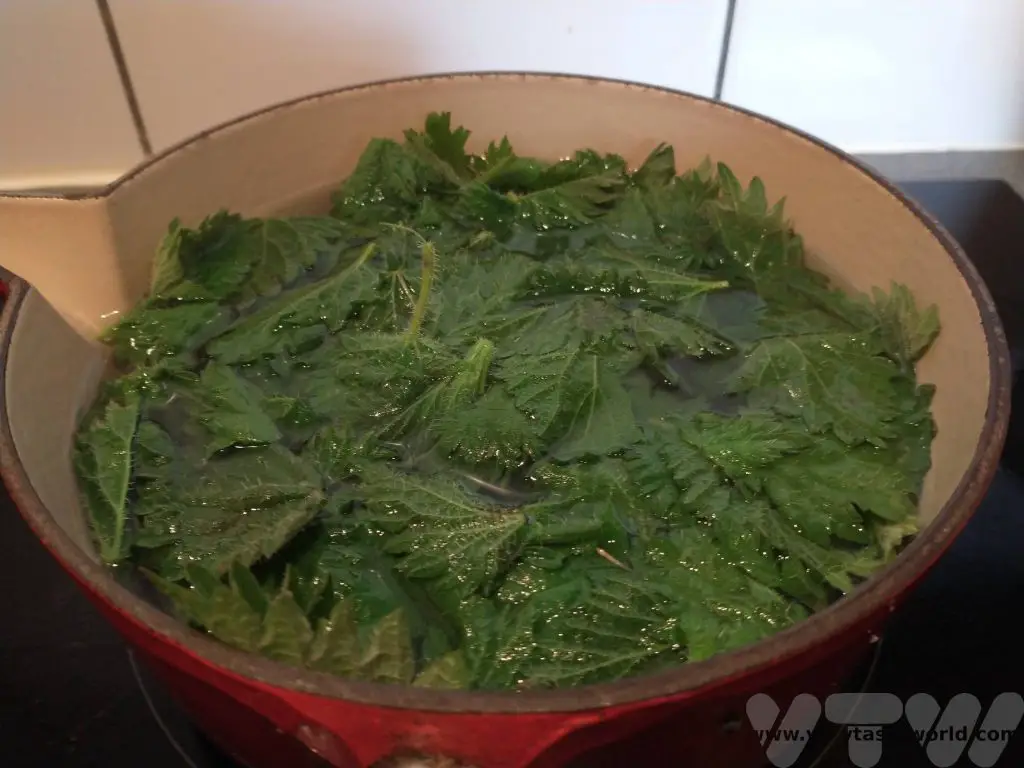
While they still have their lovely green colour, using a slotted spoon, transfer them into a bowl of cold water for a few minutes.
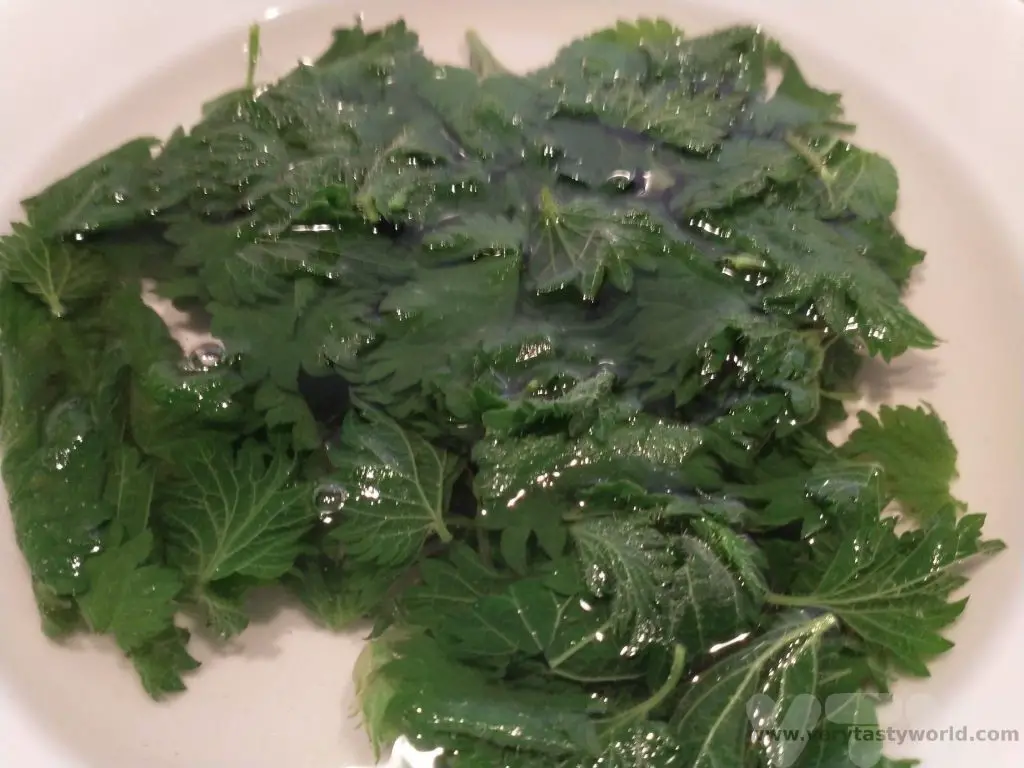
Keep the hot water from the saucepan and pour it into a mug – you can enjoy a nice cup of nettle tea, which has a mild, refreshing flavour and tastes a bit like green tea or coca tea. Then drain the nettles and let them dry naturally. They can then be used in our stinging nettle hummus recipe.
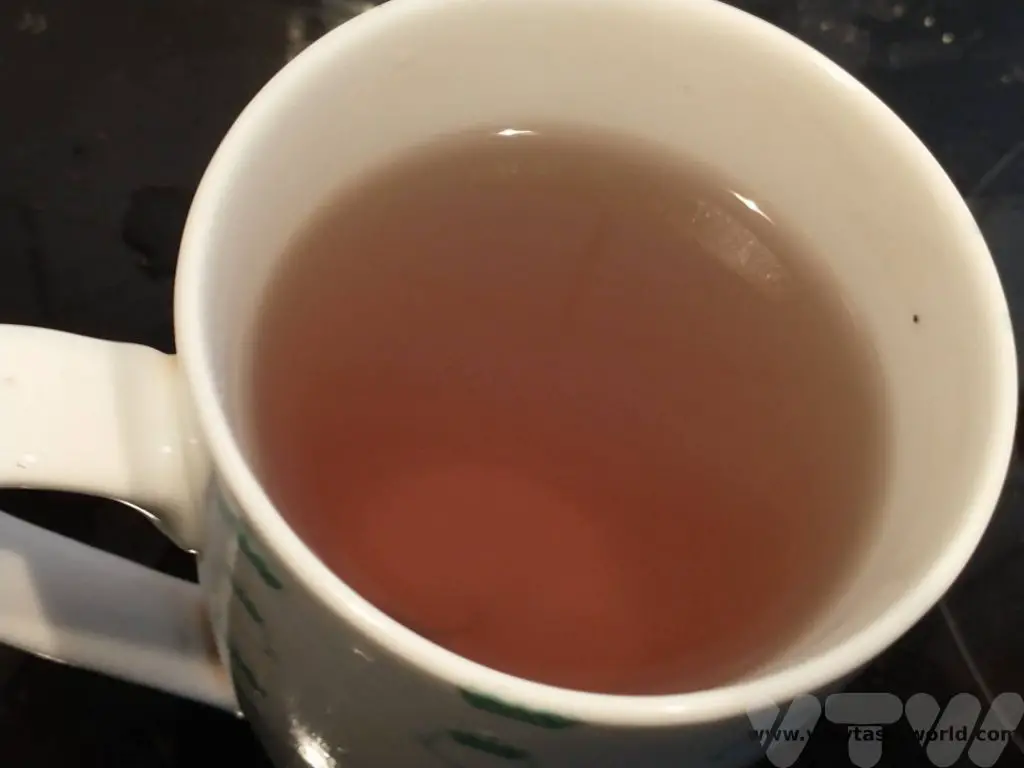
Stinging Nettle Hummus Recipe
Ingredients
Bowl of blanched stinging nettles
1 can of chickpeas, drained (if you’re keen to avoid food waste, you can keep the liquid, which is called aquafaba, which can be used to make vegan meringues)
1 large or 2 small cloves of garlic
Juice of 1 lemon
1 dsp peanut butter (you can substitute tahini, or omit completely if you can’t eat nuts)
Slosh of olive oil
Pinch of sea salt
Method
In a food processor or blender, combine the lemon juice, garlic and peanut butter. Give them a whizz.
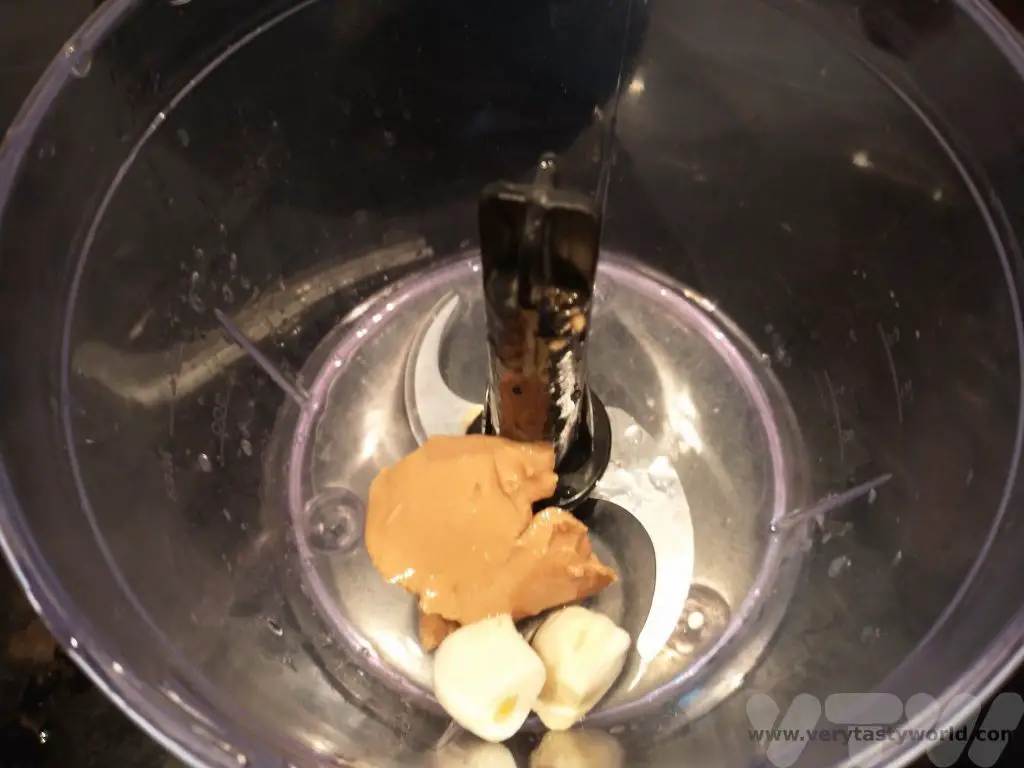
Add half the chickpeas and half the nettles with a slosh of oil and blend again.
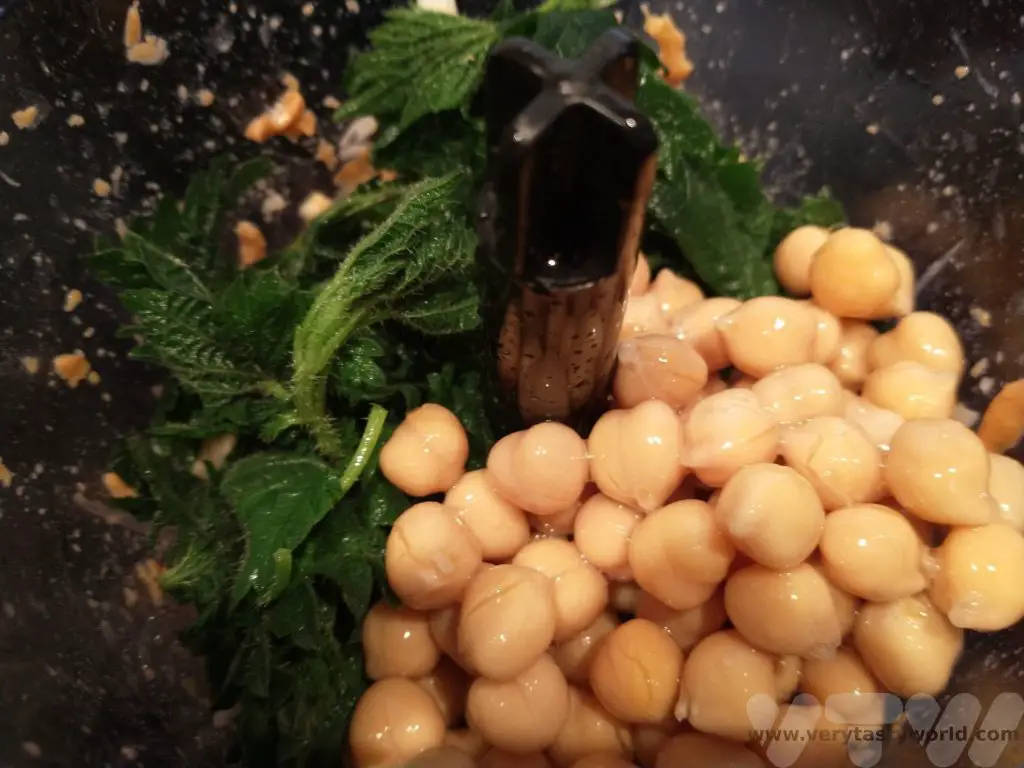
Scrape the sides of the bowl. Add the remaining nettles, chickpeas and a pinch of salt, and blend again.
Have a taste – does it need more lemon or salt? Add seasoning as necessary. We tend to like sour flavours so added the juice of an extra half lemon. You can decide how much you would like your blend depending on whether you prefer a smooth or chunkier texture.
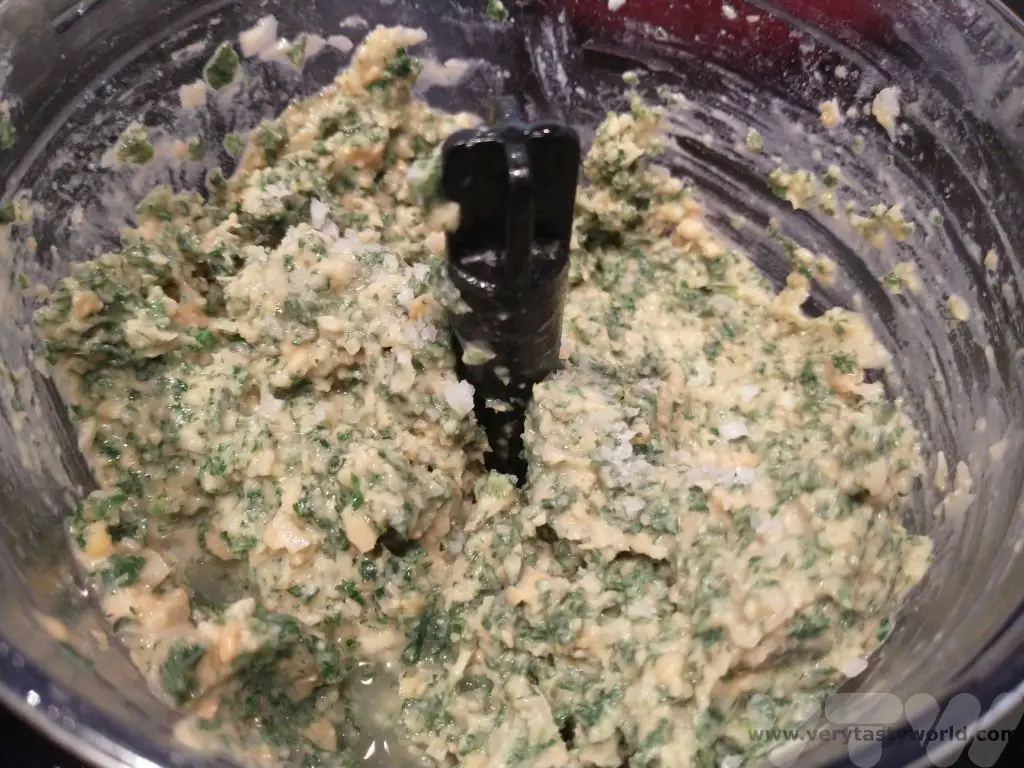
Decant into a bowl and serve with warm pitta bread.
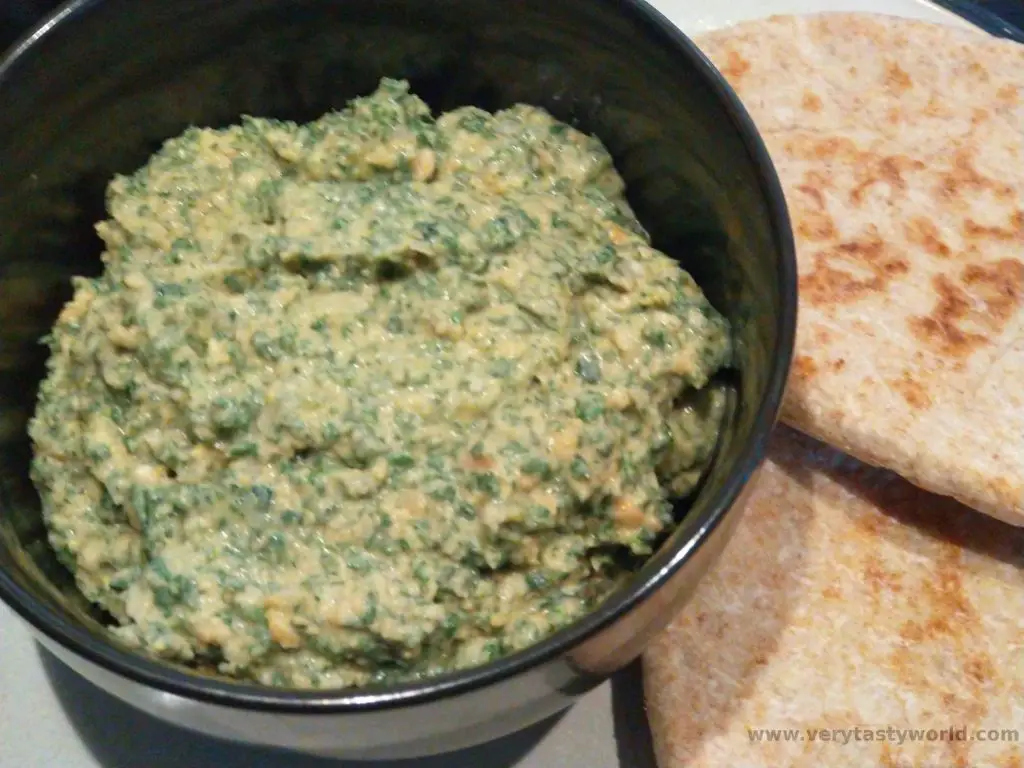
Related Posts You May Enjoy

- RECIPE Oyakodon Donburi
- Zero Waste Recipes Before Your Holiday
- RECIPE: Vegetable Biryani Tamil Nadu Style
- RECIPE: Vegan Wild Garlic Pesto
- Recipe: Venetian Pasta Sauce
- RECIPE: Biryani Raita Recipe
- RECIPE: How to Make Costa Rica’s Gallo Pinto
- Recipe: Japanese Simmered Pork Belly – Buta no Kakuni
- RECIPE: How to Make Umeboshi
